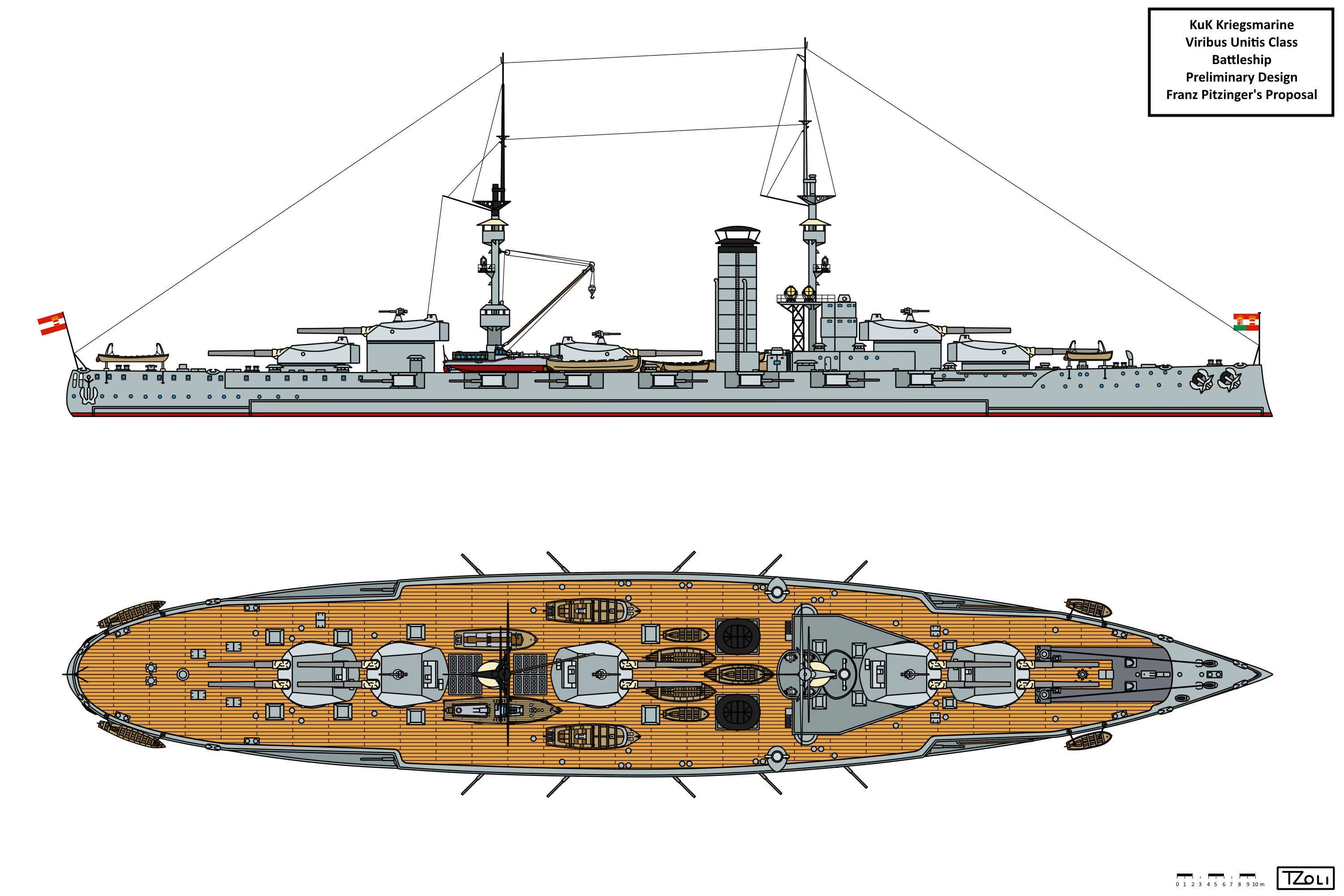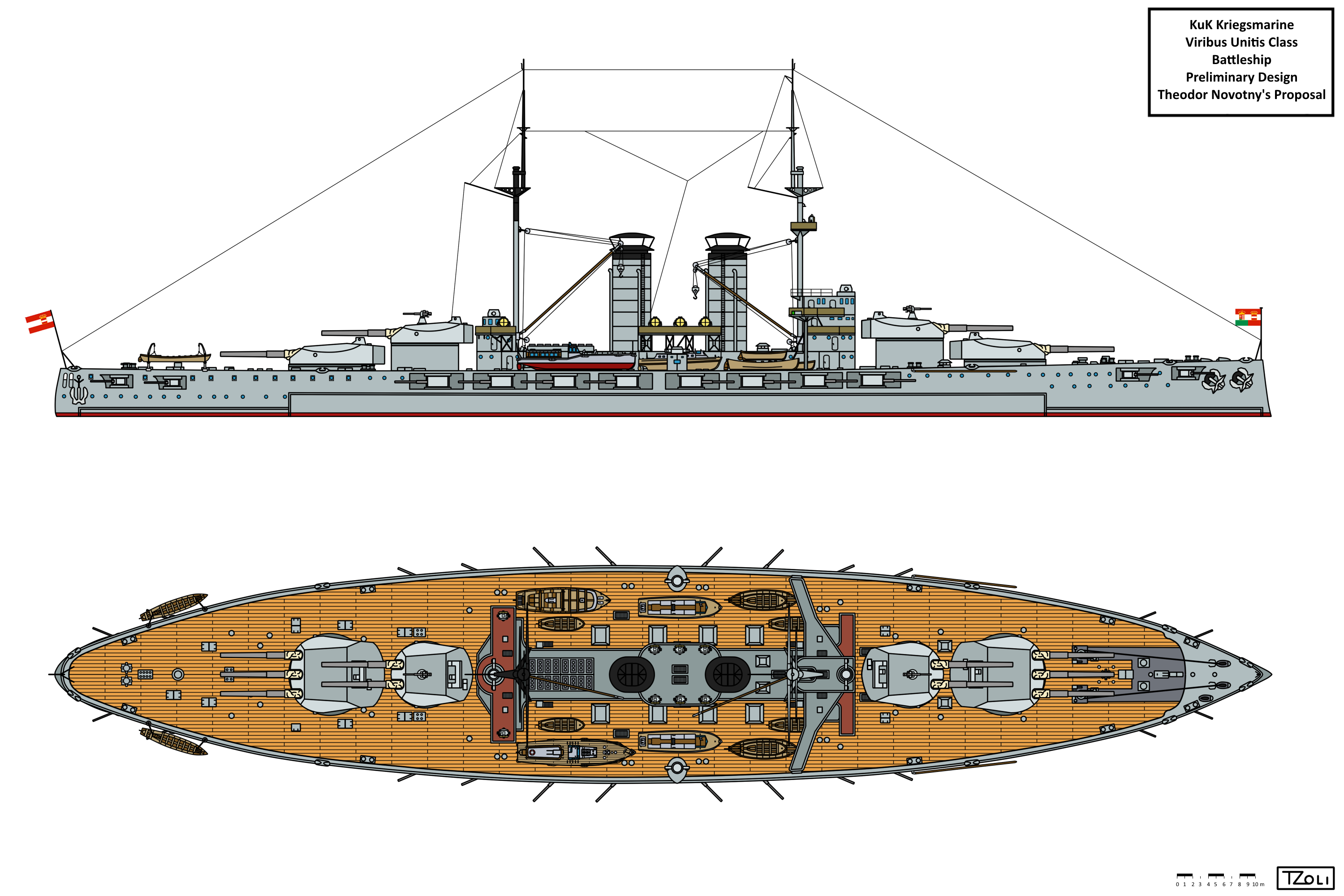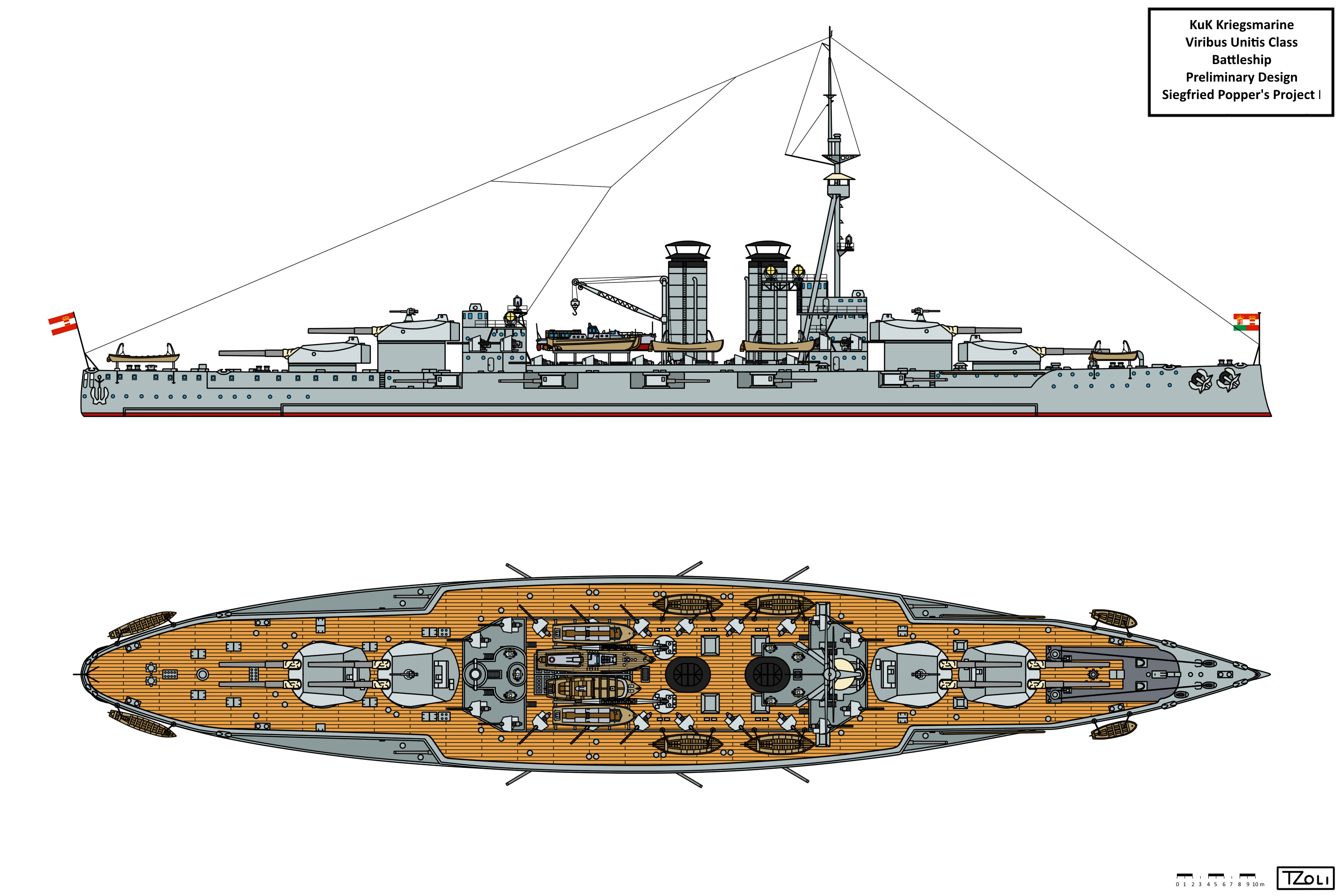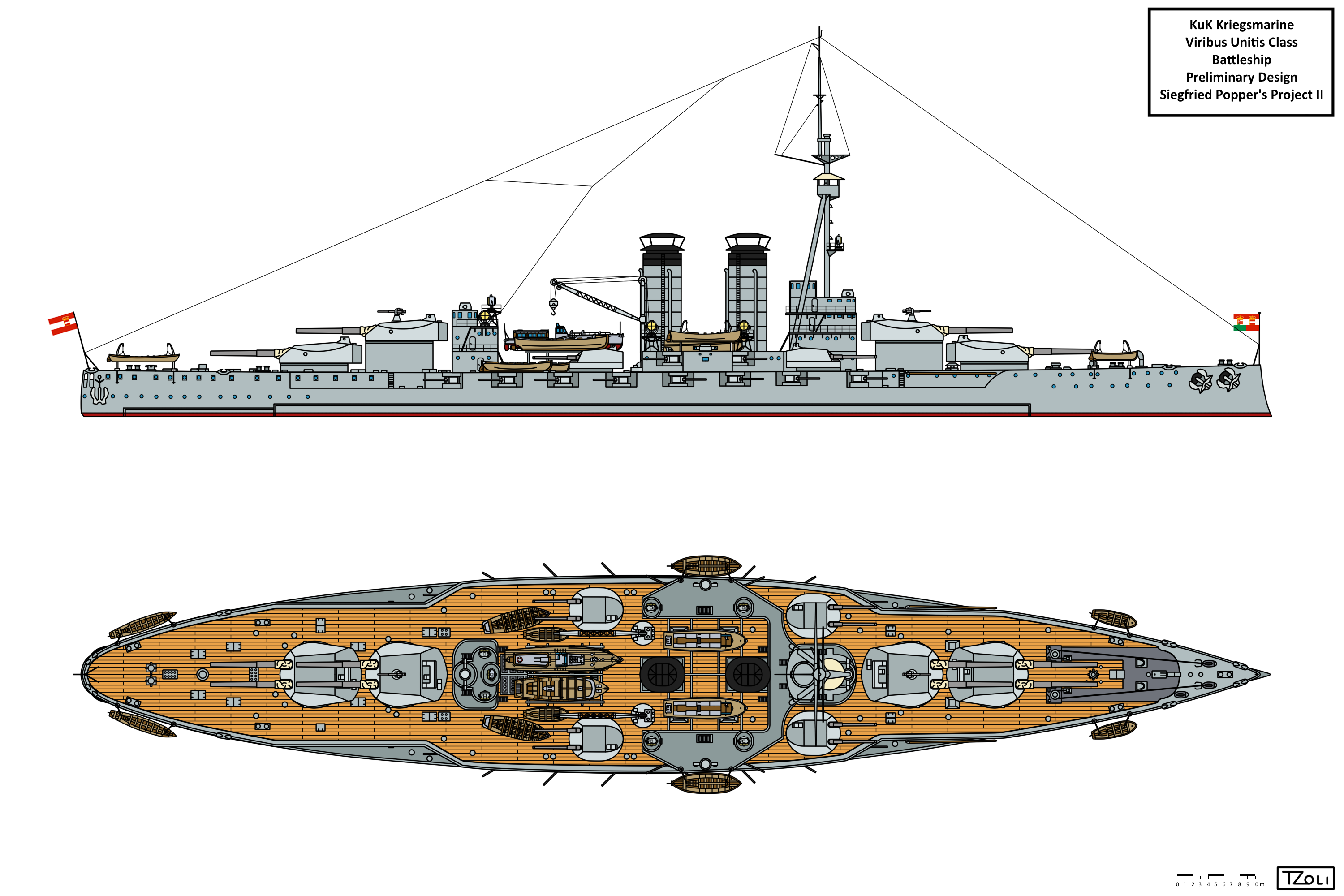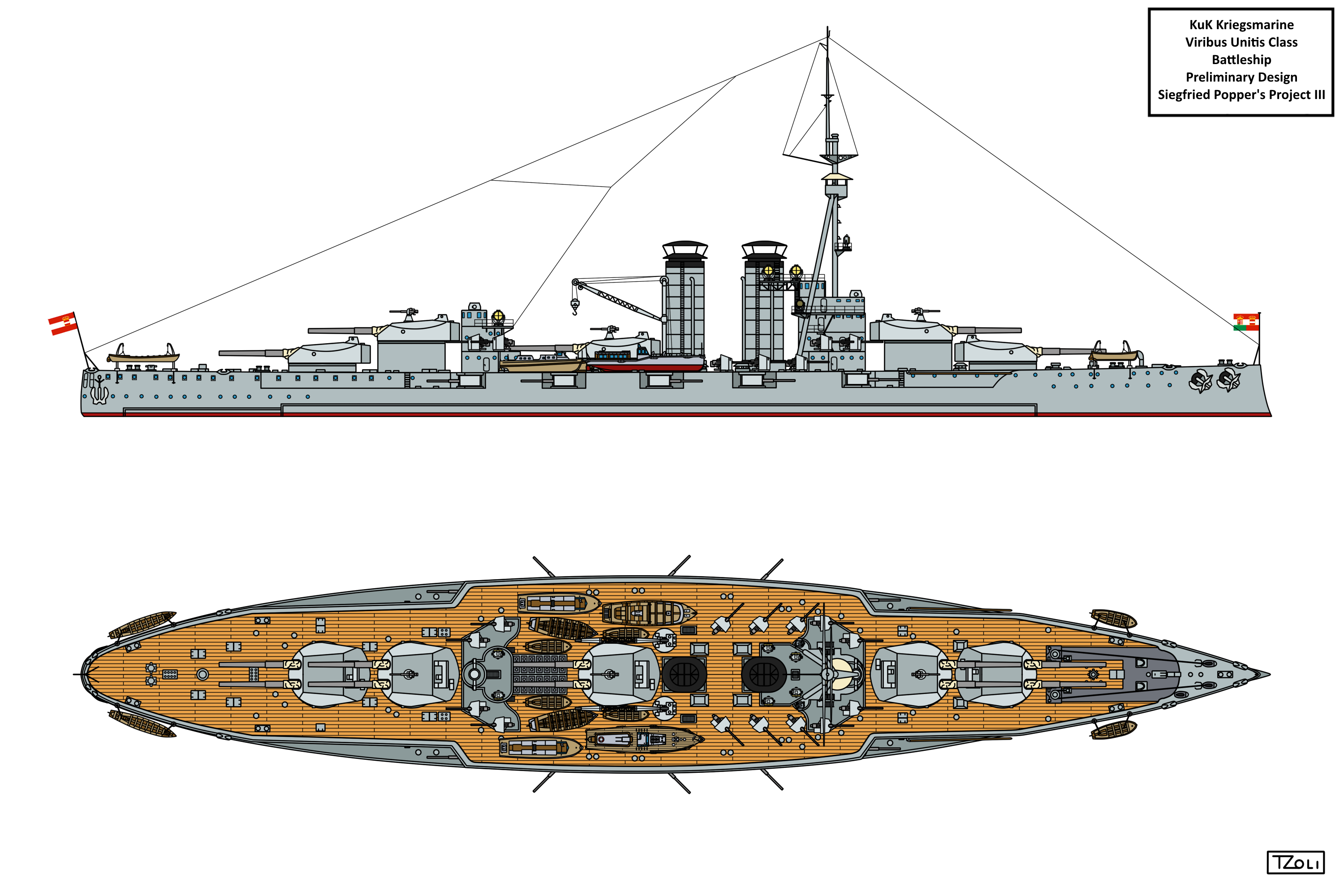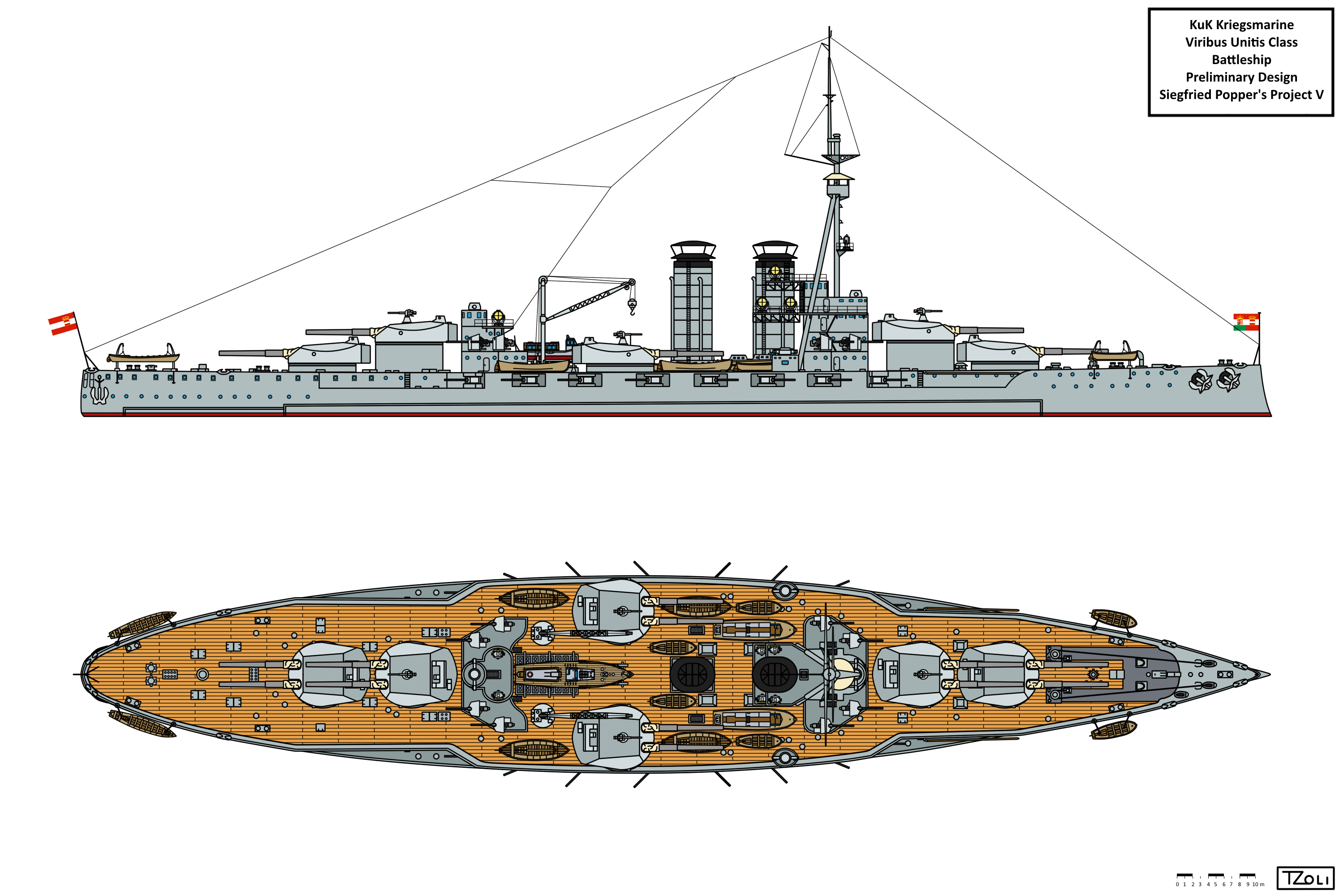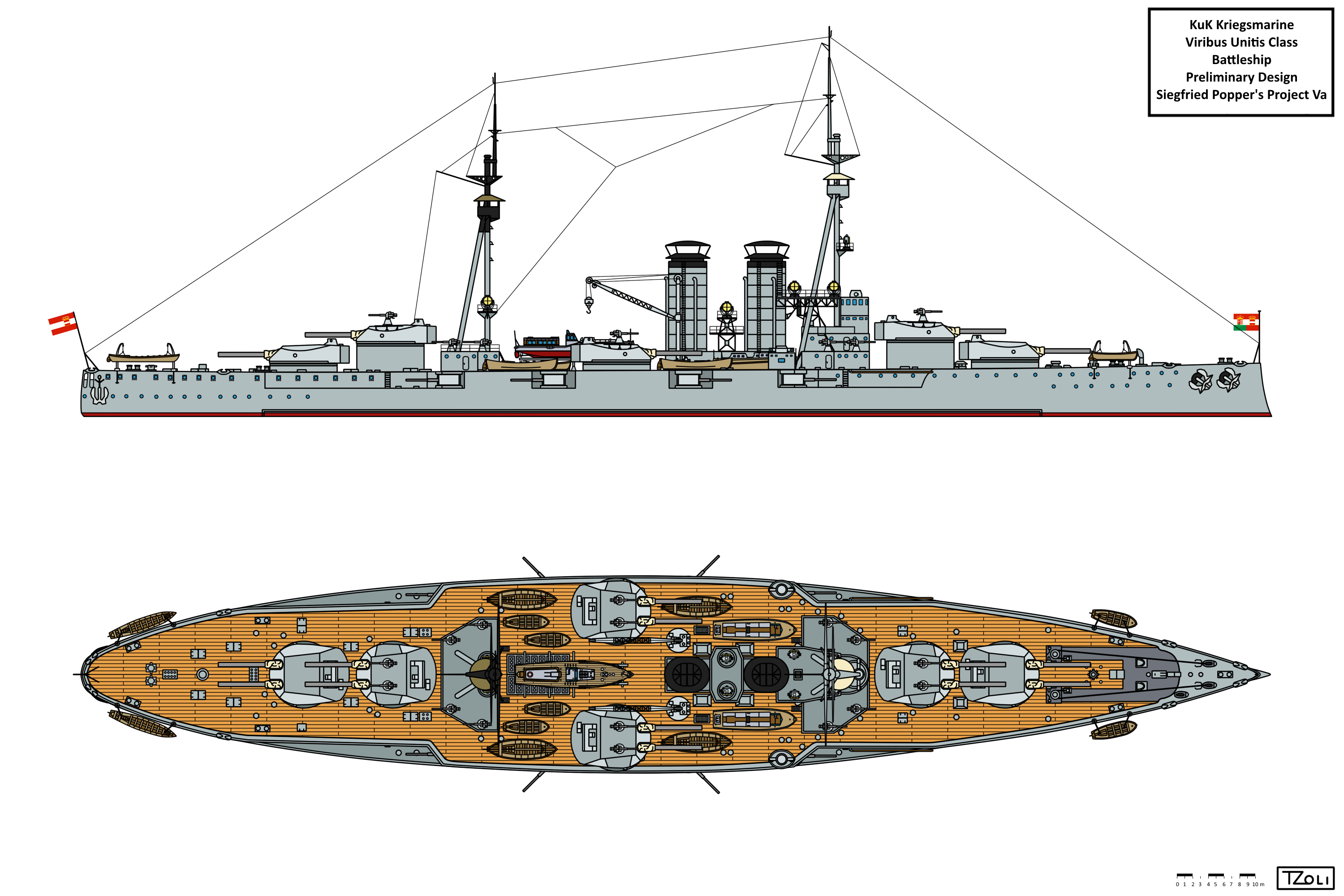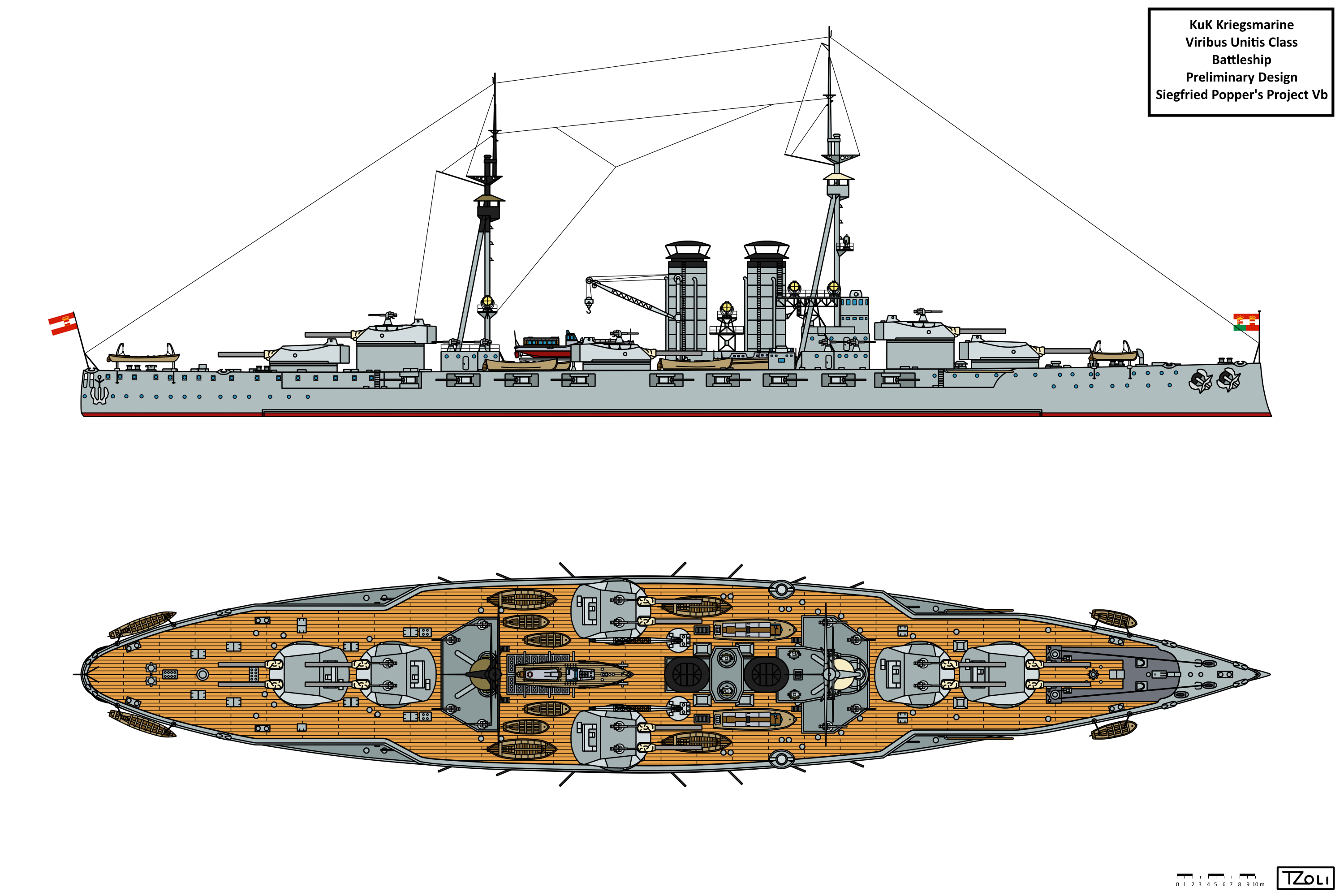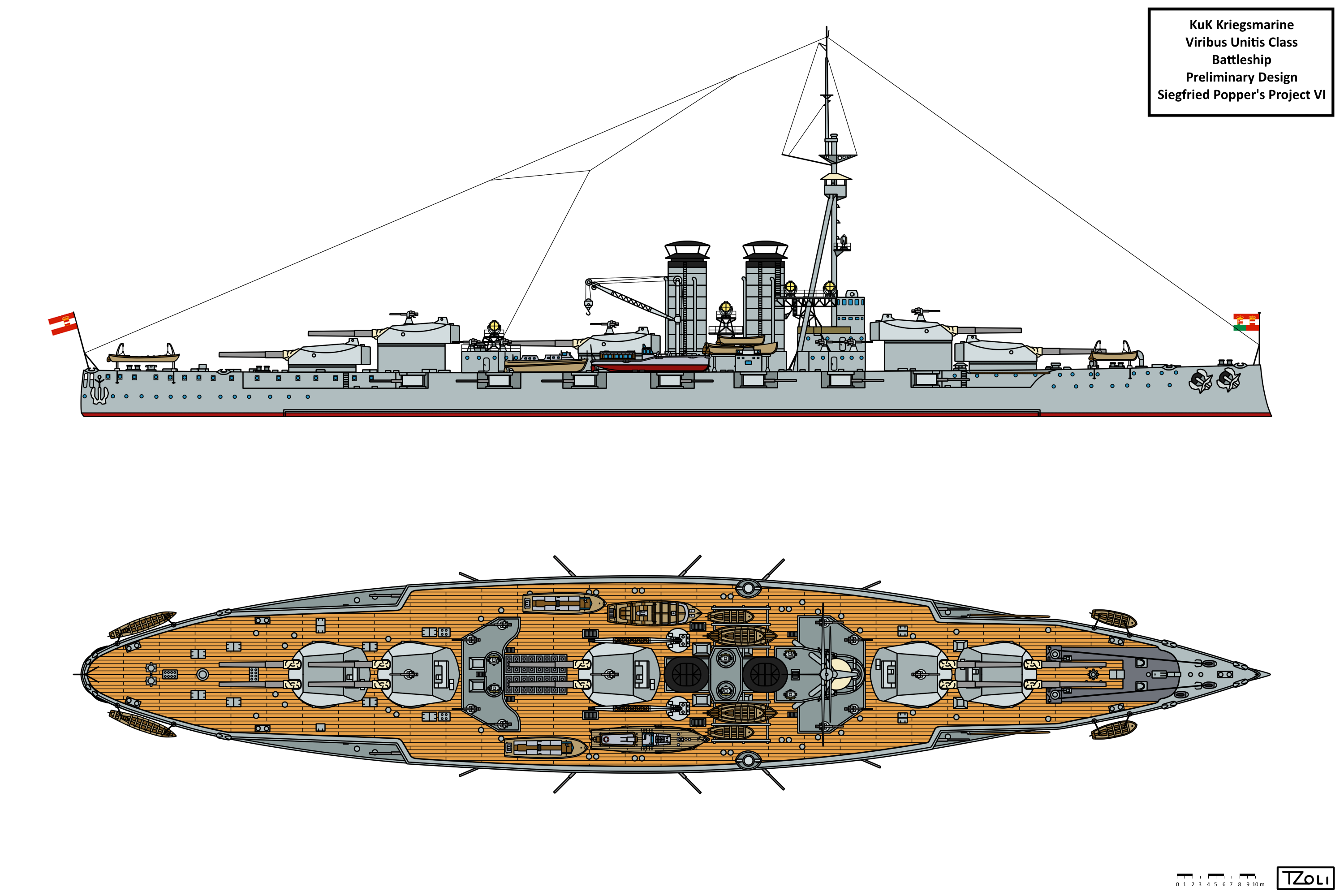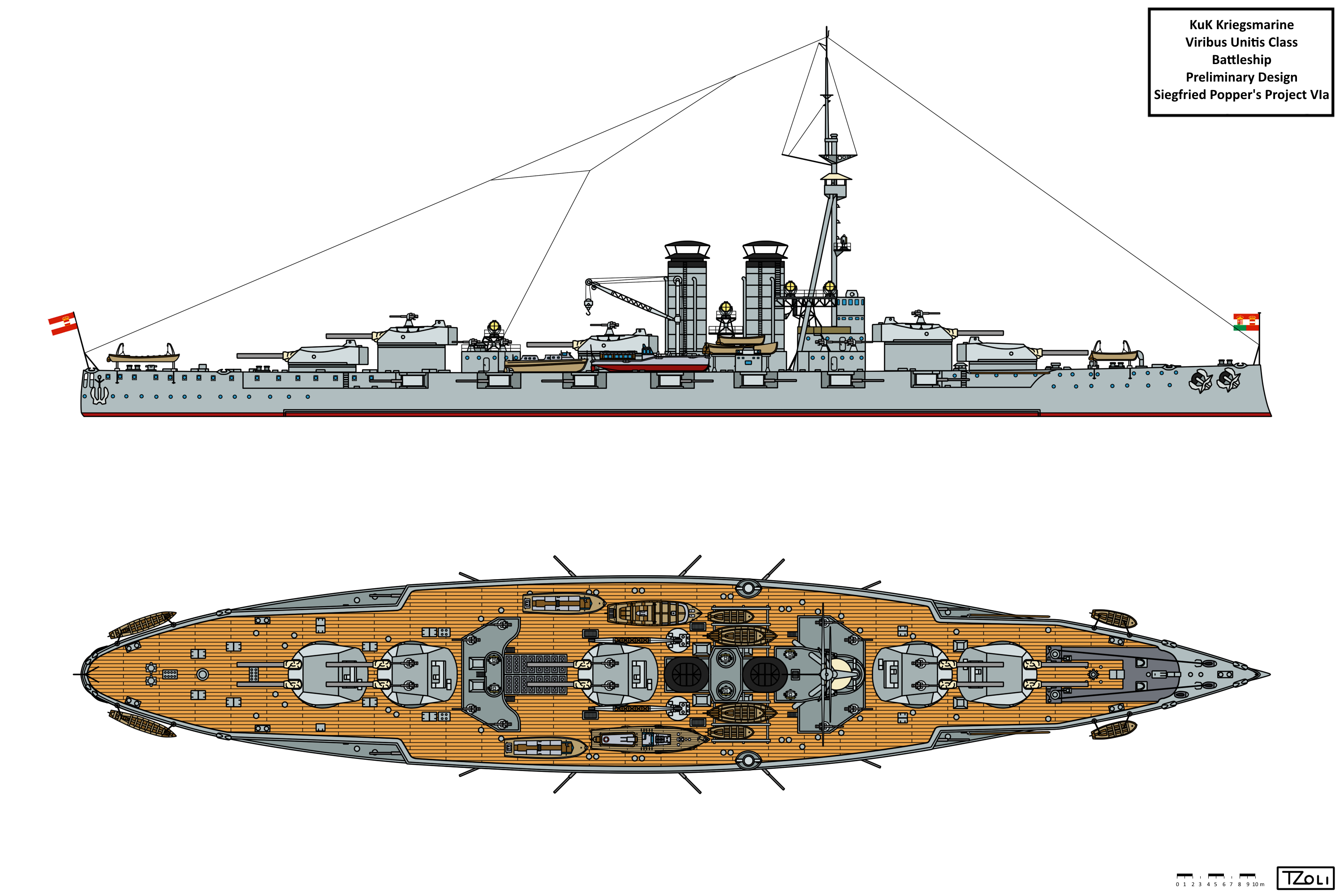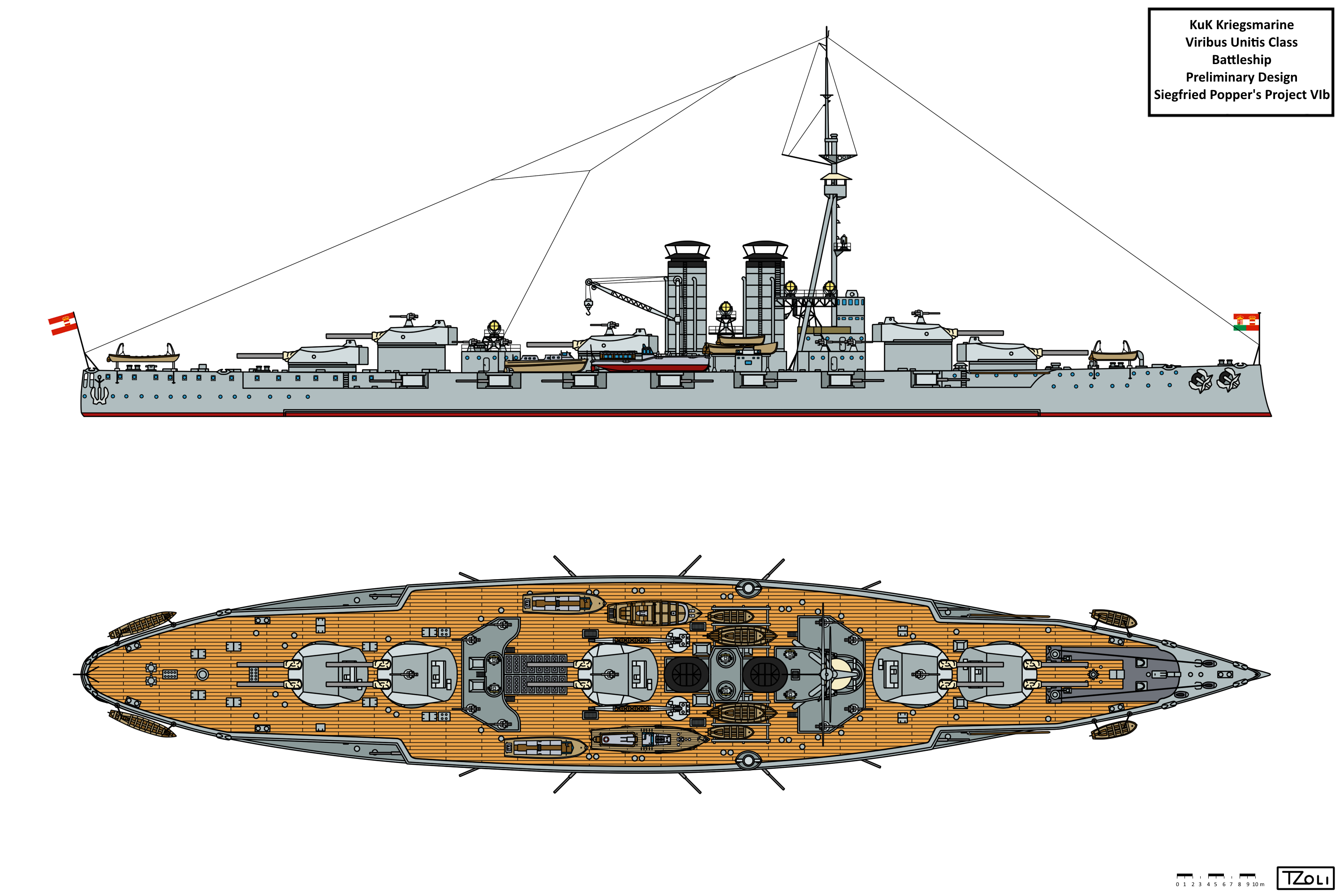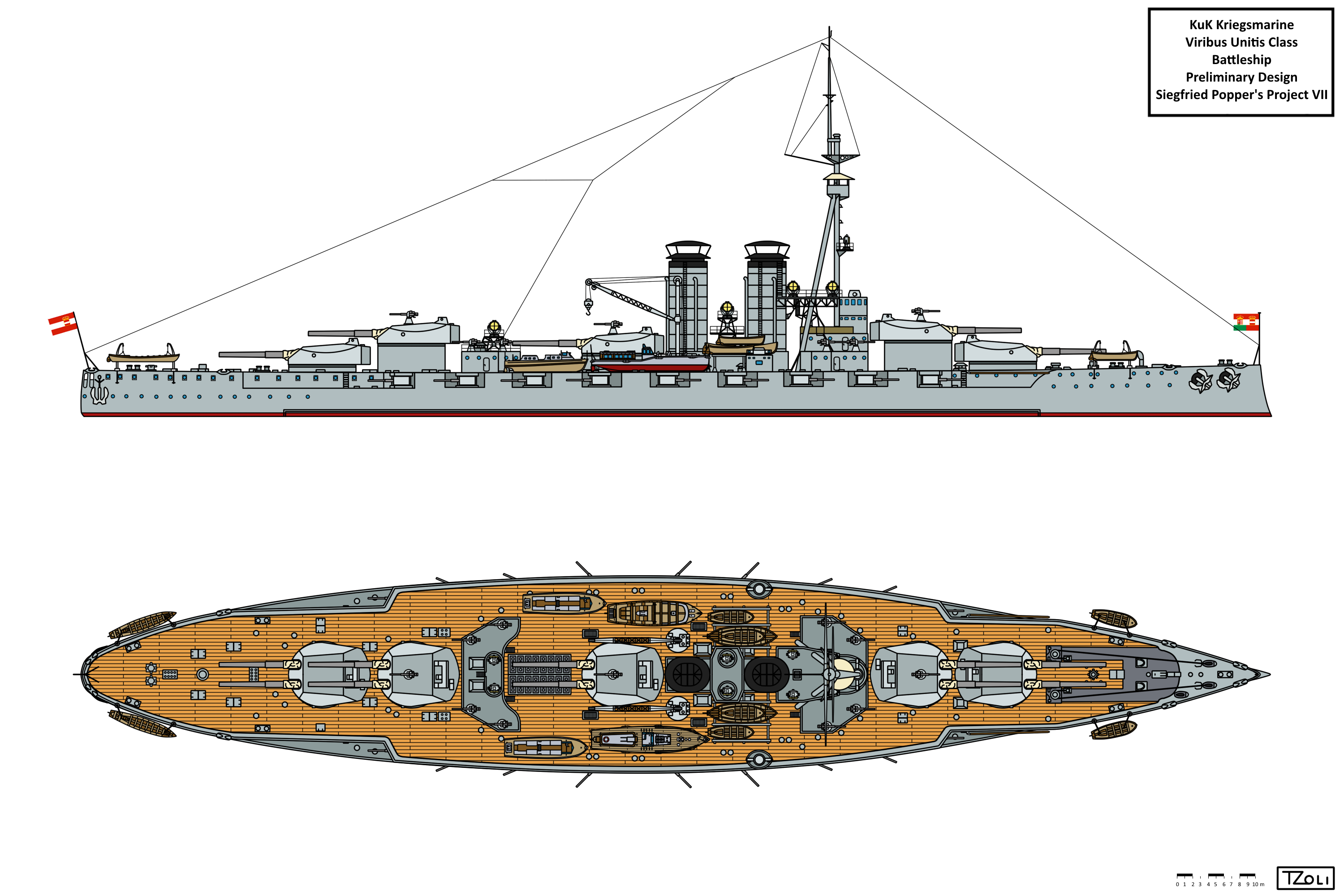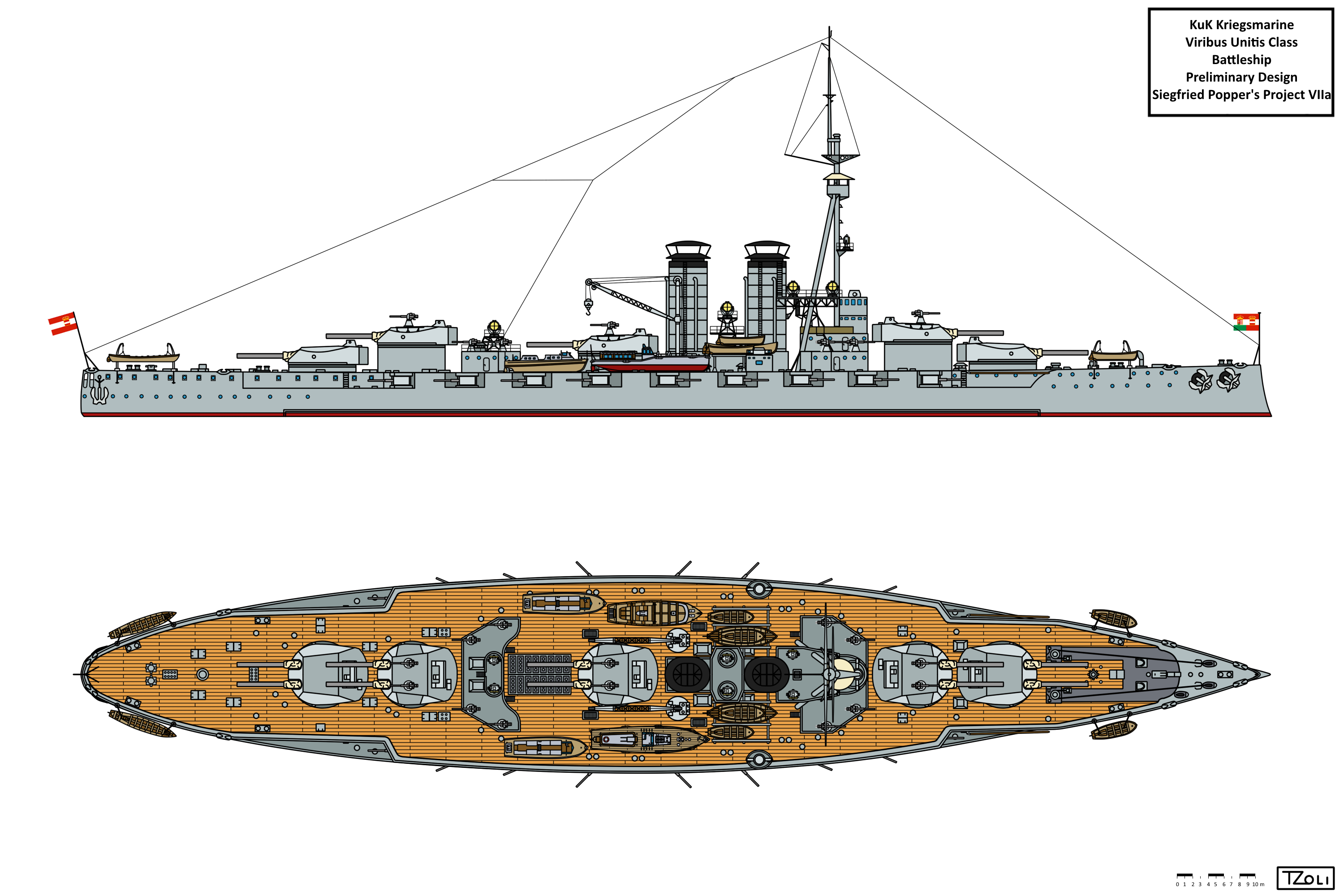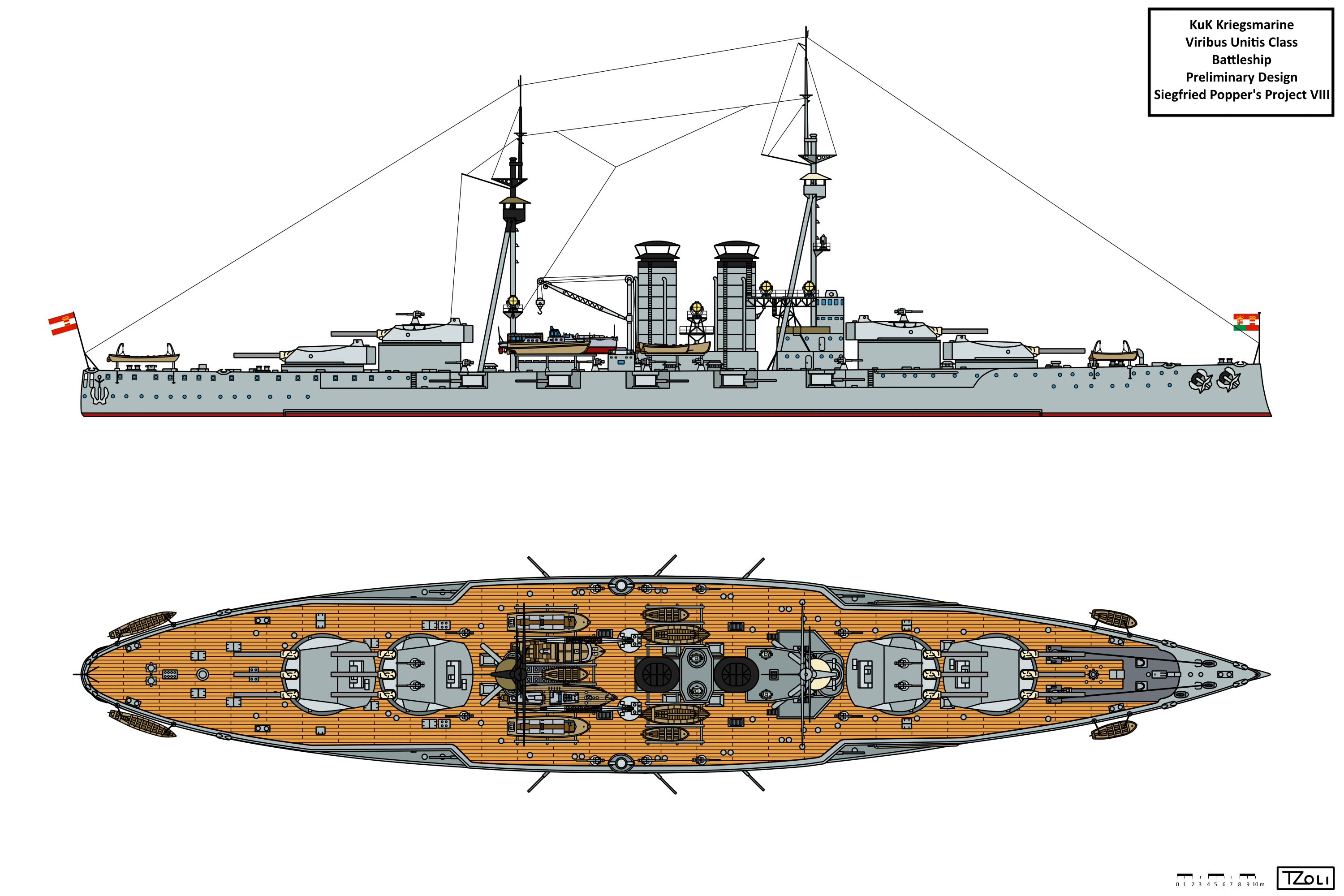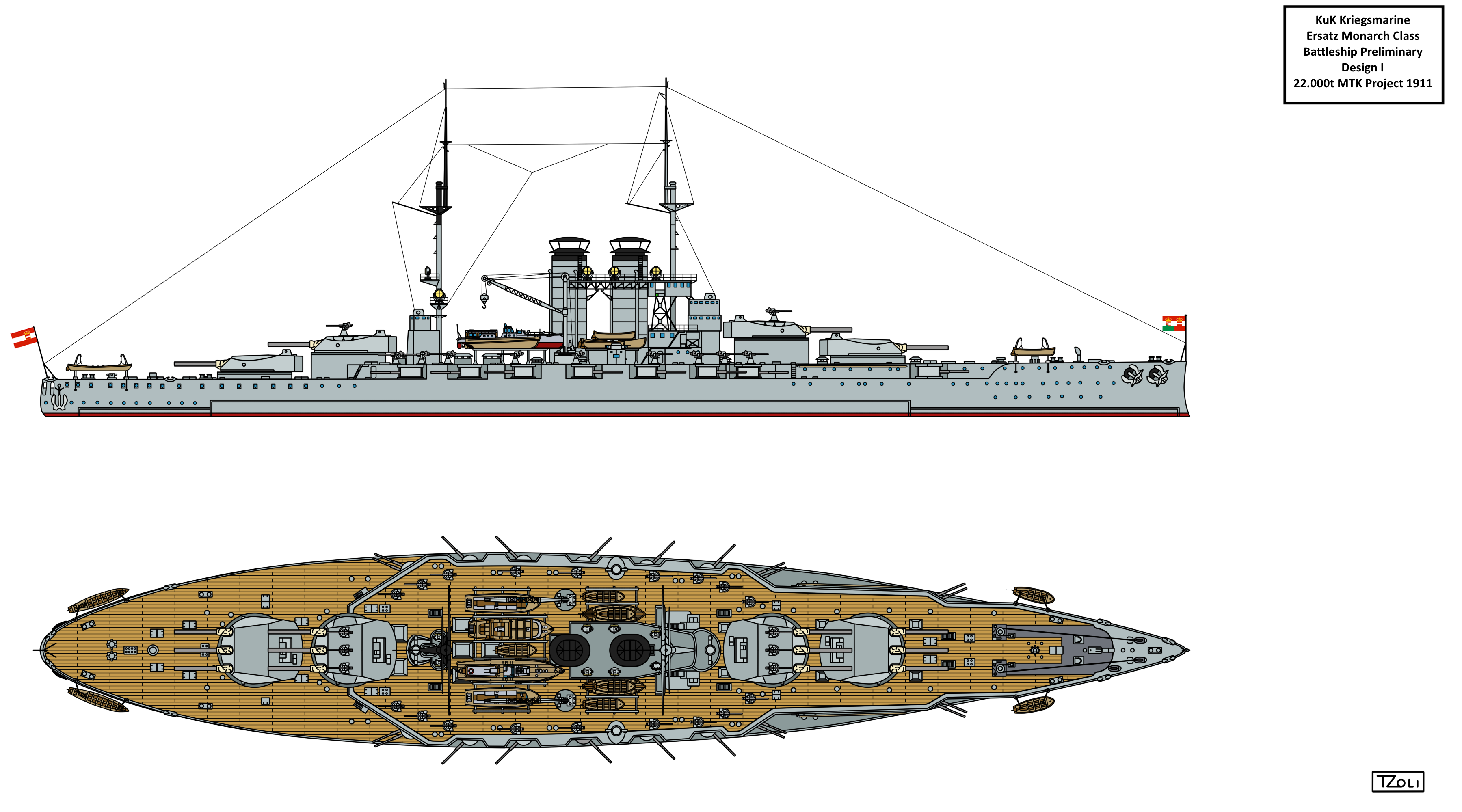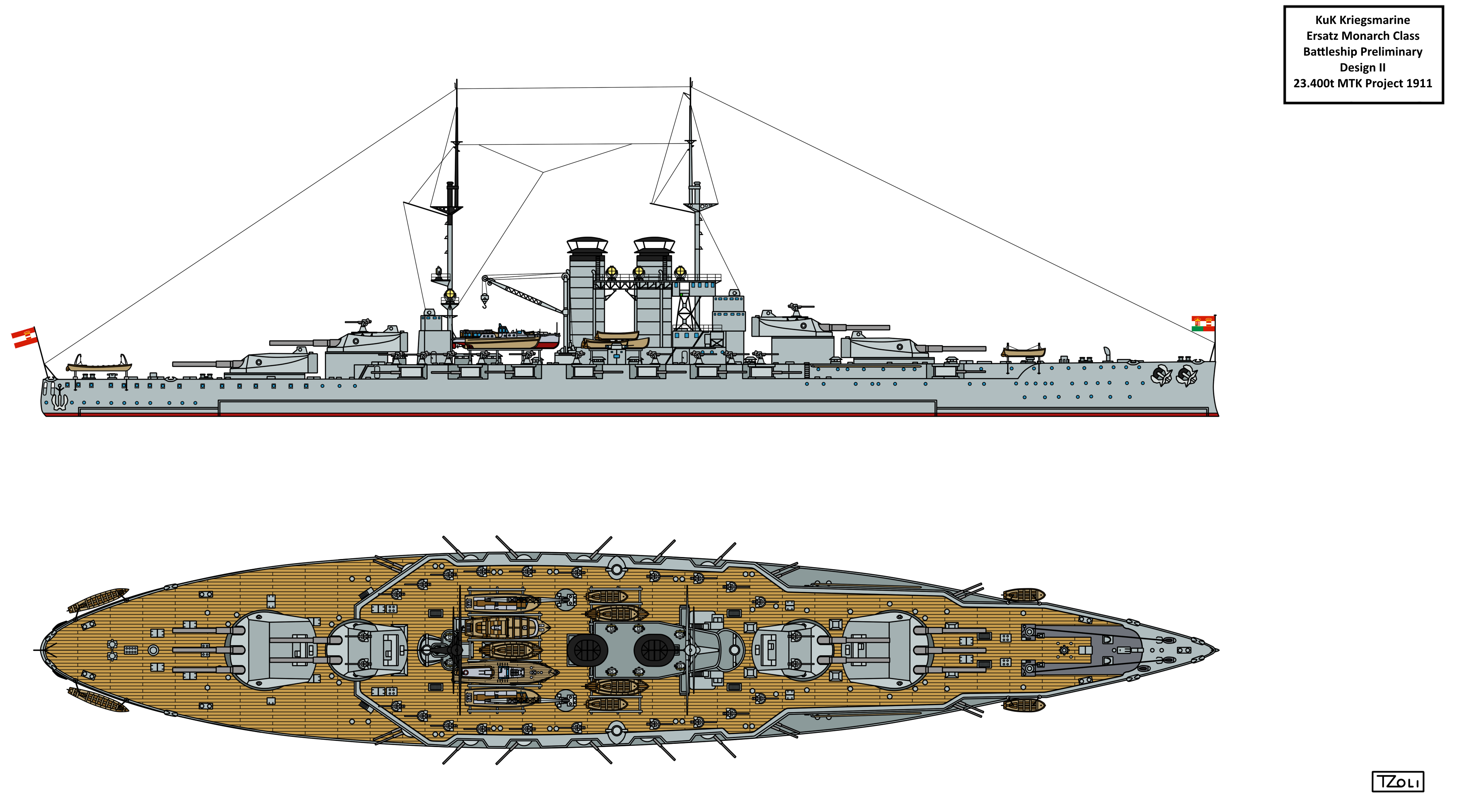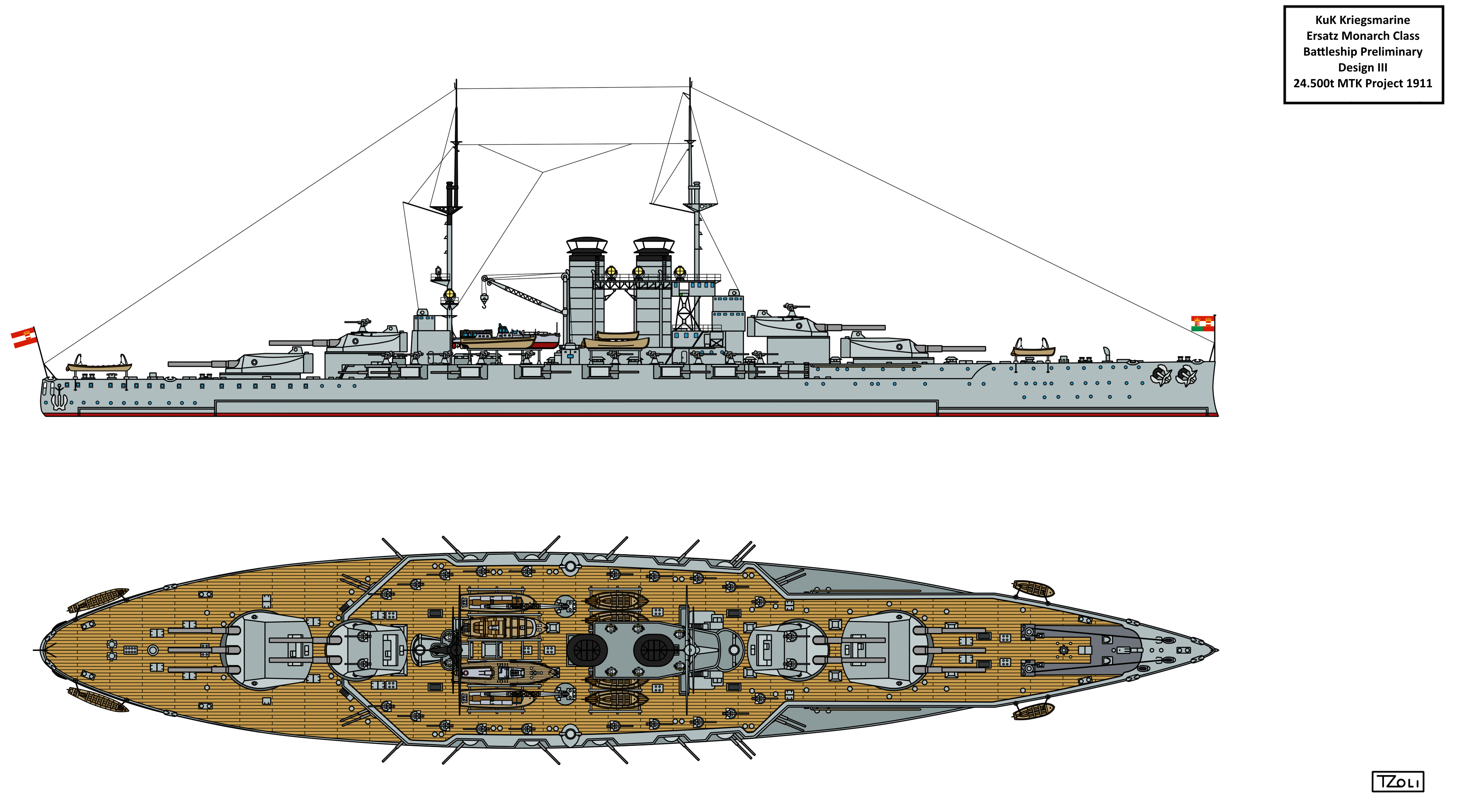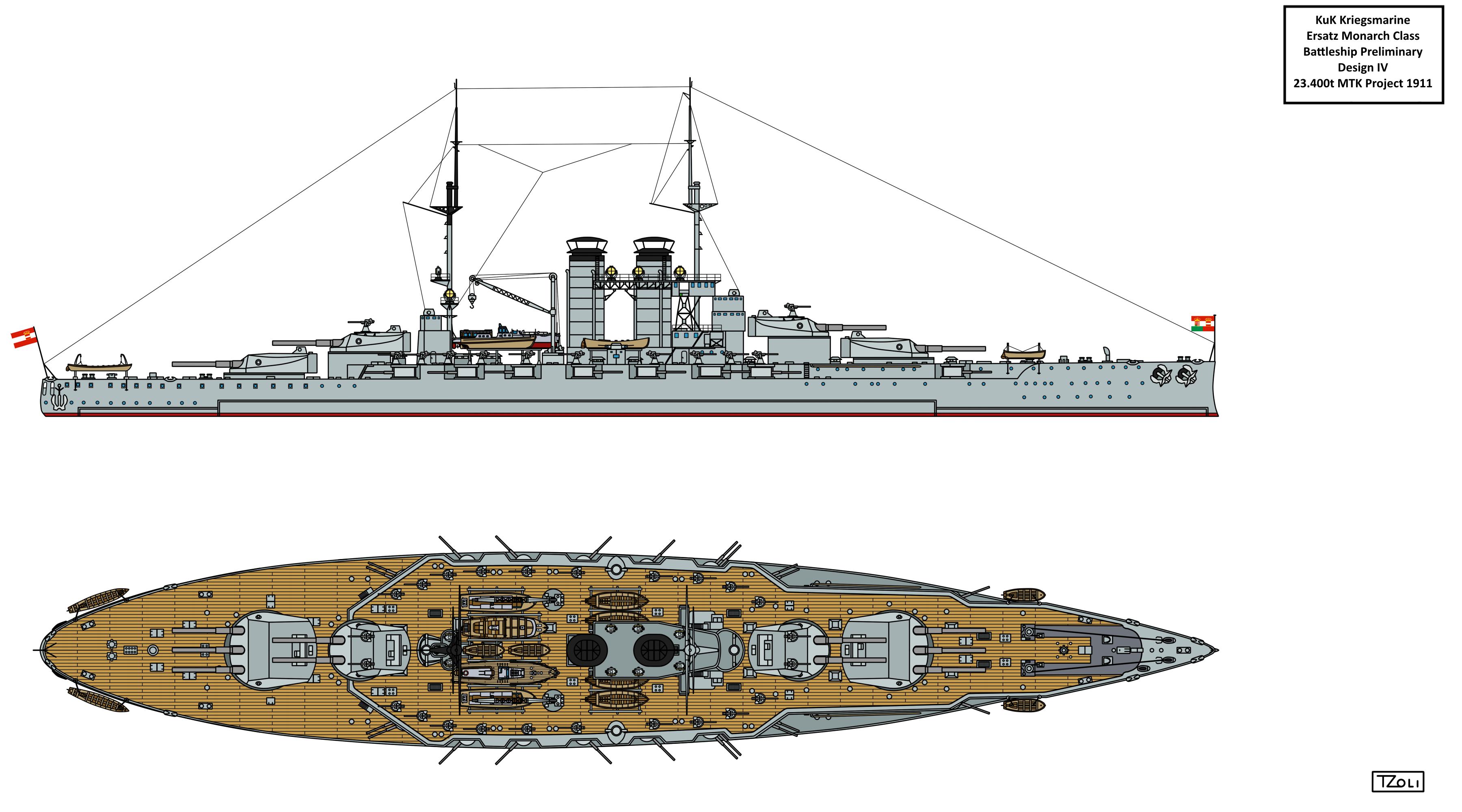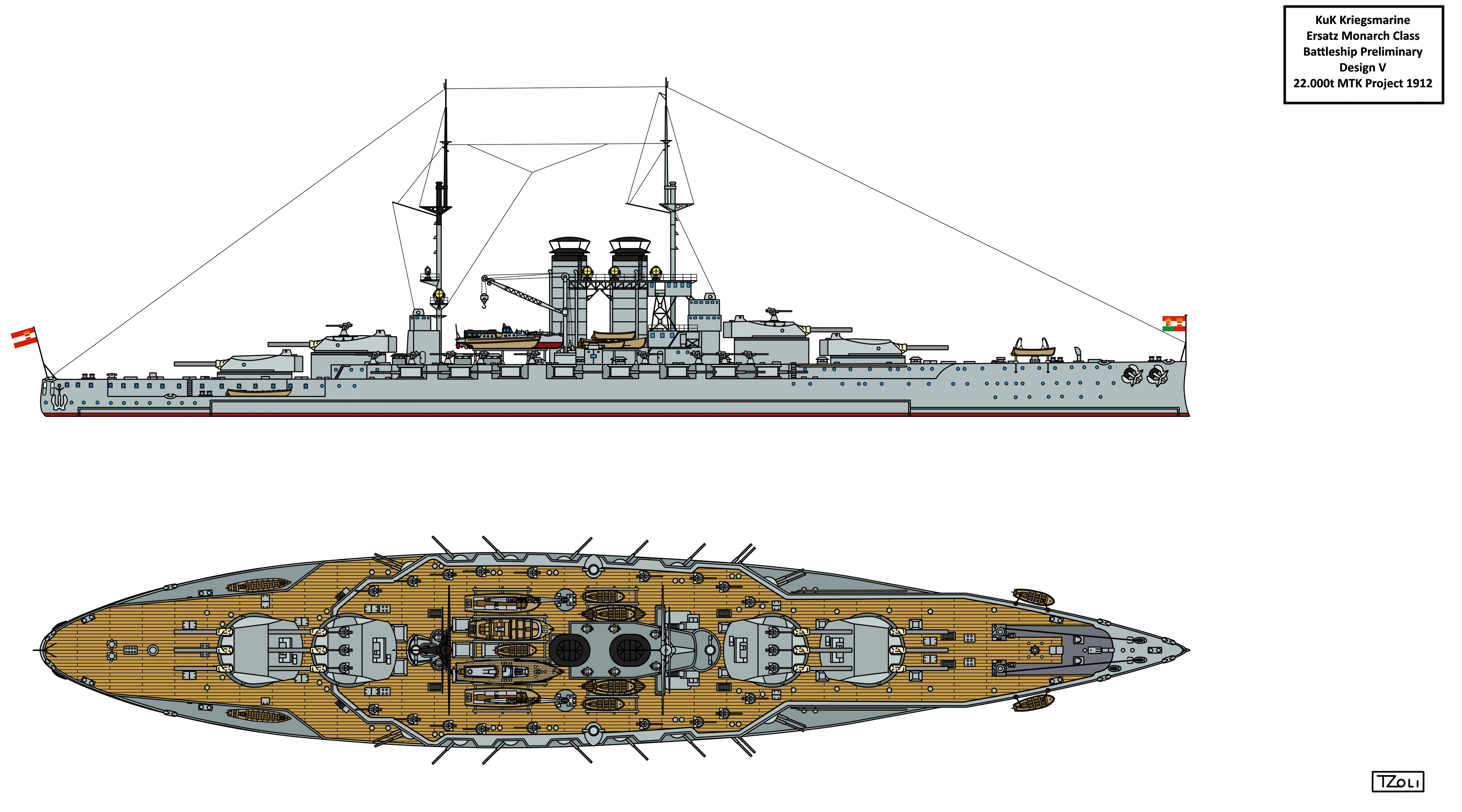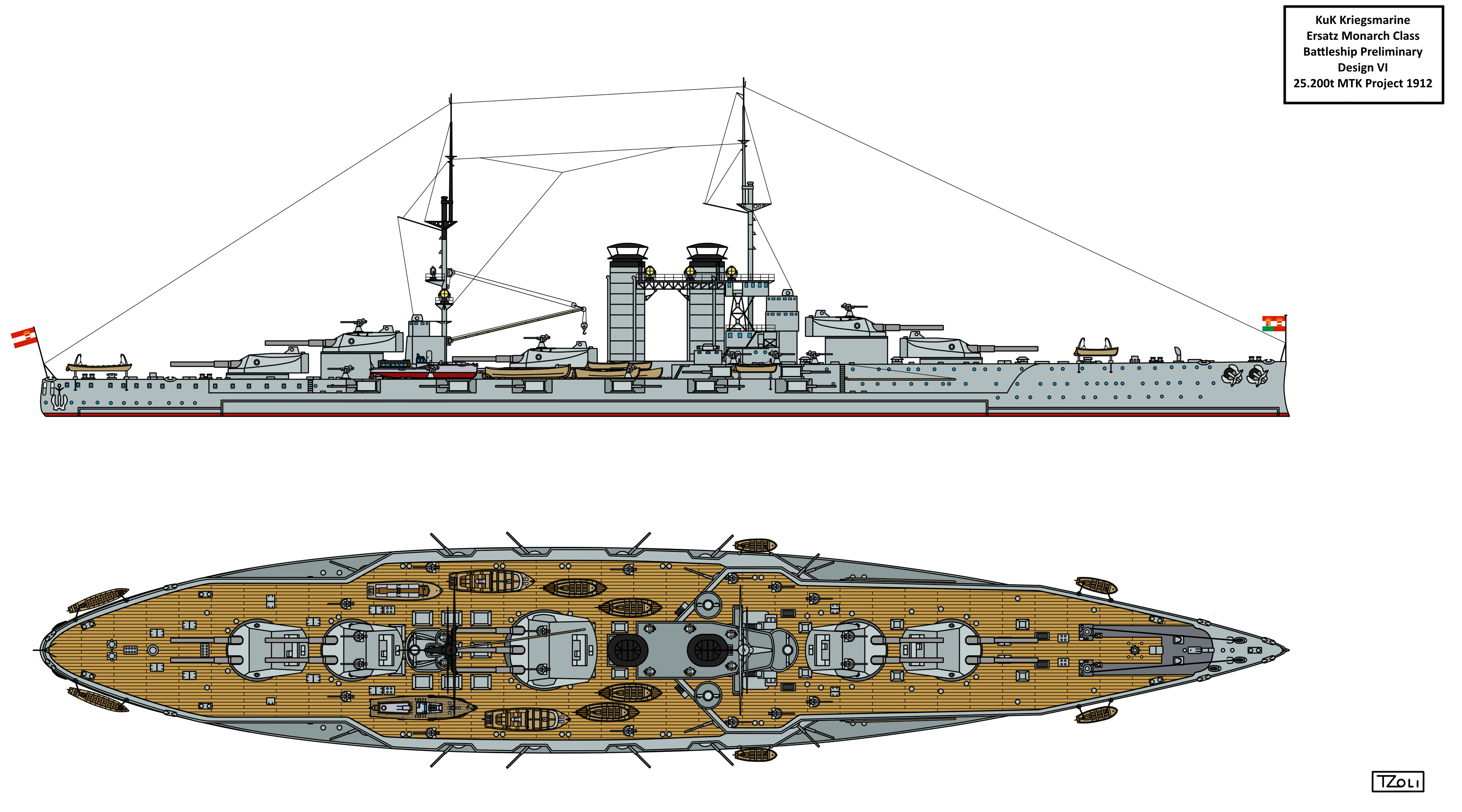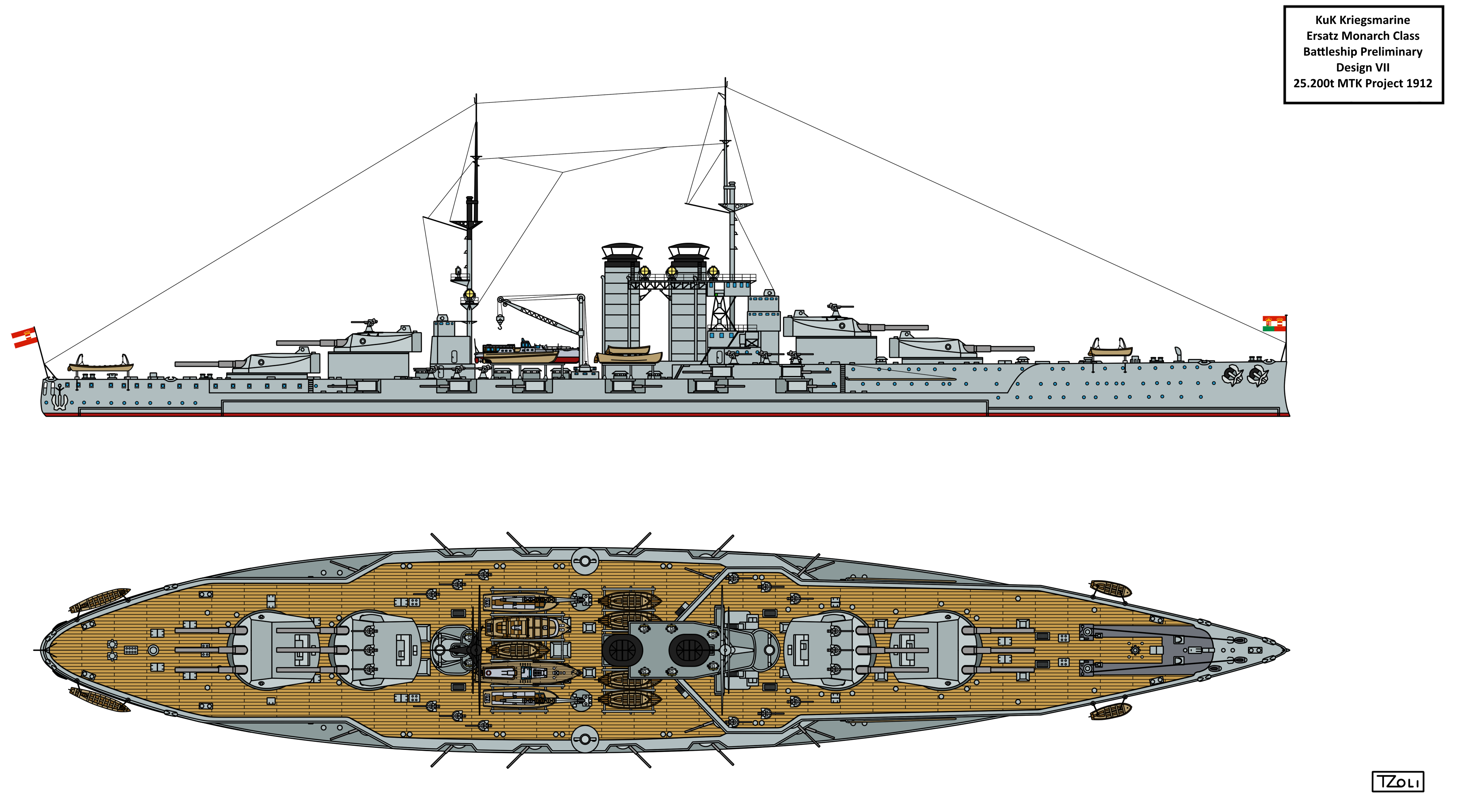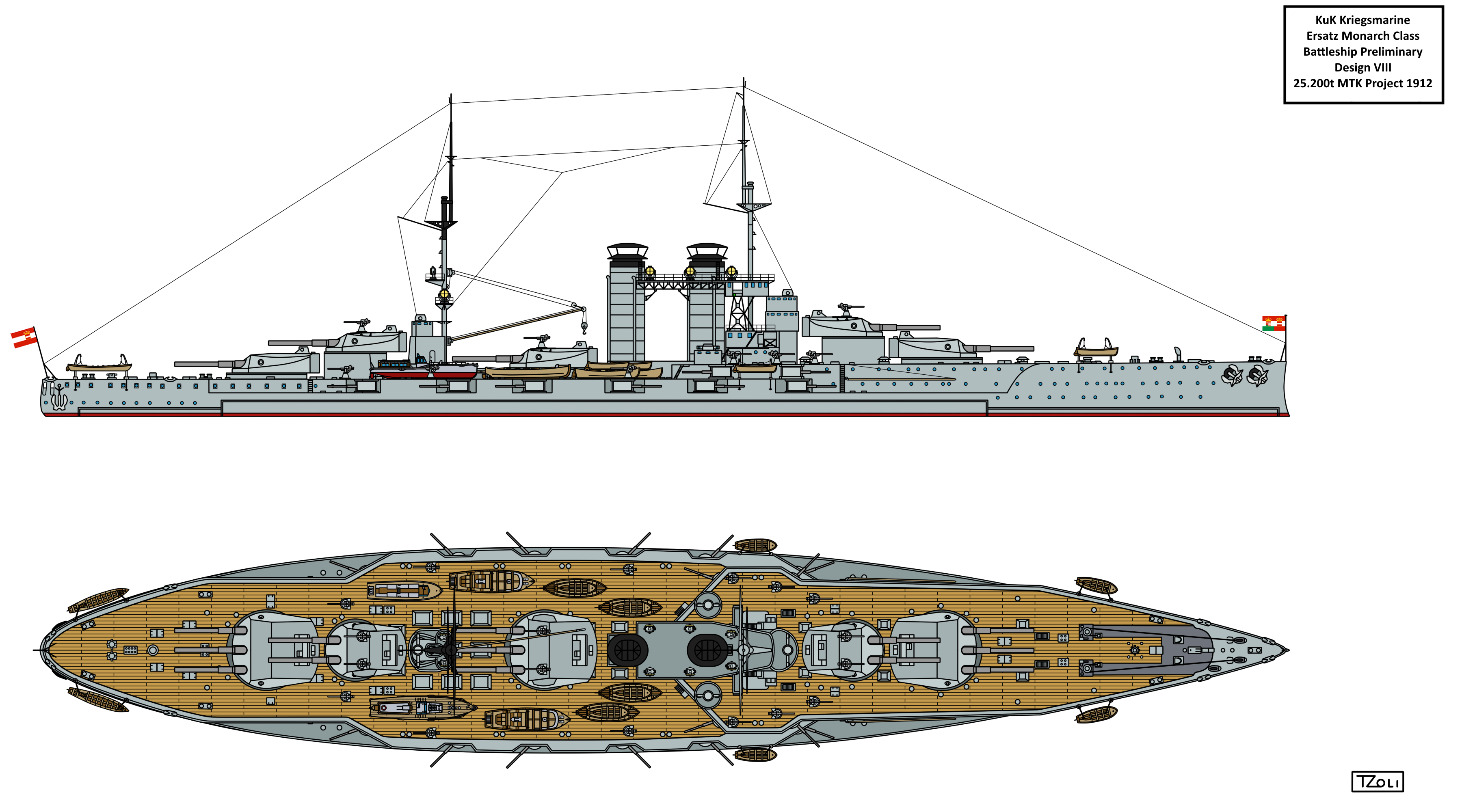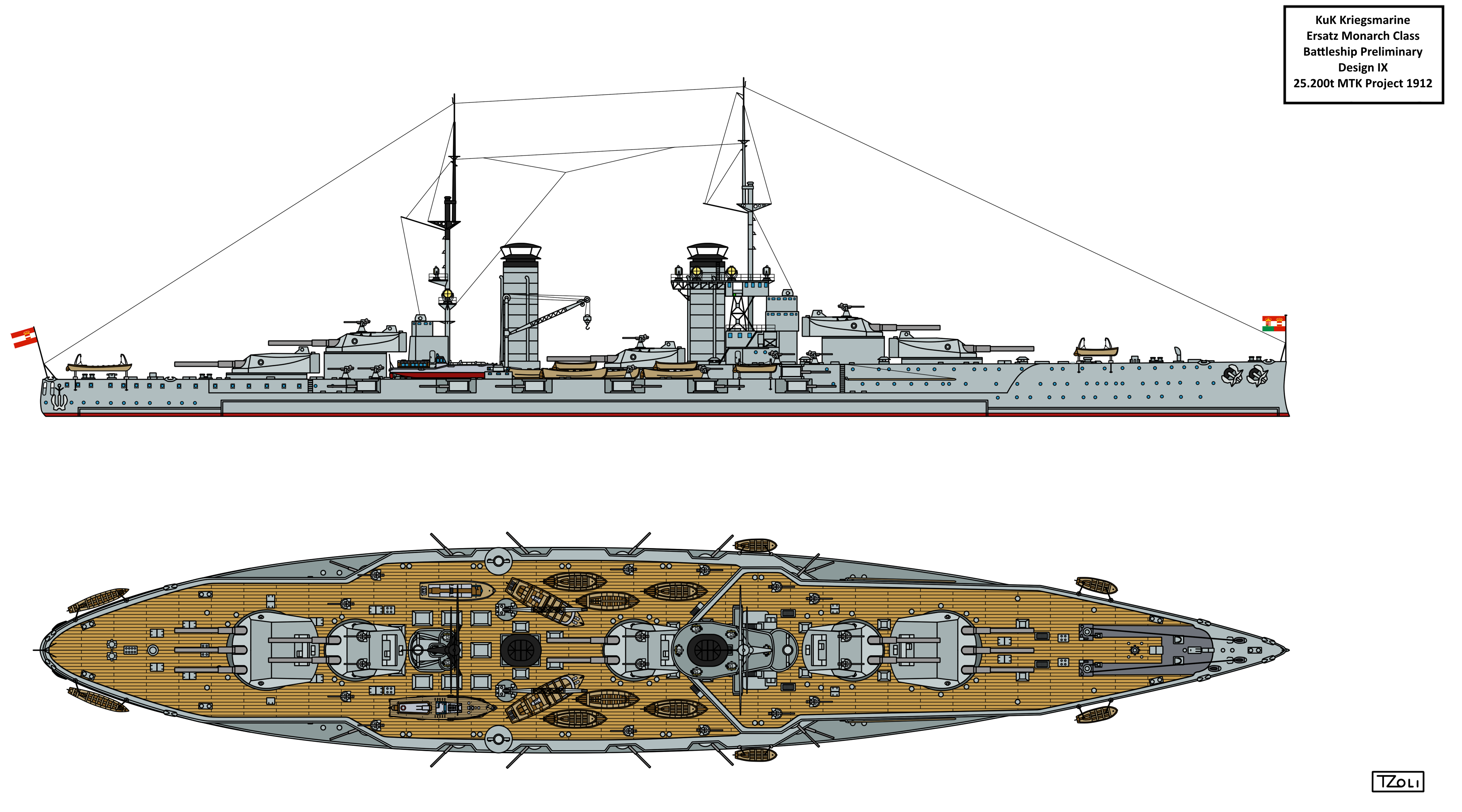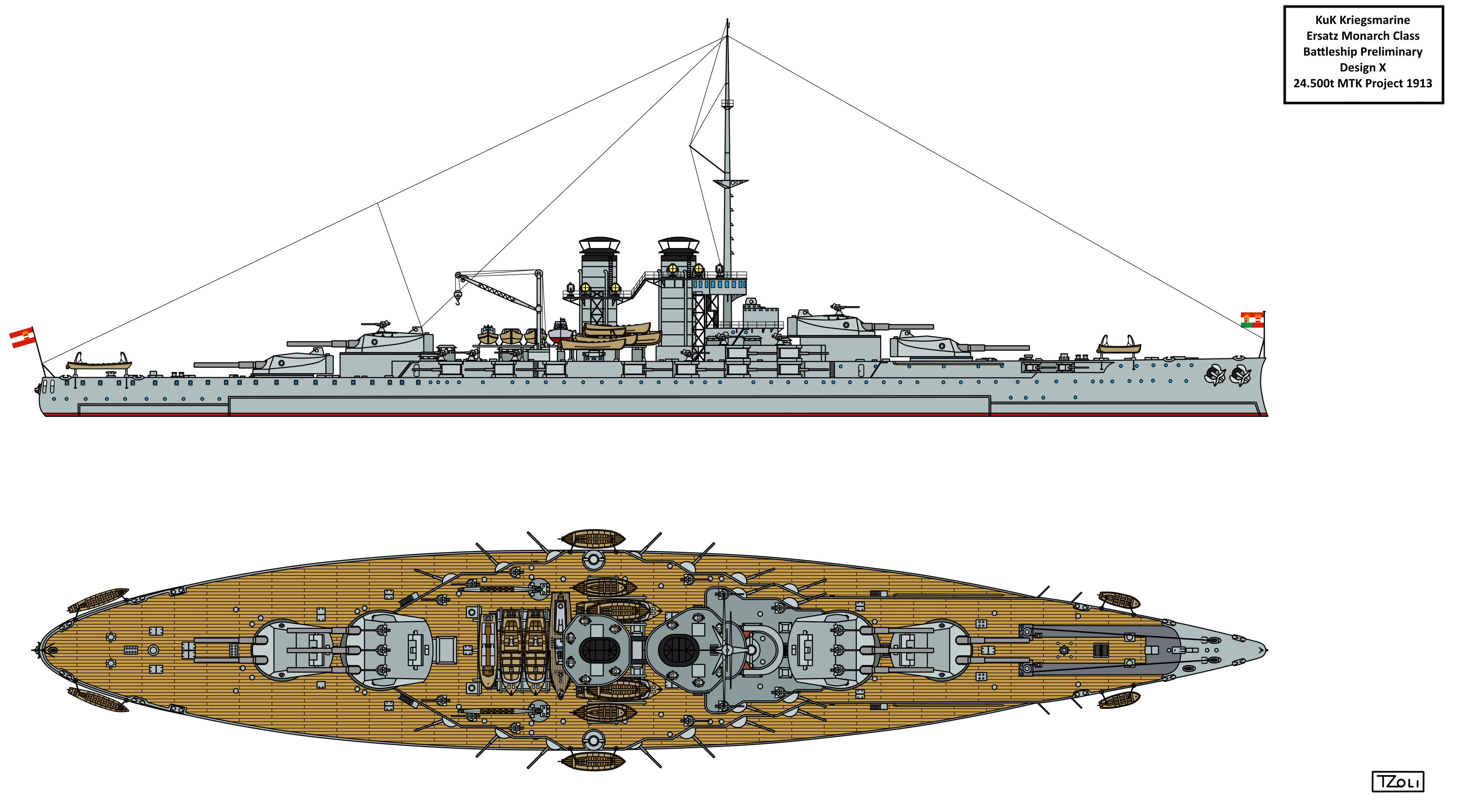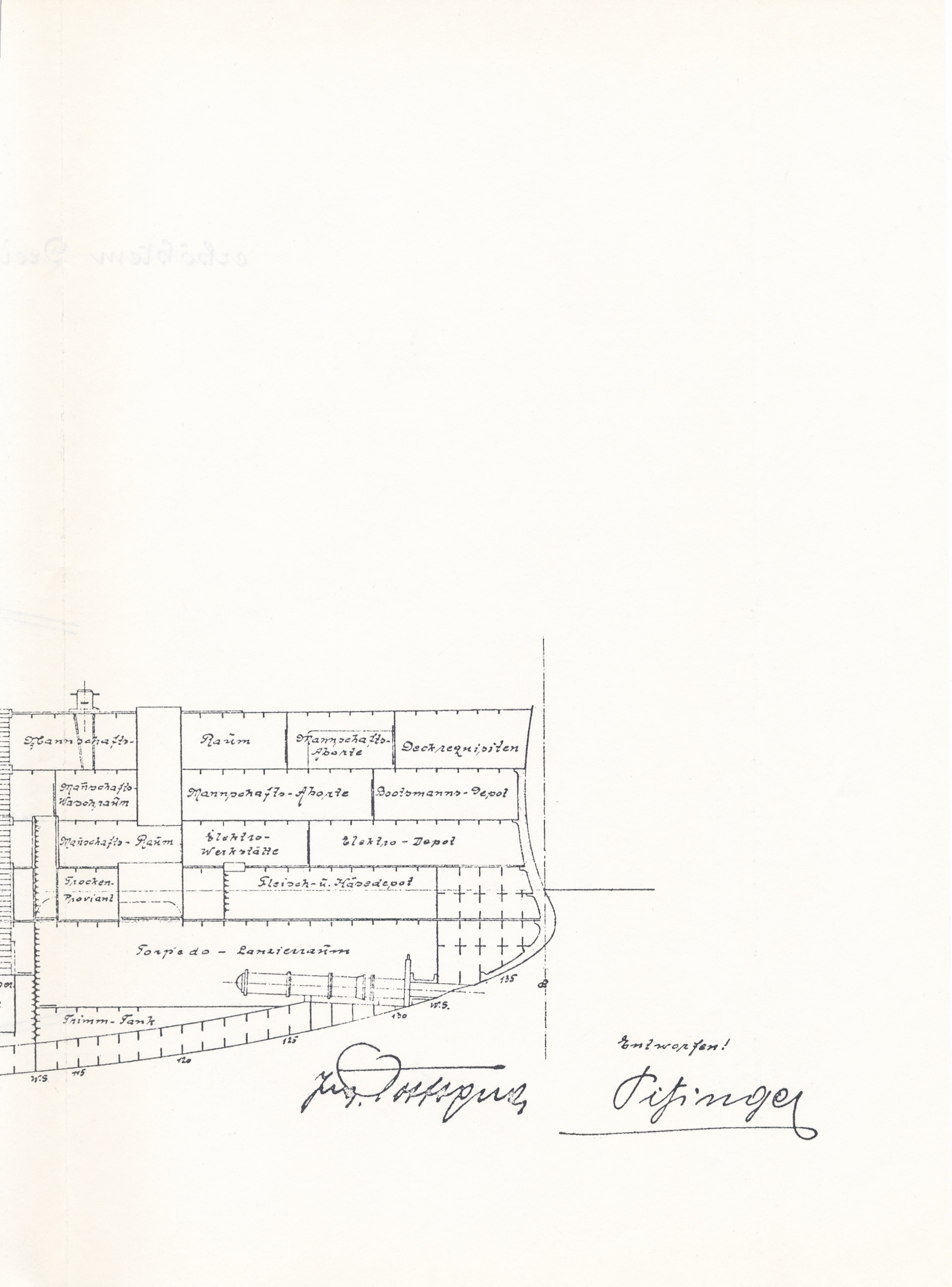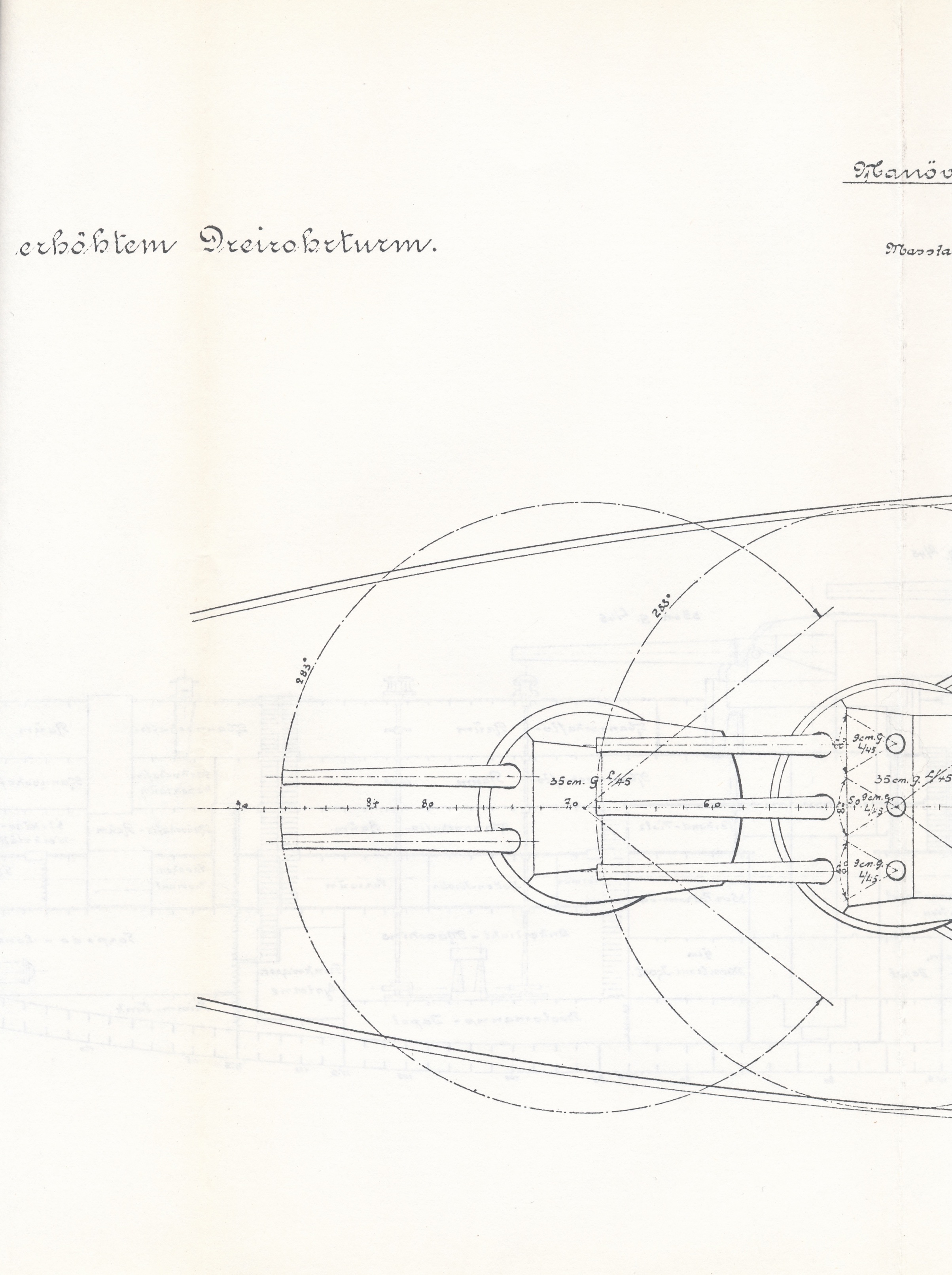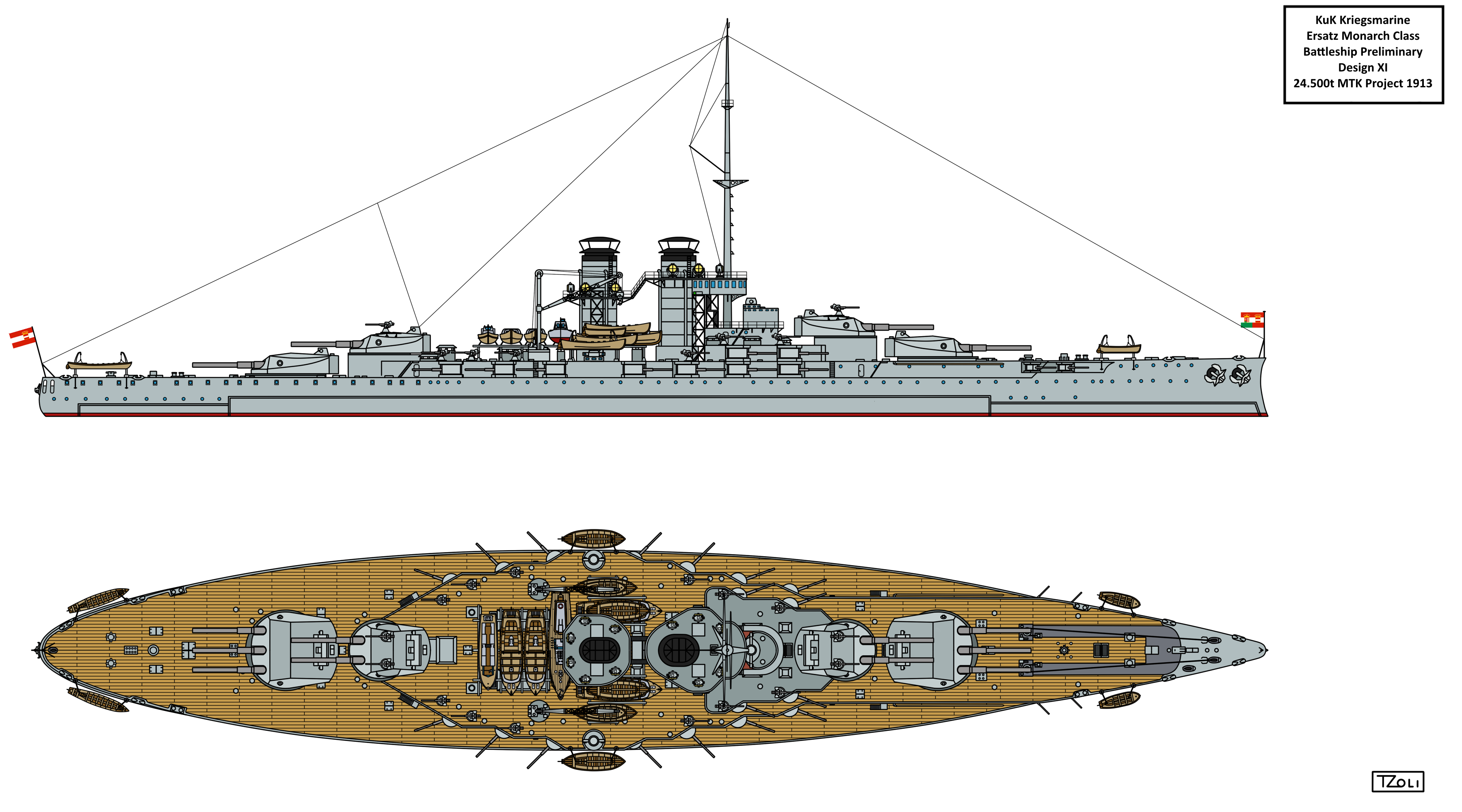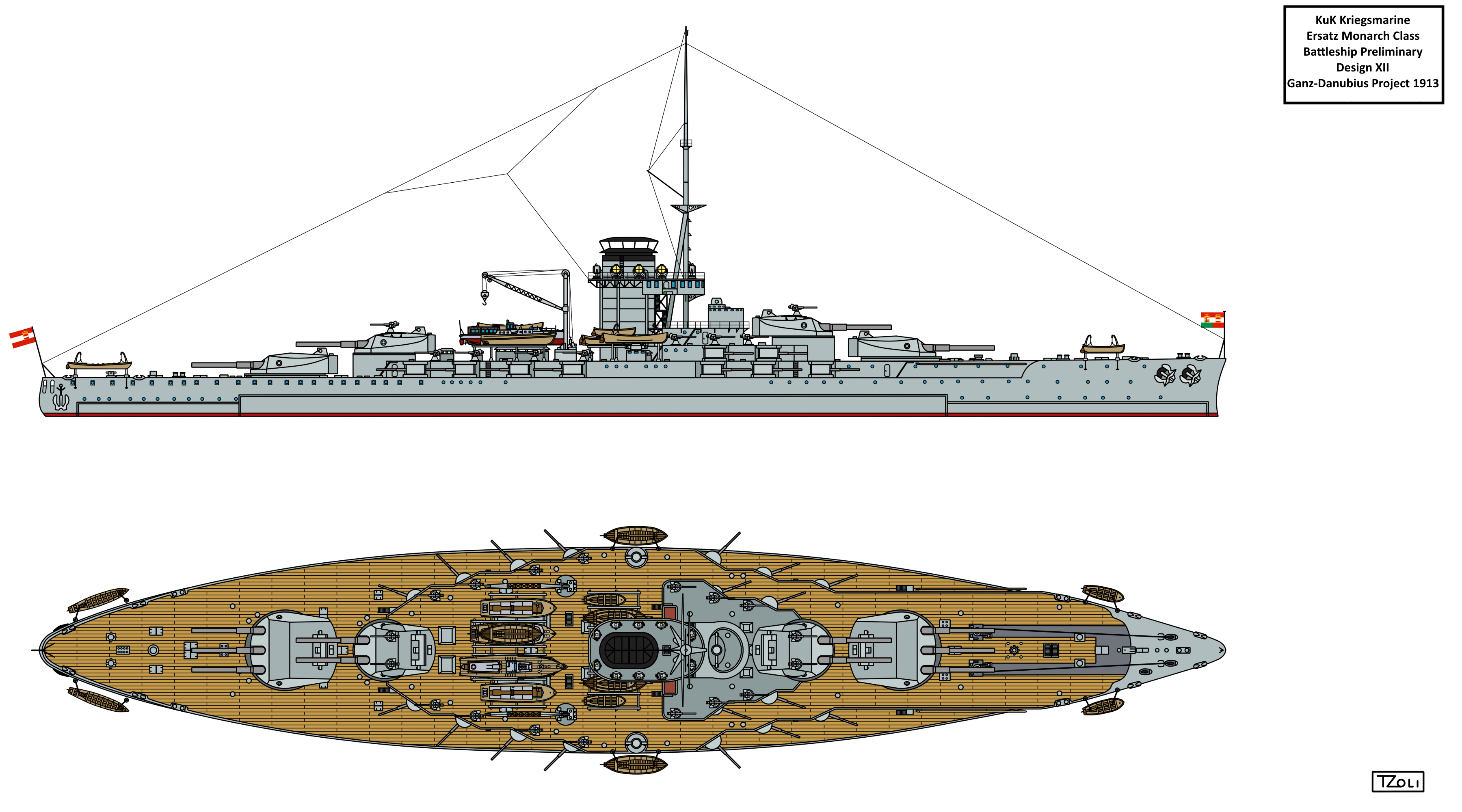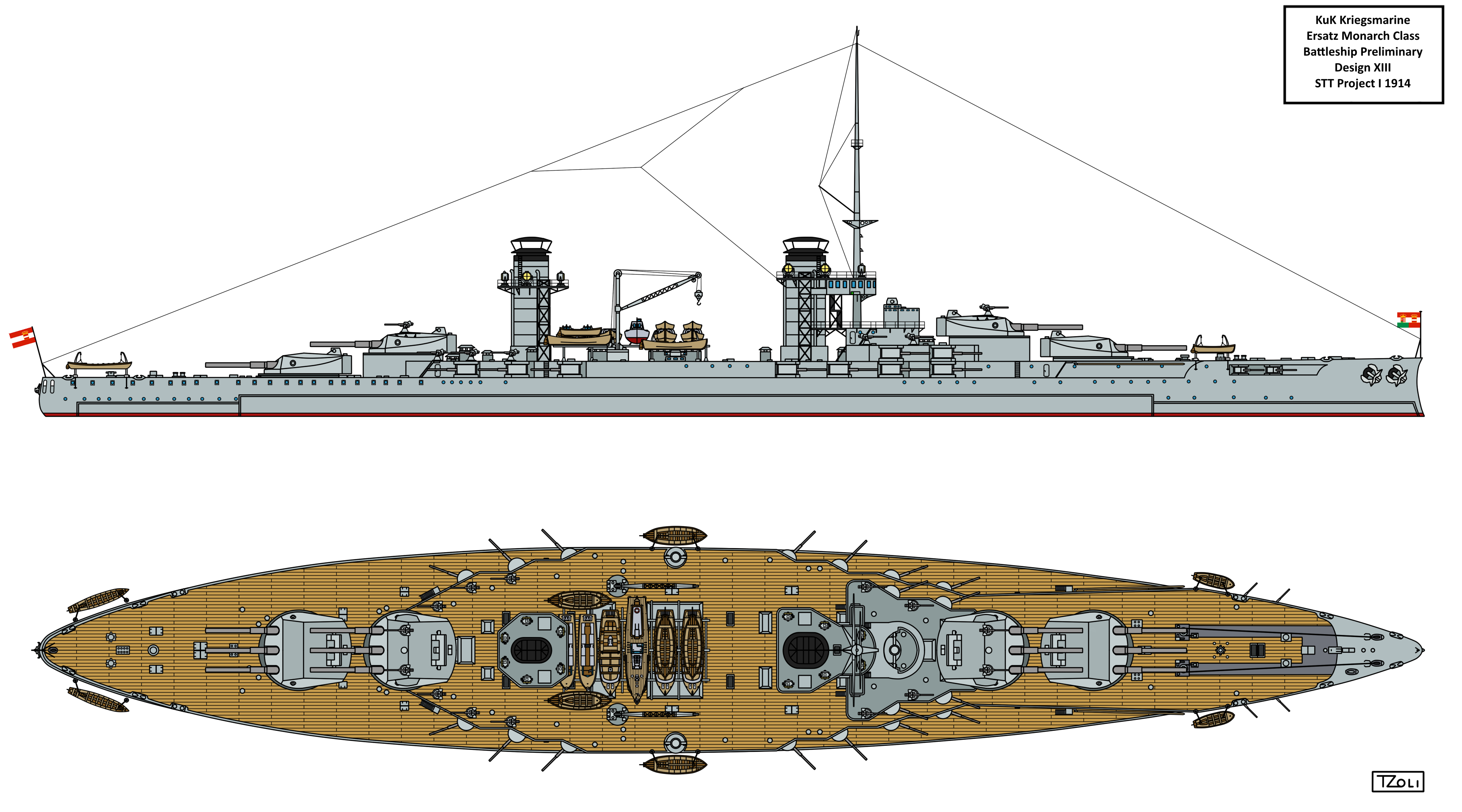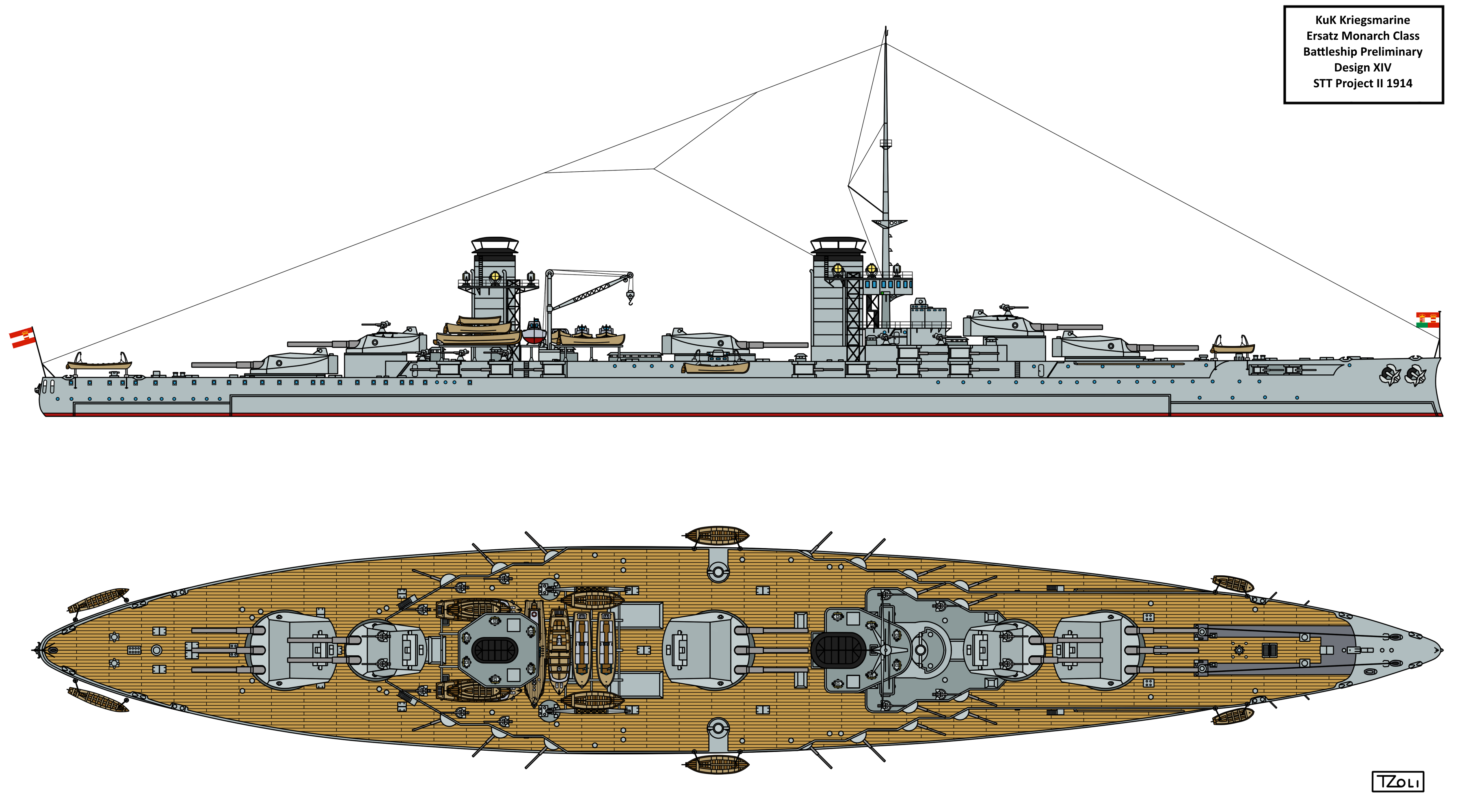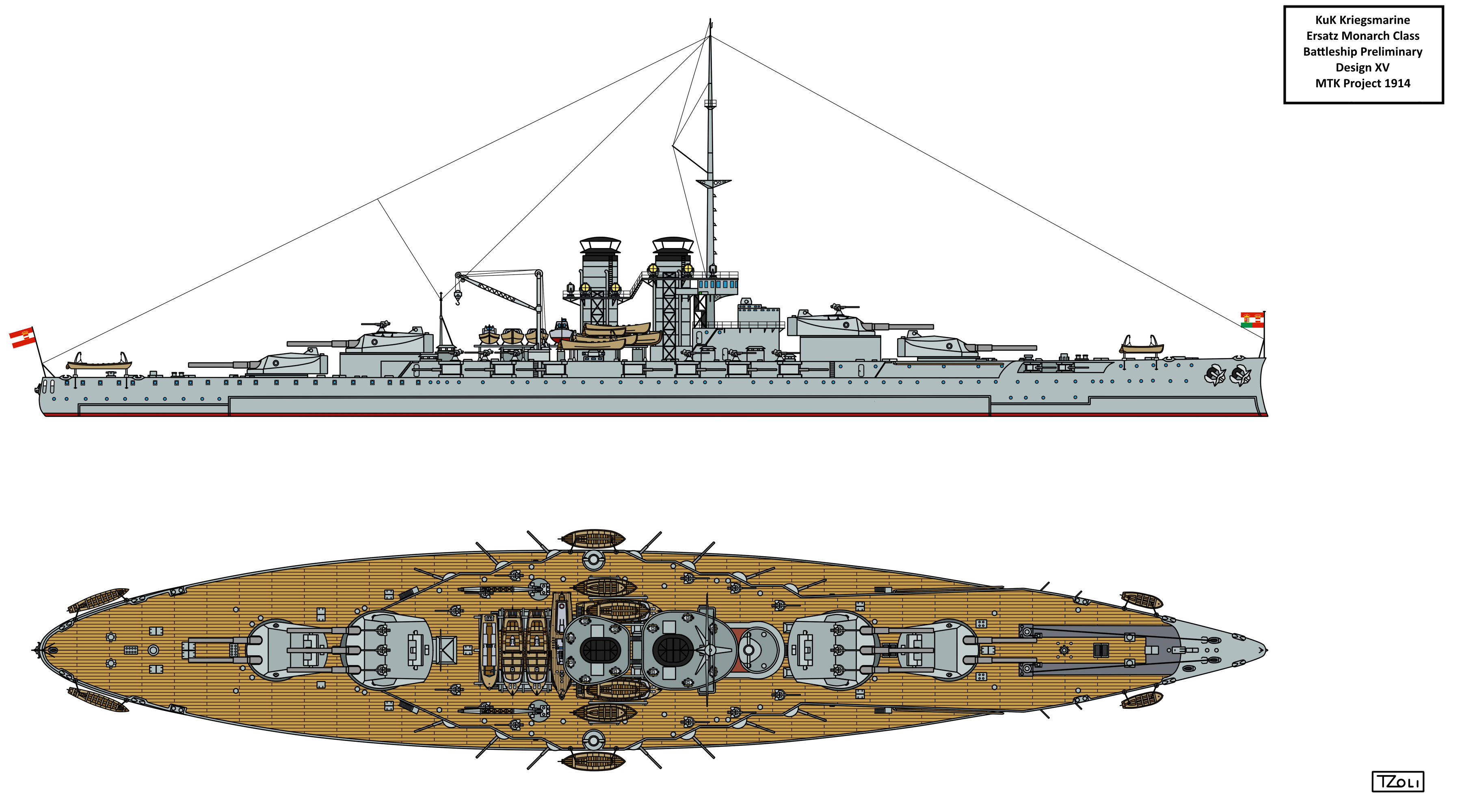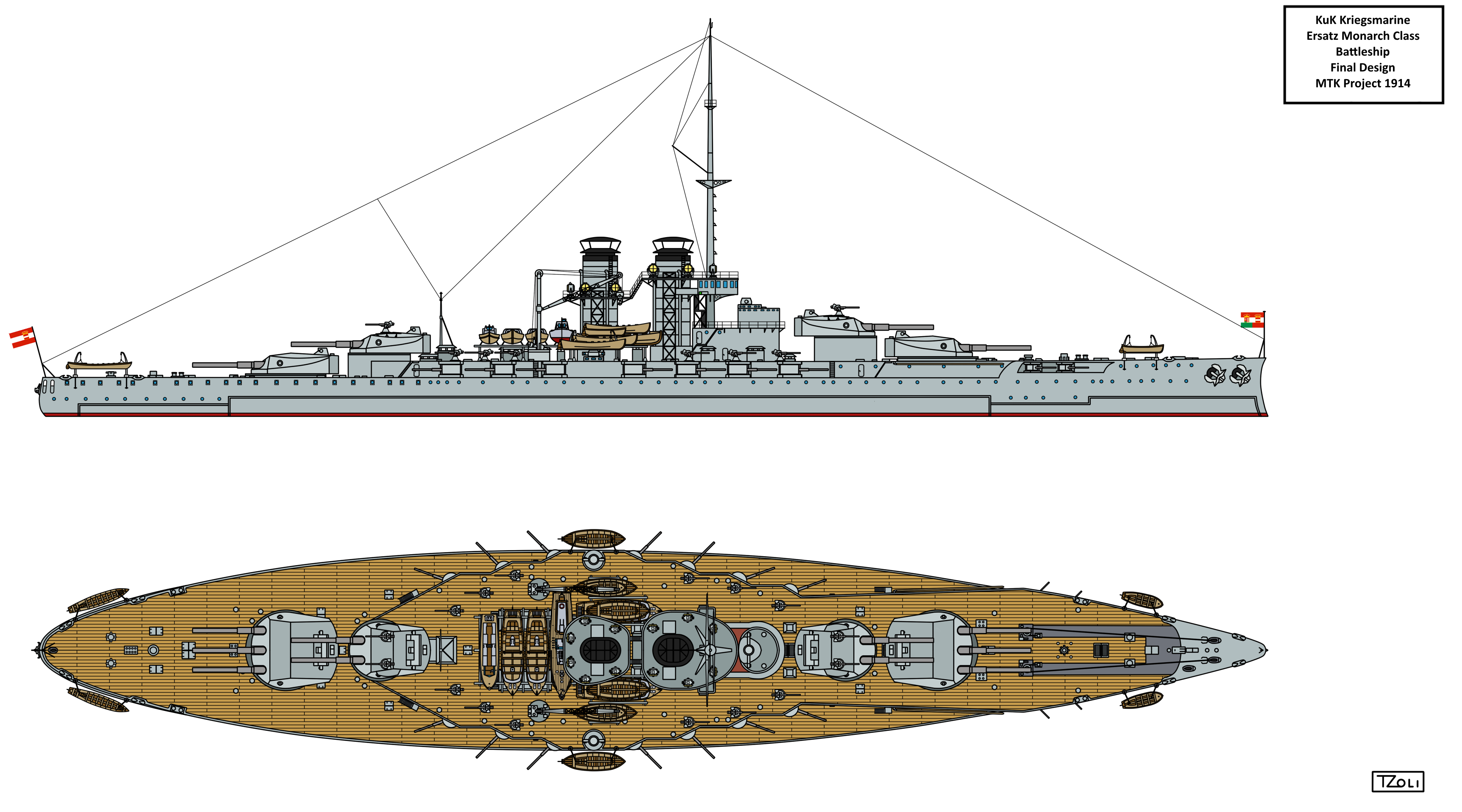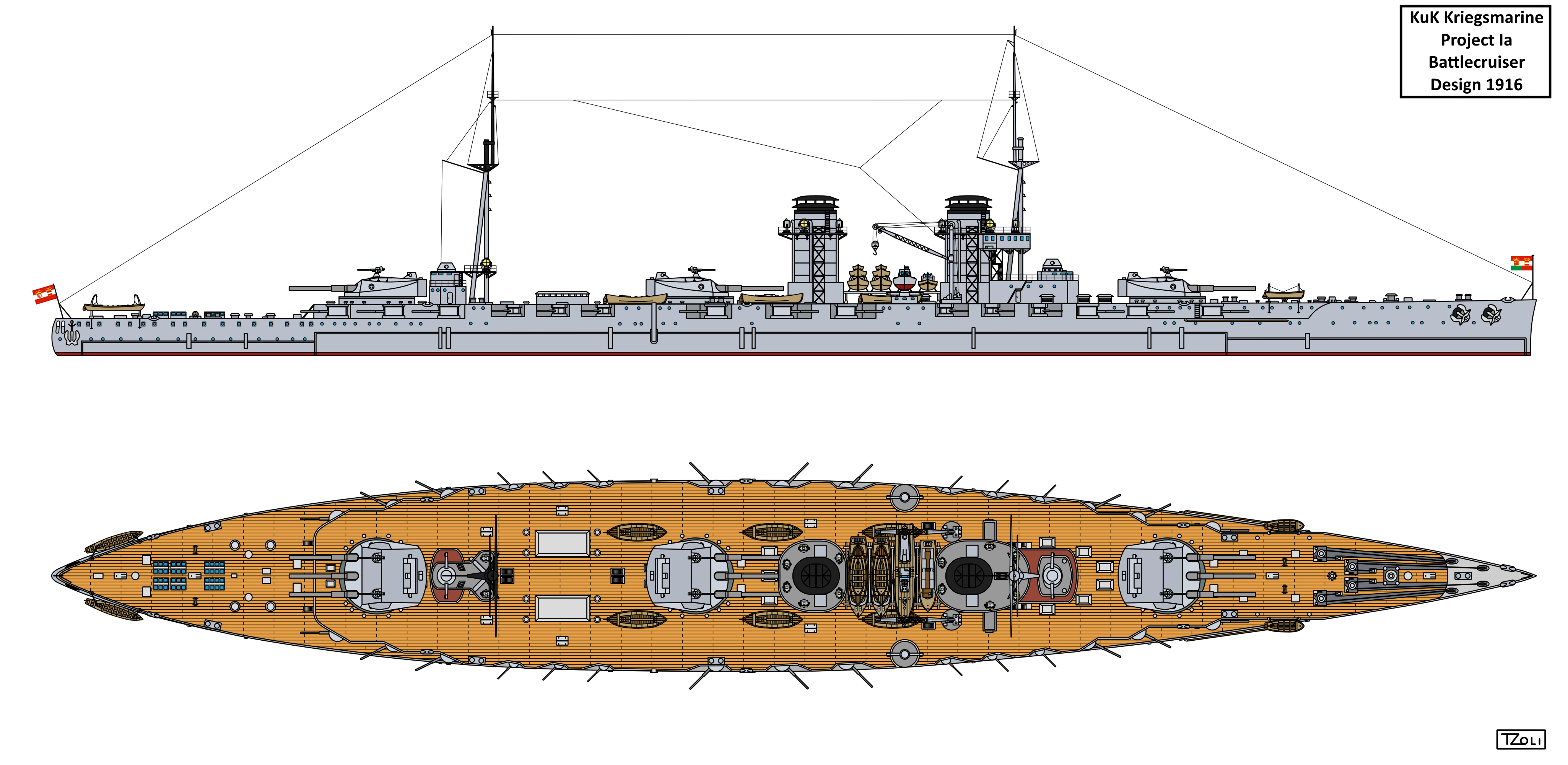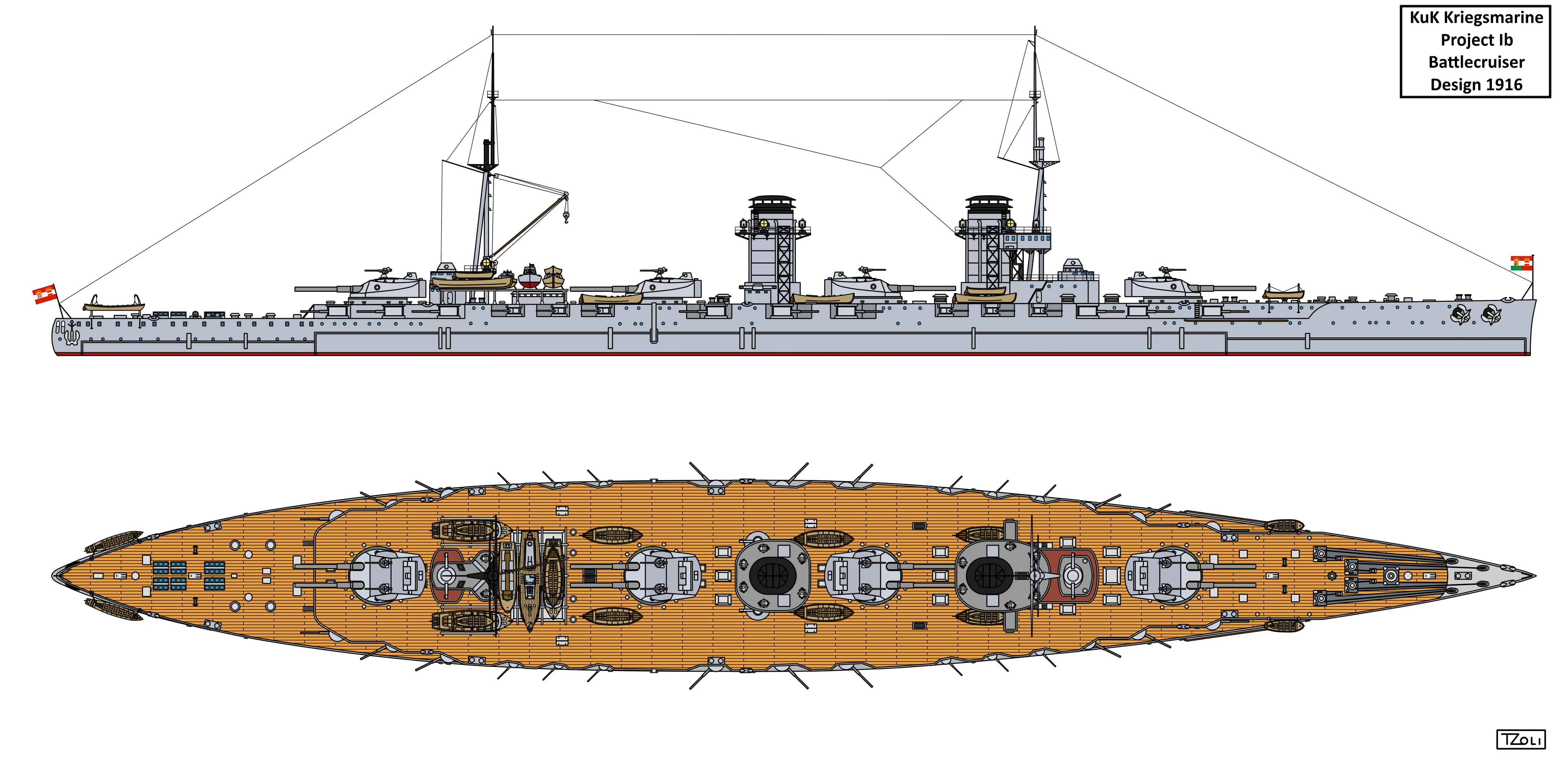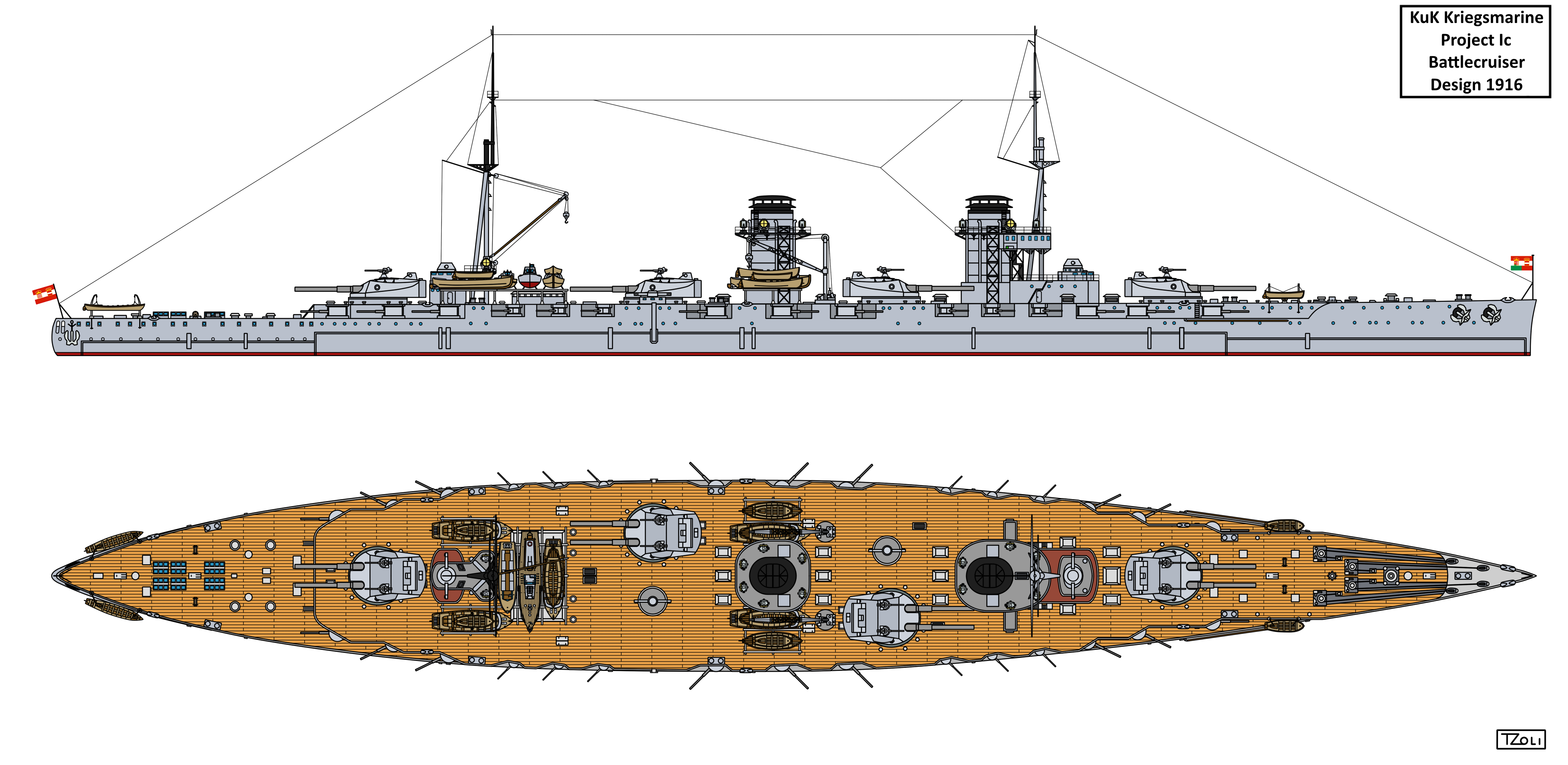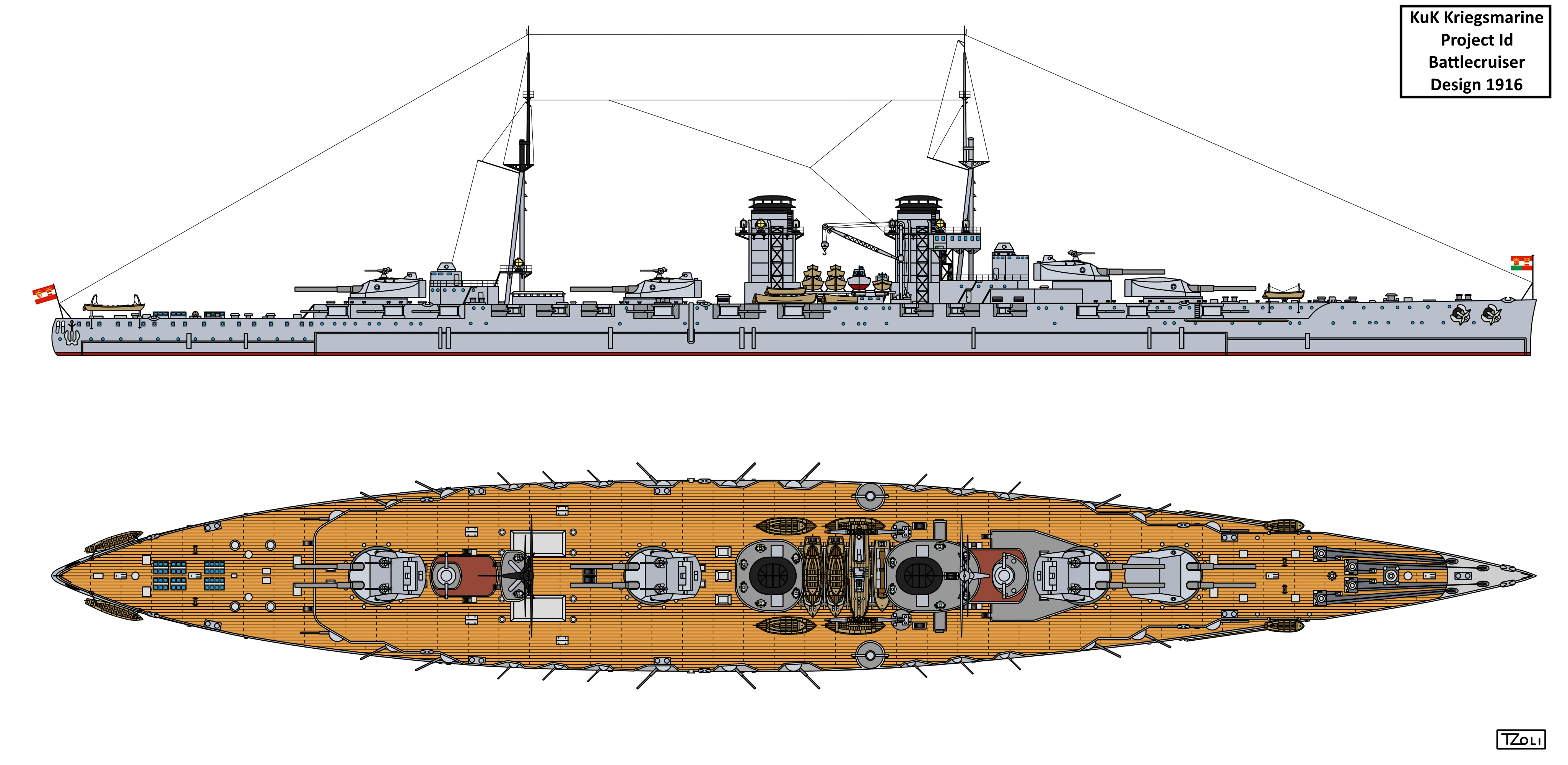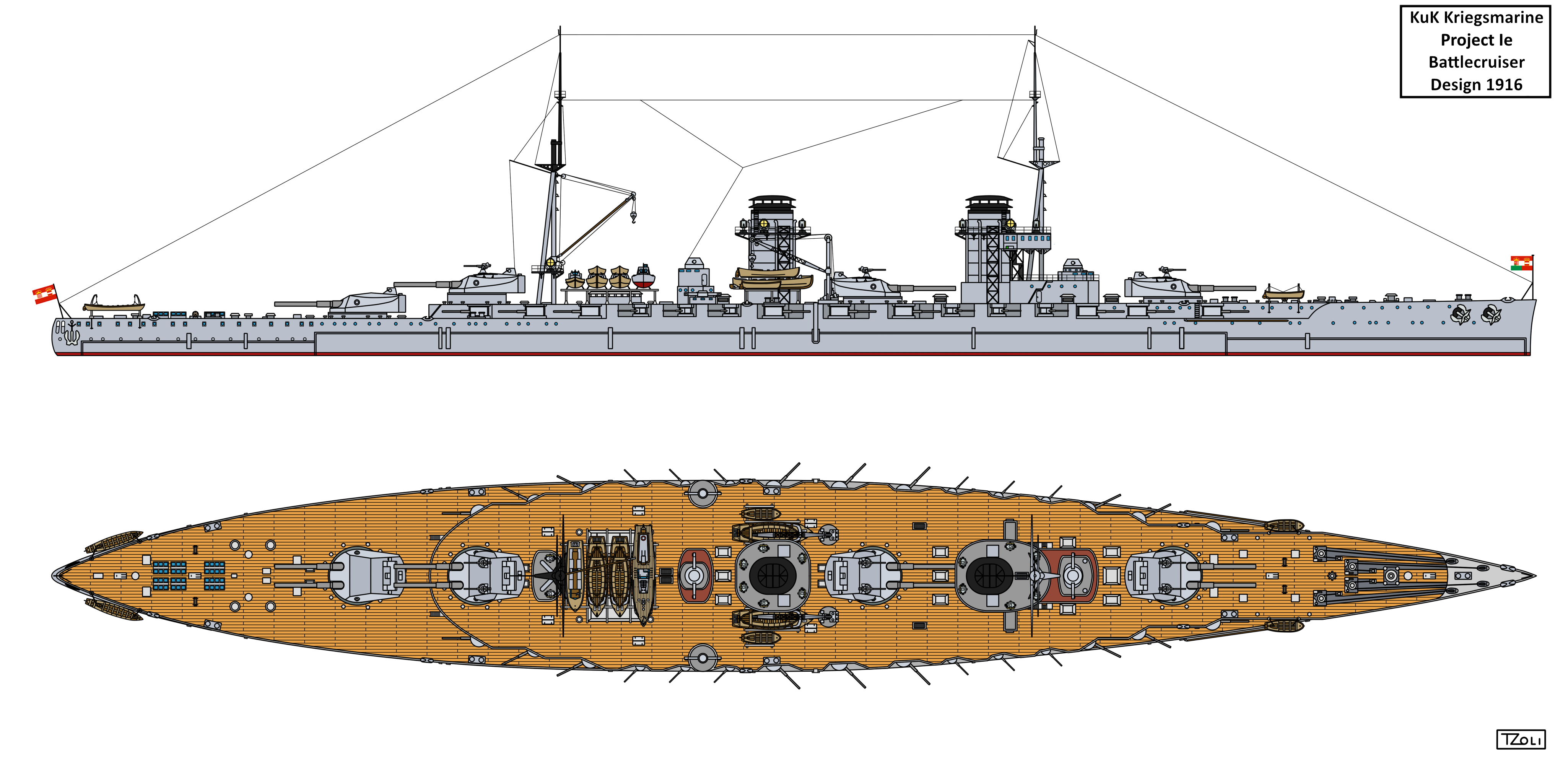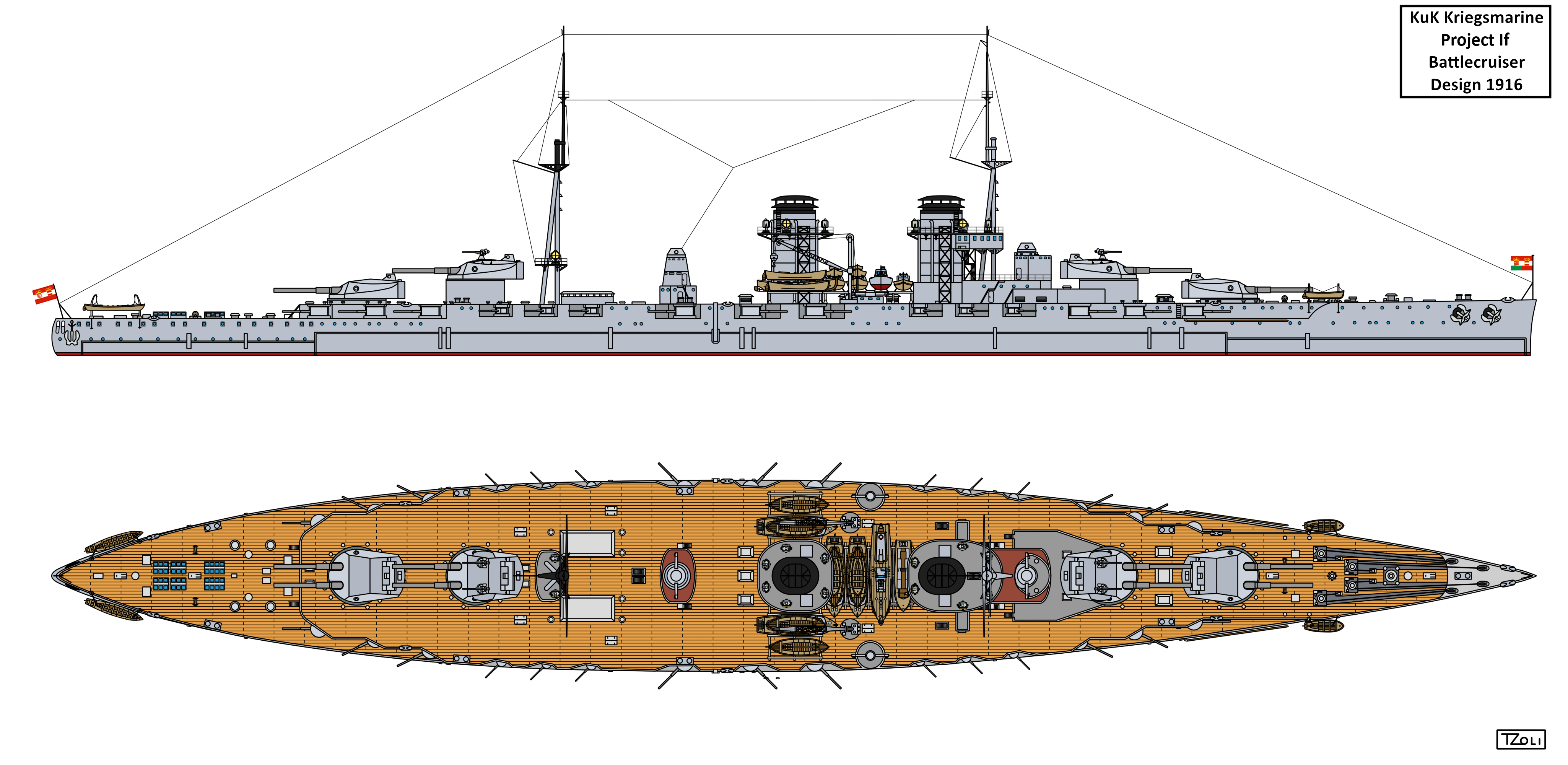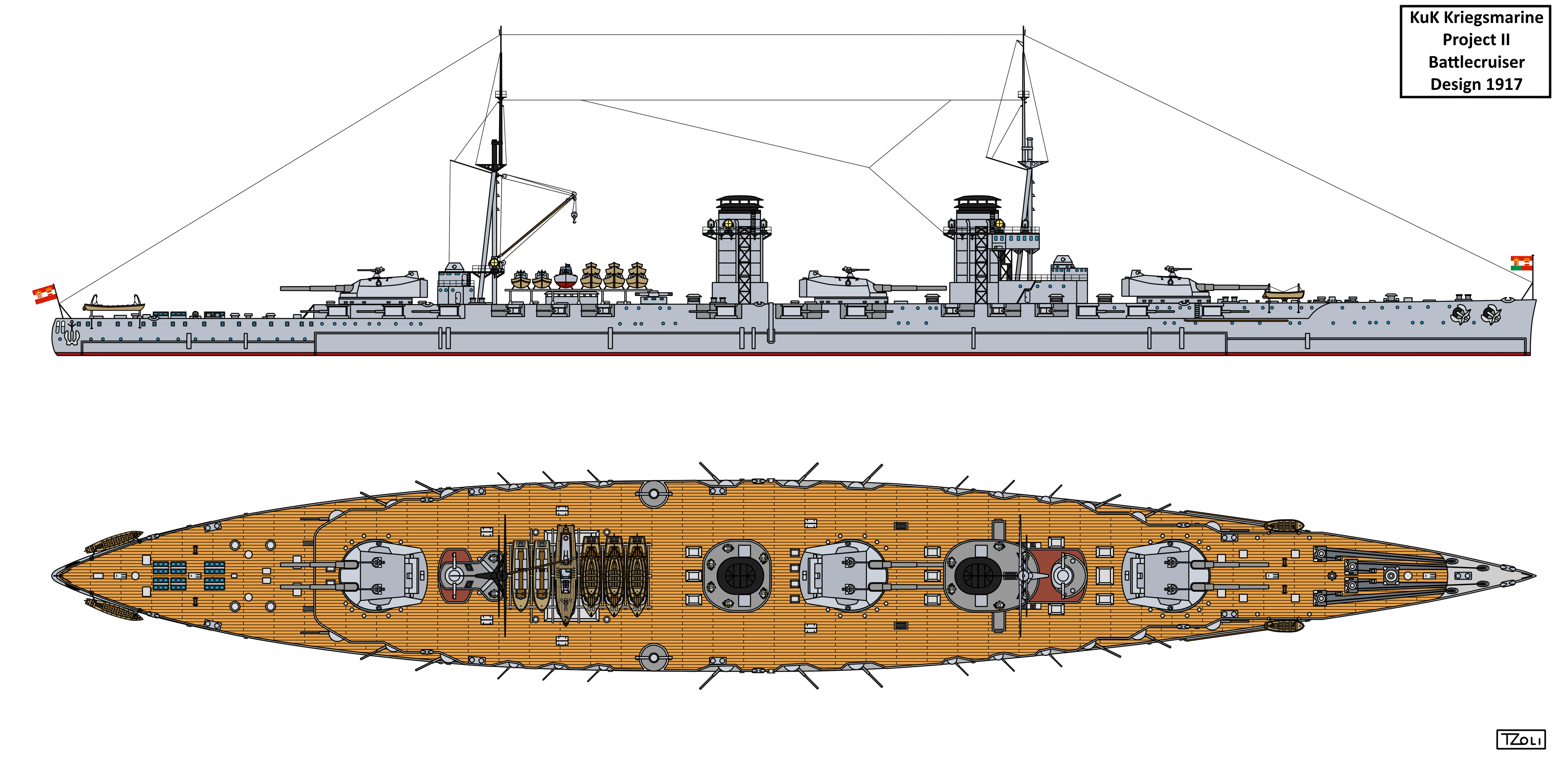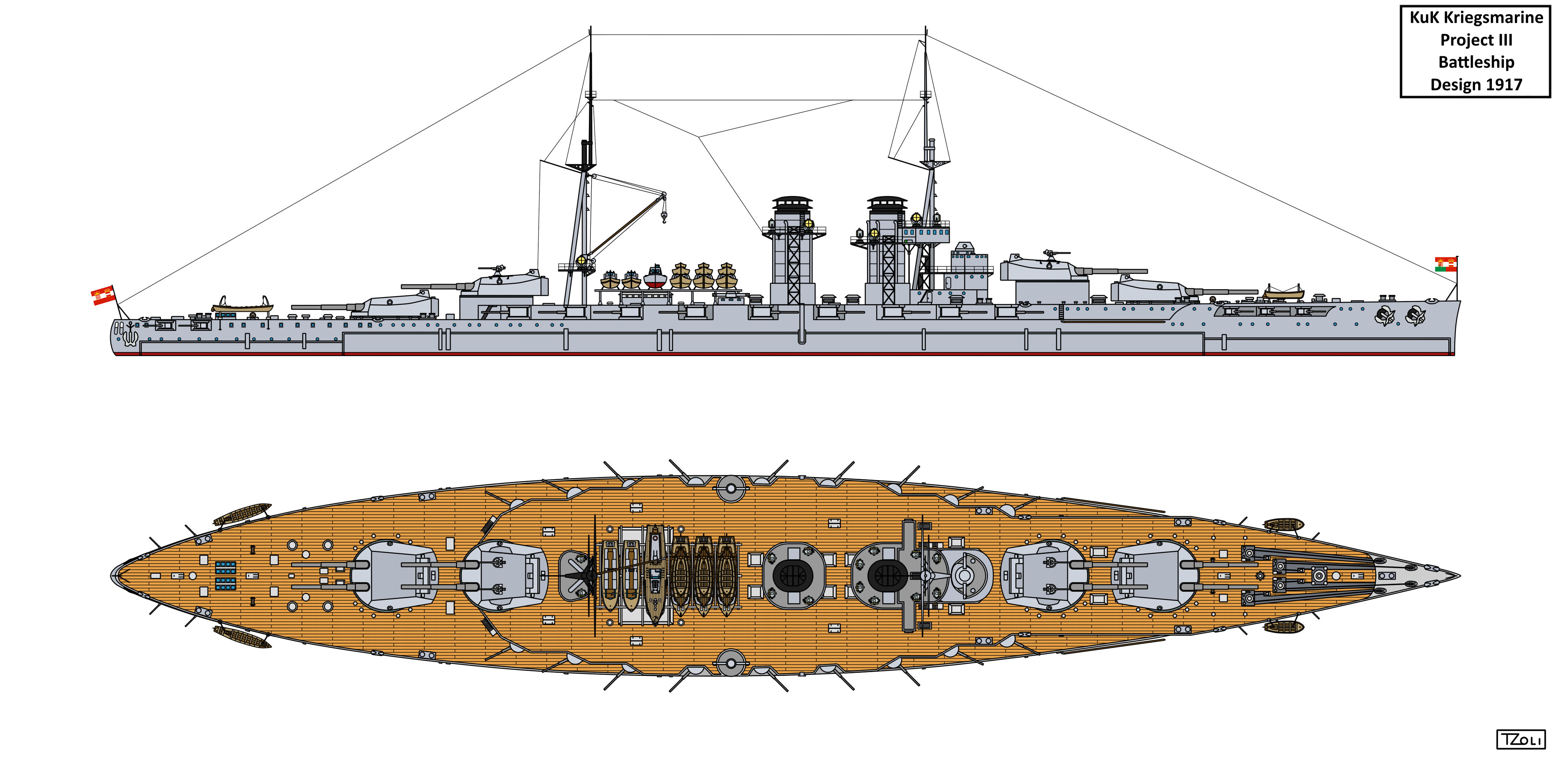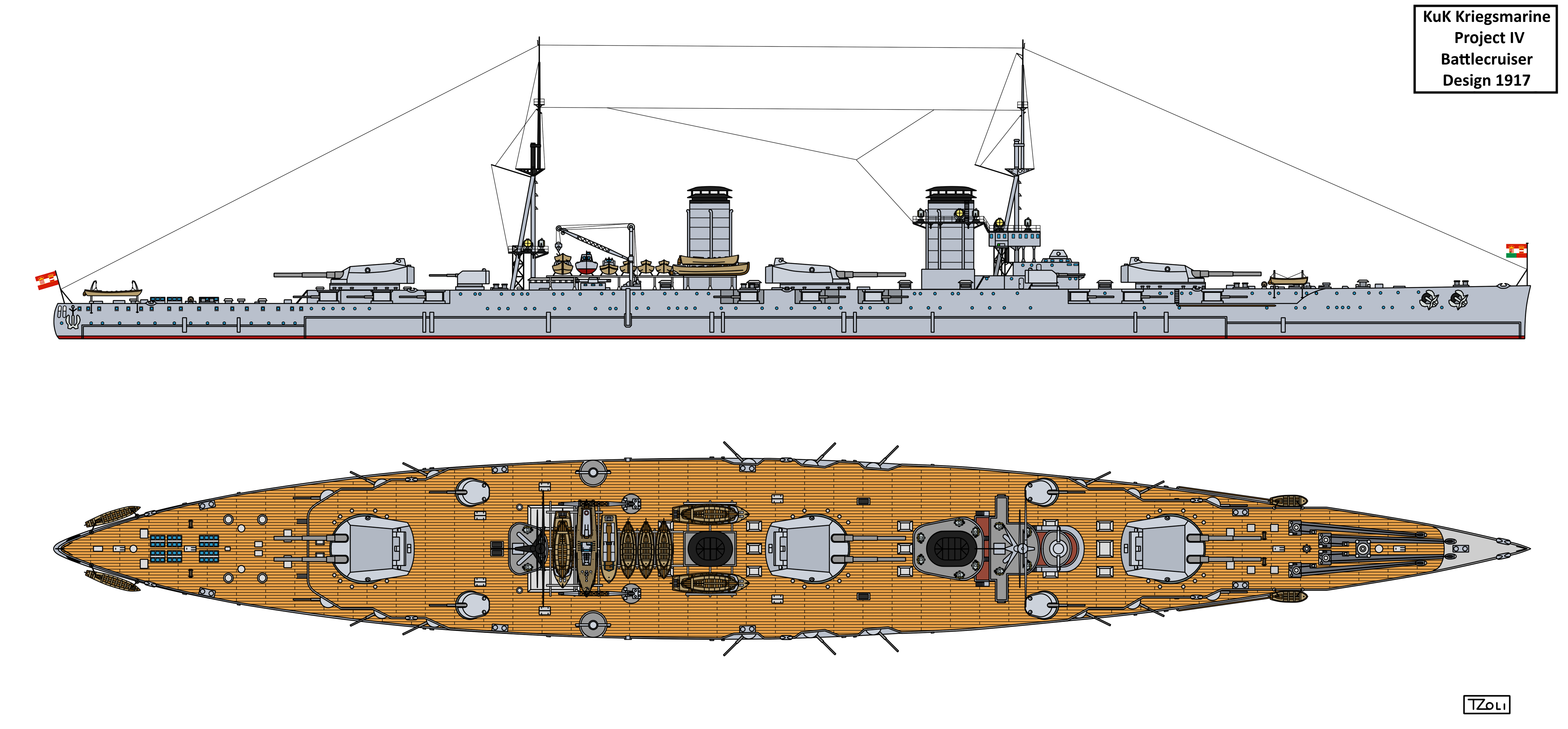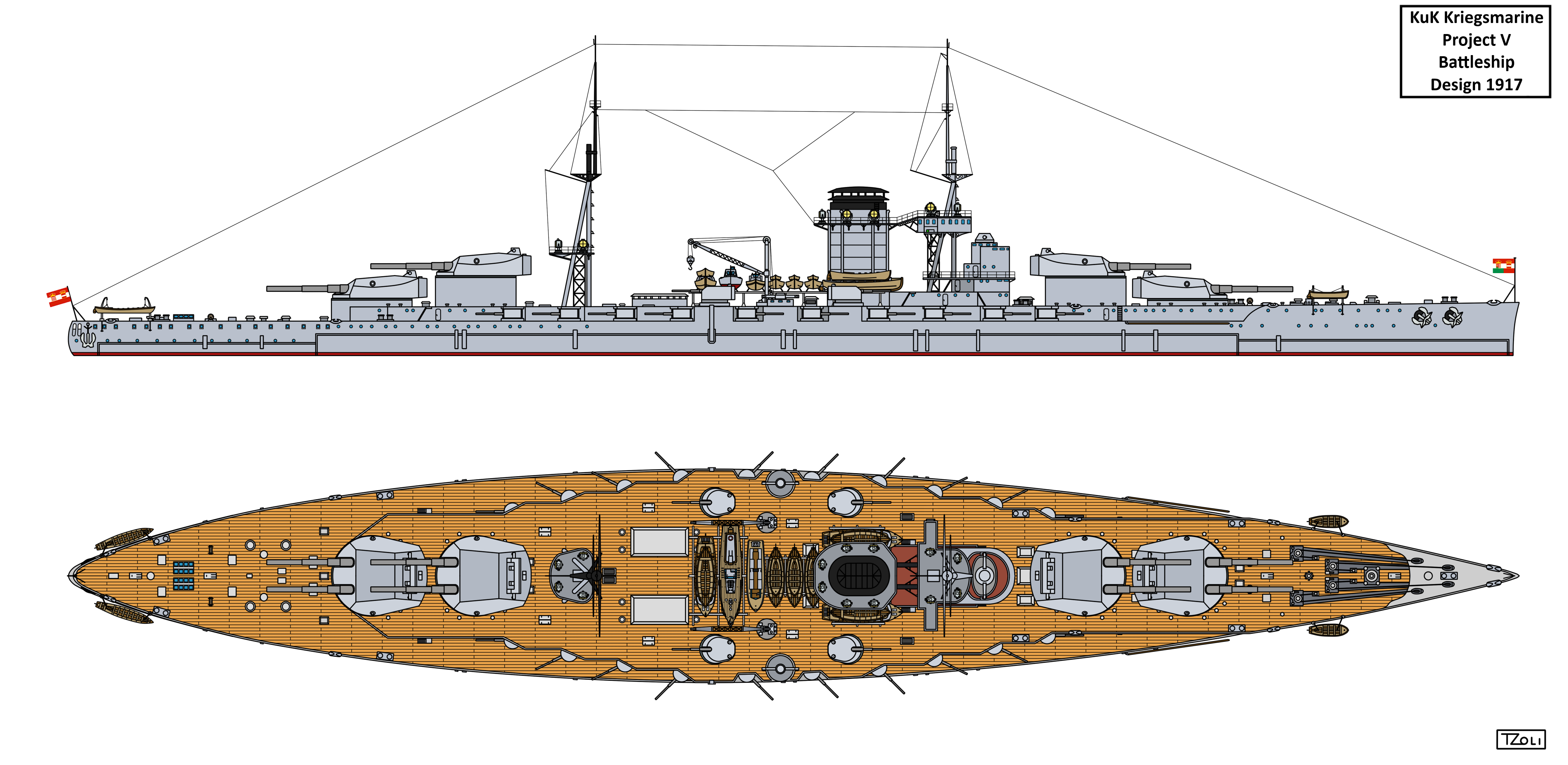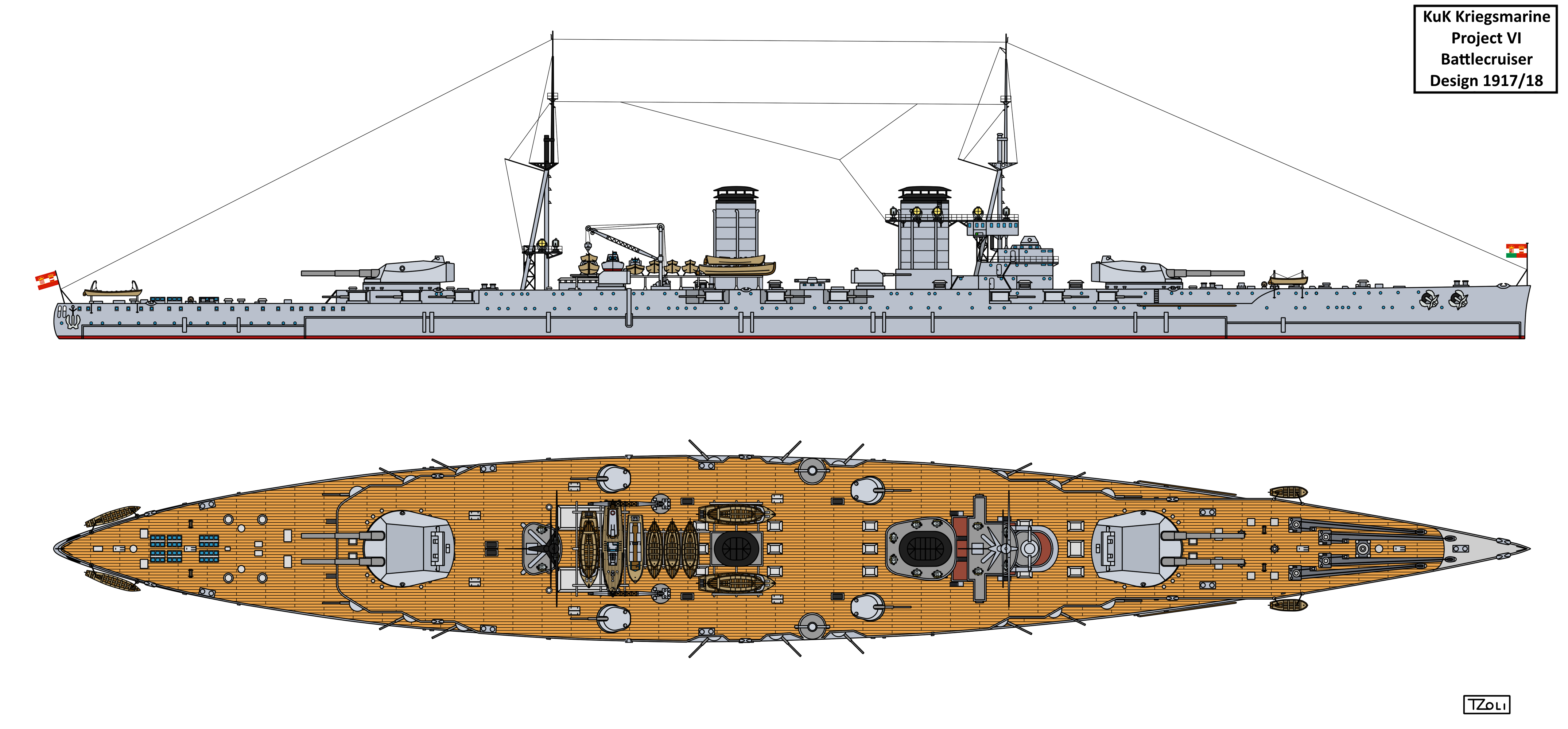- Joined
- 1 February 2011
- Messages
- 2,615
- Reaction score
- 2,591
This thread was long overdue, actually way long overdue. I don't know why didn't I posted these until now.
So here it is, the capital ship projects of the Kaiserliche und Königliche Kriegsmarine aka the KuK Kriegsmarine or the Austro-Hungarian Navy
Some designs were already posted here:
But now I create a comprehensive thread for them.
I'm sure you will see that quite a few of these designs are excellent and unique.
Let's start with the preliminary designs of the Radetzky class Semi-Dreadnought type battleships!
The 1904 series:
Project I:

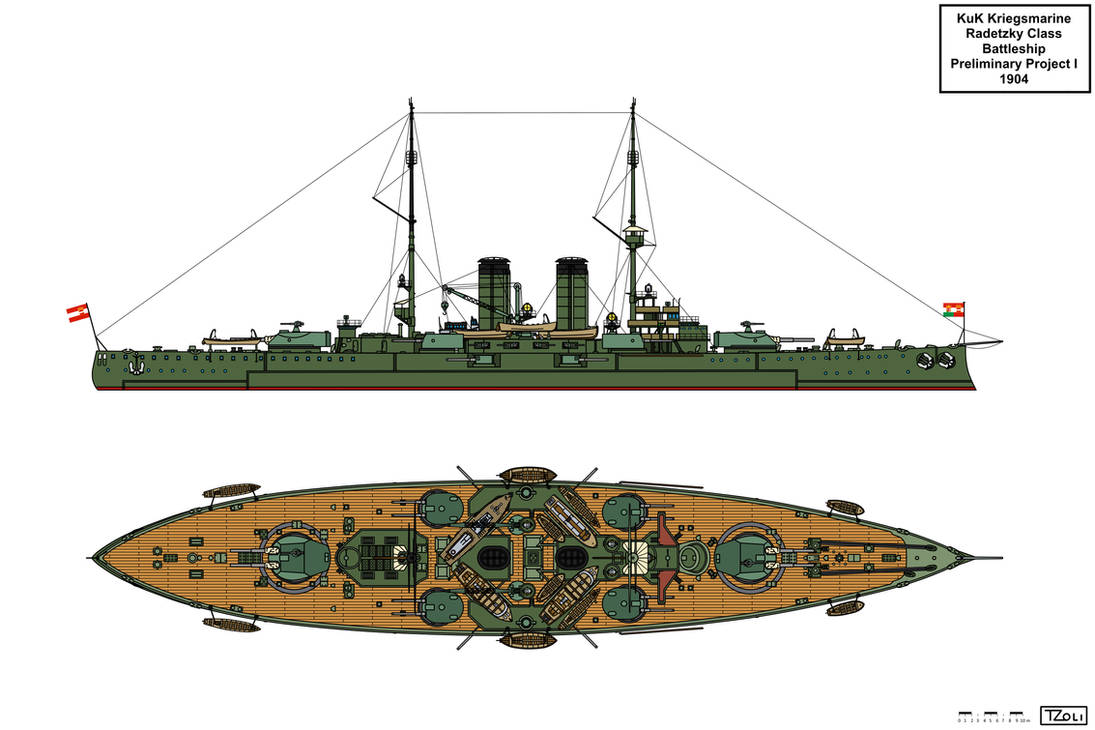
 www.deviantart.com
www.deviantart.com
The first meeting about a new battleship class was held at 1904, March 15. (almost a year after the launch of SMS Erzherzog Karl) where Admiral Hermann Freiherr von Spaun, Vice-Admiral Rudolf Graf von Montecuccoli degli Erri, Rear-Admiral Juliusz Franciszek von Ripper, Vice-Admiral Franz Freiherr von Minutillo, Rear-Admiral Anton Johann Haus and Naval Architect Siegfried Popper were participated. They decided to begin designing a new battleship class, though the construction could only be started after the current 3 was finished so around 1907 and Popper was instructed to start working on the preliminary studies for the new class.
The next meeting was done at the same year May 18 at Pola where Admiral Spaun noted that the construction could only start in 1907 and now only simple preliminary work was required to determine the hull and armament choices. It was set that the main armament calibre were to be either 30,5cm or 28cm rather 24cm like the previous class and the secodnary armament calibre was set at 19cm. Due to the new development of armour piercing shells the armour too had to be improved, together with this the displacement would rise by some 2.000tons compared to the previous class (10.600tons).
Discussions on placement of armaments was very fluid at this meeting, as the following ideas was emerged:
- 2 single 30,5cm Turrets
- 2 twin 28cm Turrets
- 1 single and twin 30,5cm Turrets
- 1 twin 30,5cm forward, 1 twin 24cm aft Turret
But in the end there were no definite decision was made armament wise.
By the Summer of 1904 MTK (Marinetechnische Komitee - Naval Technical Committee), Pola lead by Siegfried Popper produced six alternative plans. Of the 6 plans only one had 28cm/45 Main Guns (Project I) the rest were carried 30,5cm/40 weapons and none were equipped with 24cm Guns. Secondary armament was uniform 19cm/42 Guns and armour belt was decided on 230mm, with main turrets having 280mm face plates.
So this is the first of the series of Radetzky Preliminaries, the 1904 designs, where I've used the hull shape of the previous Erzherzhog Karl class but enlarged to Radetzky dimensions, two funnels because the wider hull allowed more space for the Boilers, and mixed Radetzky-Erzherzhog style superstructure elements. Added 66mm Anti-Torpedoboat Guns which was the standard calibre of the KuK Kriegsmarine at the time
The design had the following characteristics:
Dimensions: Unknown except the width so I've used the data of the Radetzkys: 137,5m (wl) 138,8m (oa) x 24,0m x 8,1m
Displacement: 12.650tons (standard)
Armour: 40mm Deck, 230mm Belt
Engines: 18.000shp Yarrow Vertical Triple Expansion Engines, 2 Shafts
Speed: 37km/h (20knots)
Range: 7.400km at 18,5km/h (4.000nm at 10knots)
Armaments:
2x2 28cm/45 Skoda K04 Cannons
4x2,4x1 19cm/42 Skoda K03 Guns
10x1 7cm/50 Skoda K10 Guns
3x1 45cm Underwater Torpedo tubes
The only known data table about the 1904 projects:
i.imgur.com/sHhBwgy.jpg
Project II:

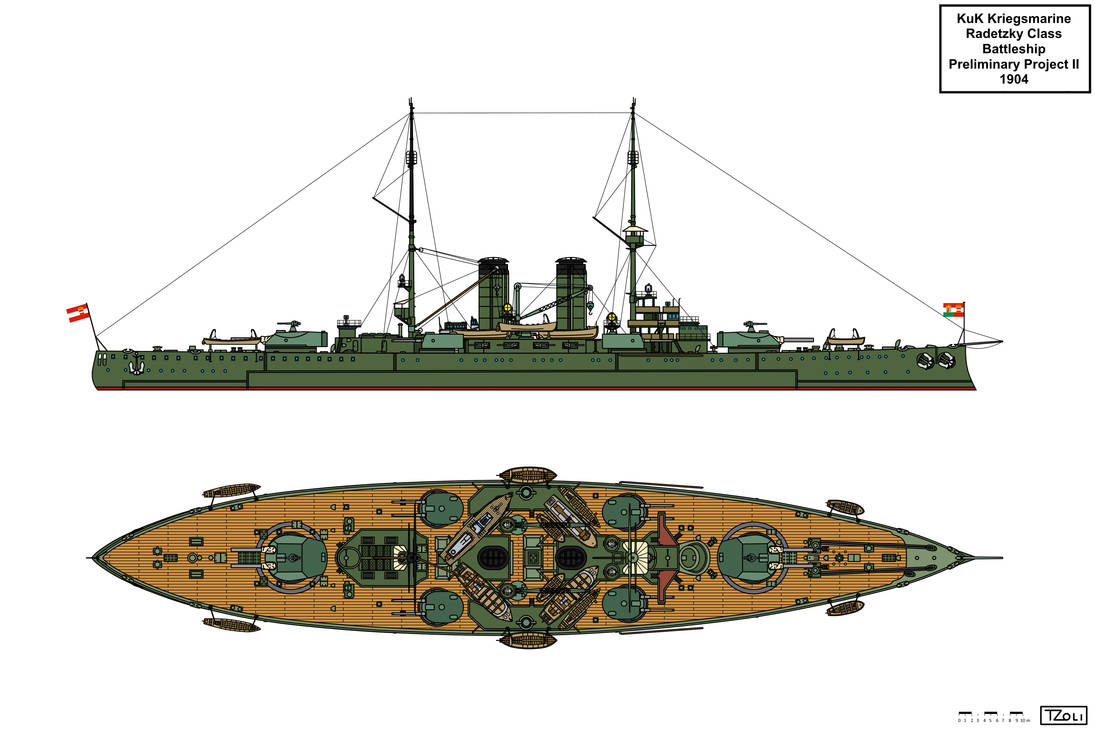
 www.deviantart.com
www.deviantart.com
Out of the six 1904 series of Pre-Designs, only Project I was equipped with 28cm calibre main guns the rest were all 30,5cm in various numbers, which shows the preference of the larger calibre weapons by Siegfried Popper.
The series shows that Popper and the team of the MTK wished to stay below 13.000tons hence the how the main Guns number increase or decrease the secondary gun numbers accordingly decreases or increases in number accordingly. Here for example 4 casemated 19cm Guns were sacrificed for increasing the main gun calibre to 30,5cm. Another unique about these designs are the introduction of the 30,5cm Guns but not the final 45 calibre ones but a shorter 40 ones which seems consistent of an incremental increase in firepower over the previous class. Also this was the only design to have 19knots speed with 16.000shp engine power to reach it, rather 18.000 of the previous class and 20.000 of the final one.
The design had the following characteristics:
Dimensions: Unknown except the width so I've used the data of the Radetzkys: 137,5m (wl) 138,8m (oa) x 24,0m x 8,1m
Displacement: 12.200tons (standard)
Armour: 40mm Deck, 230mm Belt
Engines: 16.000shp Yarrow Vertical Triple Expansion Engines, 2 Shafts
Speed: 35km/h (19knots)
Range: 7.400km at 18,5km/h (4.000nm at 10knots)
Armaments:
2x2 30,5cm/40 Skoda K05 Cannons
4x2 19cm/42 Skoda K03 Guns
10x1 7cm/50 Skoda K10 Guns
3x1 45cm Underwater Torpedo tubes
Project III:

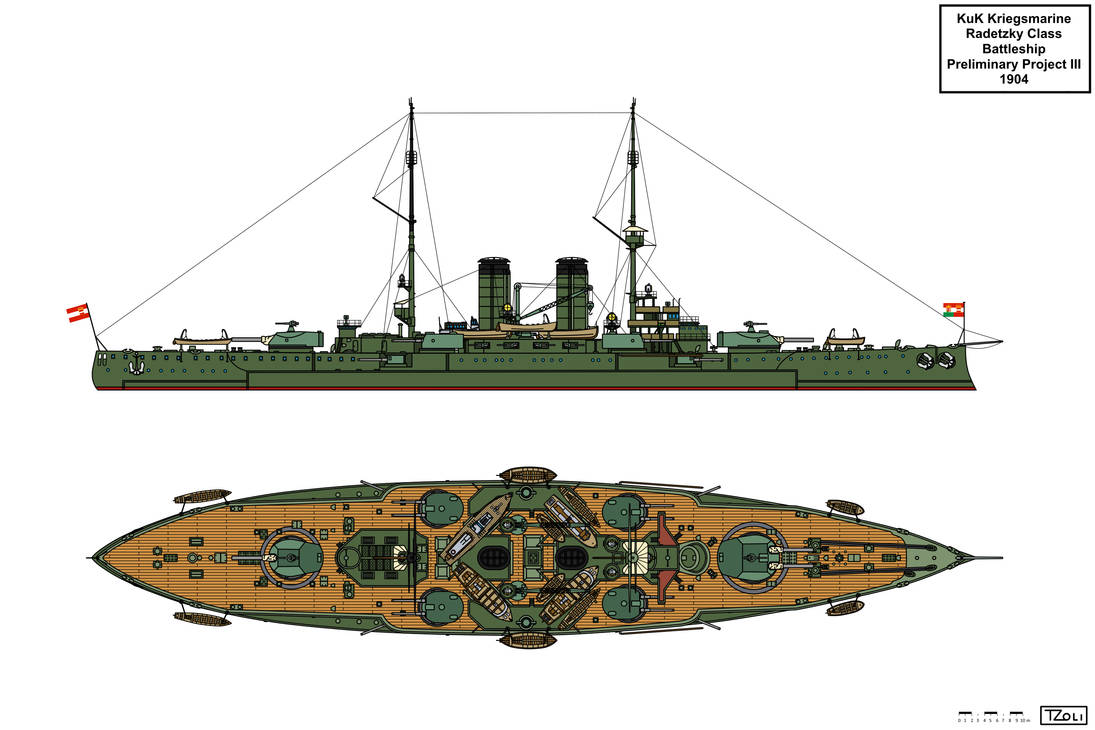
 www.deviantart.com
www.deviantart.com
In order to maintain the tonnage limit the designers had to sacrafice the armament to increse other aspects of the ship. This time by reducing the number of 30,5cm Cannons from 4 to 3 allowed the increase of the secondary 19cm Gun number from 8 Guns to 12 and a broadside of 4 to 6. This is logical, if you set the a displacement limit and speed to achieve while armour must remain the same, the only thing you can "play" with is the armament, either it's calibre and/or it's number. While this philosophy is evident in every Major Power's navy it is most significant in the the case of the KUK Kriegsmarine which not only have very limited number of shipyards, (2 at the time, both at STT - Stabilimento Tecnico Triestino) and floating docks (none at the time) for construction and service / fitting out but the economical background as well (material and monetary).
The design had the following characteristics:
Dimensions: Unknown except the width so I've used the data of the Radetzkys: 137,5m (wl) 138,8m (oa) x 24,0m x 8,1m
Displacement: 12.650tons (standard)
Armour: 40mm Deck, 230mm Belt
Engines: 18.000shp Yarrow Vertical Triple Expansion Engines, 2 Shafts
Speed: 37km/h (20knots)
Range: 7.400km at 18,5km/h (4.000nm at 10knots)
Armaments:
1x2,1x1 30,5cm/40 Skoda K05 Cannons
4x2,4x1 19cm/42 Skoda K03 Guns
10x1 7cm/50 Skoda K10 Guns
3x1 45cm Underwater Torpedo tubes
Project IV:

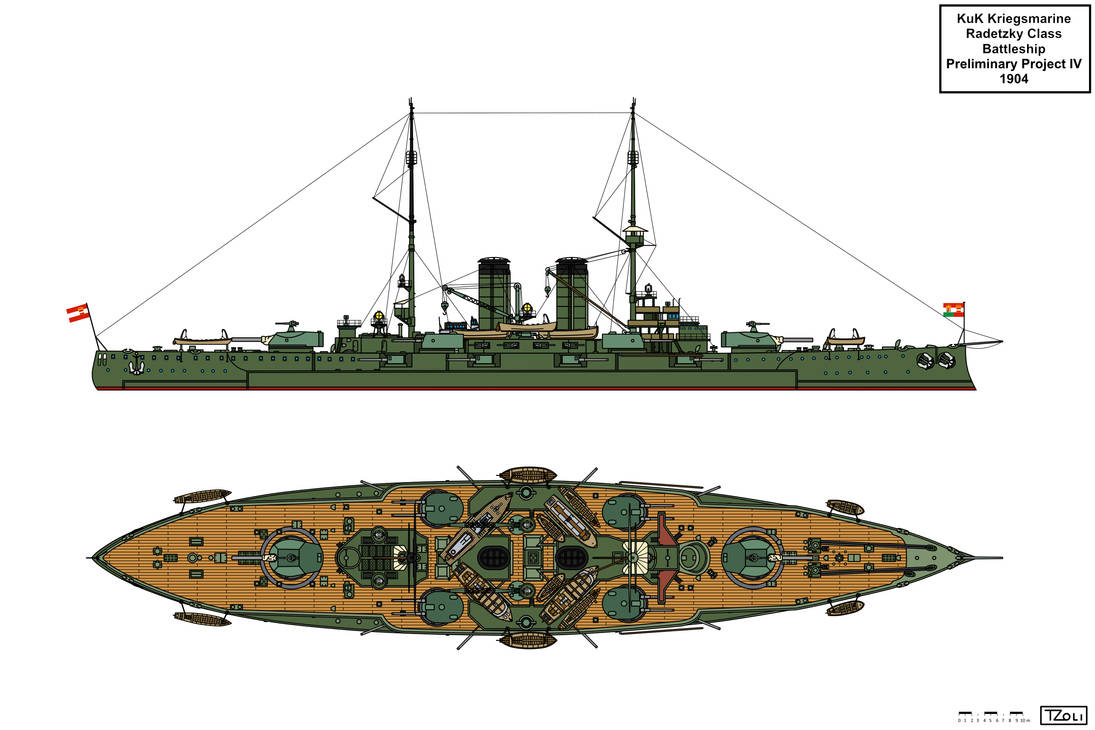
 www.deviantart.com
www.deviantart.com
With Project IV Siegfried Popper and the designers of MTK reached the lowest end of primary firepower of a battleship!
By further reducing the gun barrels number to two from three from Project III, but further increasing the secondary 19cm guns number to 16, 8 per side. Basically they made a modern version of the Habsburg class Coastal Defence Battleship with this proposal. With this many 19cm Guns you have much higher chance of sinking a ship with plunging fire then with the main 30,5cm cannons! None the less this is another unique design, probably the least useful for what the KuK Kriegsmarine was needed but shows the options offered for the new battleship class.
The design had the following characteristics:
Dimensions: Unknown except the width so I've used the data of the Radetzkys: 137,5m (wl) 138,8m (oa) x 24,0m x 8,1m
Displacement: 12.650tons (standard)
Armour: 40mm Deck, 230mm Belt
Engines: 18.000shp Yarrow Vertical Triple Expansion Engines, 2 Shafts
Speed: 37km/h (20knots)
Range: 7.400km at 18,5km/h (4.000nm at 10knots)
Armaments:
2x1 30,5cm/40 Skoda K05 Cannons
4x2,8x1 19cm/42 Skoda K03 Guns
10x1 7cm/50 Skoda K10 Guns
3x1 45cm Underwater Torpedo tubes
Project V:

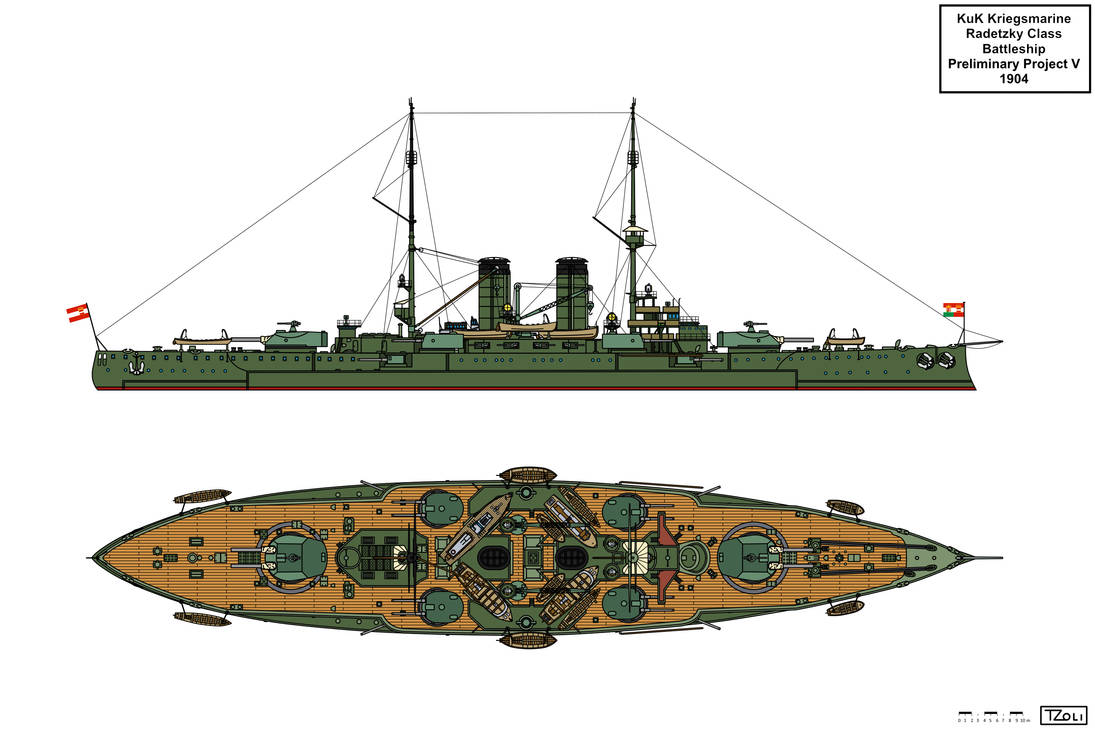
 www.deviantart.com
www.deviantart.com
The designers decided that the only way to have acceptable secondary firepower (eg at least 6 guns per broadside) and maintain the required main gun firepower of four 30,5cm weapons, was to increase the standard displacement to almost 13.000tons.
Hence the two last designs in the 1904 series were featured increased displacement for two twin 30,5cm and six 19cm Guns per broadside.
Project V combine the main turret layout of Project II and the secondary guns layout of Project III.
The design had the following characteristics:
Dimensions: Unknown except the width so I've used the data of the Radetzkys: 137,5m (wl) 138,8m (oa) x 24,0m x 8,1m
Displacement: 12.950tons (standard)
Armour: 40mm Deck, 230mm Belt
Engines: 18.000shp Yarrow Vertical Triple Expansion Engines, 2 Shafts
Speed: 37km/h (20knots)
Range: 7.400km at 18,5km/h (4.000nm at 10knots)
Armaments:
2x2 30,5cm/40 Skoda K05 Cannons
4x2,4x1 19cm/42 Skoda K03 Guns
10x1 7cm/50 Skoda K10 Guns
3x1 45cm Underwater Torpedo tubes
Project VI:

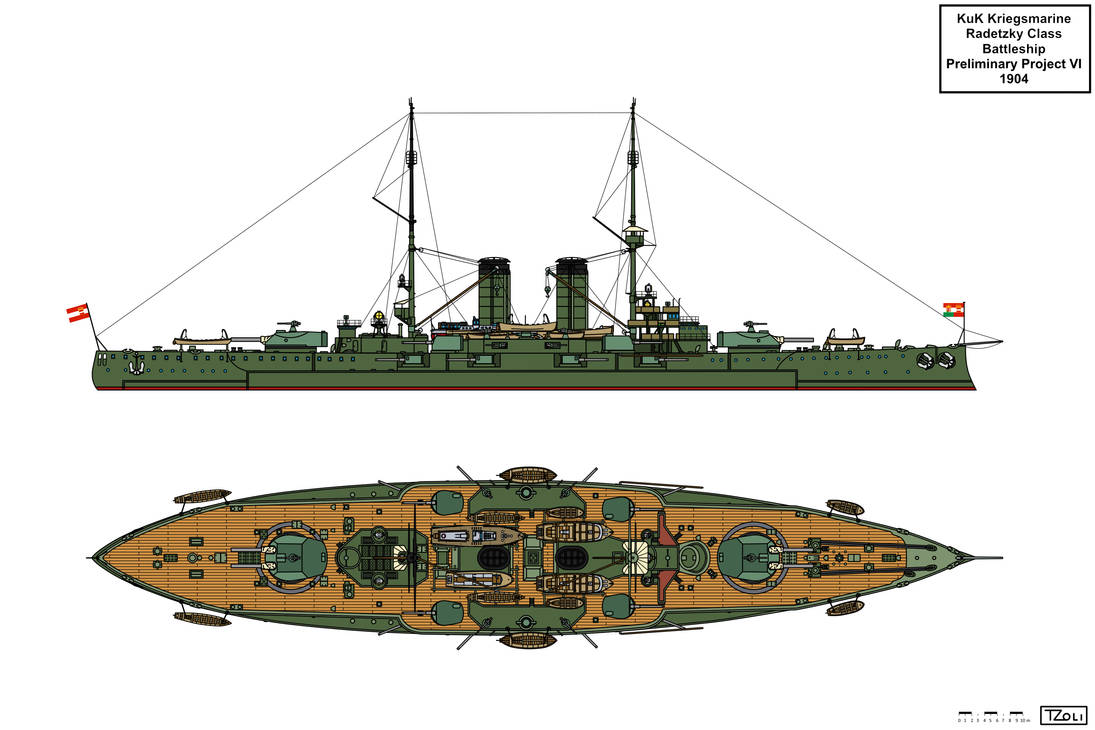
 www.deviantart.com
www.deviantart.com
The final known design of the 1904 series of Radetzky preliminary projects. Possibly to increase redundancy of the secondary armament in case of battle damage, on this project all 19cm Guns were housed in single mounts, 4 in single turrets and the rest in casemates, rather then 8 in twin turrets and 4 in casemates as in the previous design.
After the meeting of 1904. September 19 where the previous 6 projects where discussed a new meeting was held in 1905. February 10 which shows hat there was an almost half year of designing pause was occurred.
On the new meeting Vice-Admiral Franz Freiherr von Minutillo, Rear-Admiral Juliusz Franciszek von Ripper, Captain Julius Beck von Wellstaedt, Admiral Josef Mauler von Elisenau, Rear-Admiral Guido Ritter von Couarde, Captain Lucian Eugenio Ziegler de Lintz-Pozza, head of the MTK and Chief Engineer Friedrich Jedlička were participated.
On this meeting Popper was not present as the subject was not about the design of the warships but their armament. The first topic was about the usage of either the German Krupp Sliding Breech lock or the British Vickers-Maxim Breech lock eg the Welin breech block. There were pros and contrast for either lock but after their discussion the team remained that Krupp Sliding Breach was to be used for the new weapons.
Next topic was the calibre of the main Guns to use either the 28cm (283mm) L/45 calibre Guns or the new 30,5cm L/40 calibre ones.
Among who participated the risen issues were the larger shell wight and the necessary handling equipment the lock system to be used for such large calibre (At that time the largest Sliding Breech Guns were the German 28cm SK L/40 aboard the Braunschweig class battleships), the uncertainty of the new 30,5cm calibre and the positive ability to further develop the larger calibre.
It was also noted that ballistically there were not much difference between the 28cm and 30,5cm Guns despite there were like 100kg difference between their shell weight (345kg for the 28cm and 445 for 30,5cm one)
The committee agreed that it would be wise to use the larger 30,5cm calibre for the new ships and only return to the 28cm one of there were problems developing the new gun. (This discussion was later mirrored in 1908/09 as to to choose between the L/45 and 50 calibre 30,5cm Guns for the Viribus Unitis class when in development) In the end only two, Ziegler and Jedlička supported the 28cm armament, three supported the 28cm armament if there were issues with the development of the 30,5cm and the rest wholeheartedly supported the 30,5cm calibre even if that means changing the Breech Lock technology to the Vickers-Maxims / Welin one.
The design had the following characteristics:
Dimensions: Unknown except the width so I've used the data of the Radetzkys: 137,5m (wl) 138,8m (oa) x 24,0m x 8,1m
Displacement: 12.950tons (standard)
Armour: 40mm Deck, 230mm Belt
Engines: 18.000shp Yarrow Vertical Triple Expansion Engines, 2 Shafts
Speed: 37km/h (20knots)
Range: 7.400km at 18,5km/h (4.000nm at 10knots)
Armaments:
2x2 30,5cm/40 Skoda K05 Cannons
12x1 19cm/42 Skoda K03 Guns
10x1 7cm/50 Skoda K10 Guns
3x1 45cm Underwater Torpedo tubes
The 1905 series:
Project A:

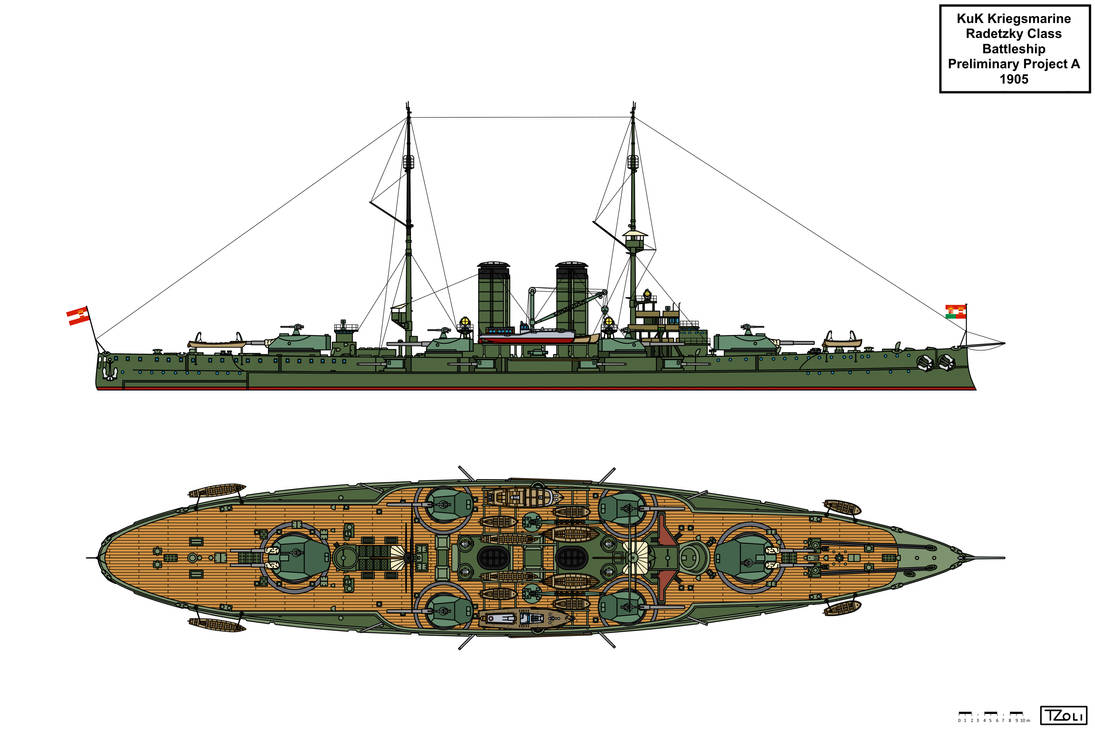
 www.deviantart.com
www.deviantart.com
Here I continue the series of the Radetzky class preliminaries but now from the 1905 series of designs which all feature L/45 calibre Guns (both primary secondary and tertiary) as well as definitive shape of how the final ship going to look like. Though not as armoured as the previous version nor as the final one, the use of larger secondary guns and longer barrels together with thicker turret armour resulted in an increased displacement for these proposals.
After the last meeting in mid February 1905, in late June news were reached the KuK Admirality about the new British Battleship about to be laid down at that time and which was going to be 18.000tons displacement and to be armed with ten 30,5cm Cannons. With this new development and information from the famous battle around a straits between Japan and Korea called Tsushima from Maj 27 meant the new battleships of KUK Kriegsmarine had to be redesigned.
The next meetings was held in 1905. September 25 and 29, lead by Rear-Admiral Juliusz Franciszek von Ripper and participated Admiral Josef Mauler von Elisenau, Captain Lucian Eugenio Ziegler de Lintz-Pozza, Captain Freih Victor von Baselli-Süßenberg, Naval Architect Siegfried Popper and Chief Engineer Friedrich Jedlička.
The topic was the armament of the now increased 13.500tons battleships. Ripper told that after the Russo-Japanese war the battleships should be armed the best and largest calibre weapons the Austro-Hungarian industry eg Skoda could offer. Ziegler noted that it would be not possible to put enough number of long 30,5cm cannons (as used on the Japanese Battleships) on 13.500tons hence the displacement had to be risen to at least 16.000tons which would require a new larger floating dock of which the KuK had already shortage of, of which Mauler was agreed and requested building a new one. Popper agreed with Ripper that a new dock together with the increased costs of the 16.000ton battleships would had been too high so he proposed to stay on 13.500tons of which 4 Guns could be easily mounted which could be supplemented with secondary Guns.
The design had the following characteristics:
Dimensions: Unknown except the width so I've used the data of the Radetzkys: 137,5m (wl) 138,8m (oa) x 24,0m x 8,1m
Displacement: Unknown, probably 12.550tons (standard), 13.650tons (full load)
Armour: 40mm Deck, 210mm Belt
Engines: Unknown, probably 20.000shp Yarrow Vertical Triple Expansion Engines, 2 Shafts
Speed: 38km/h (20,5knots)
Range: 7.400km at 18,5km/h (4.000nm at 10knots)
Armaments:
2x2 28cm/45 (283mm) Skoda K04 Cannons
4x1 24cm/45 (238mm) Skoda K09 Cannons
8x1 19cm/42 Skoda K03 Guns
6x1 7cm/50 (66mm) Skoda K10 Guns
3x1 45cm Underwater Torpedo tubes
The only known sketch series about the 1905 projects:
i.imgur.com/qRaH57v.jpg
Project B:

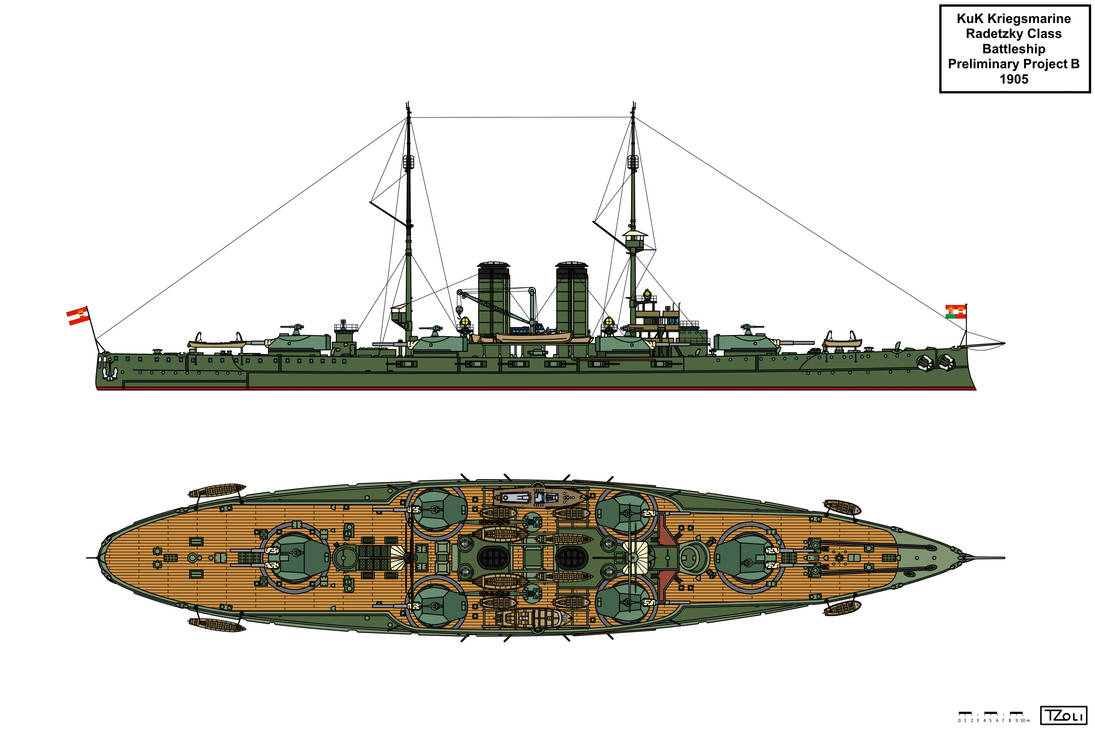
 www.deviantart.com
www.deviantart.com
During the September 25 meeting while the 30,5cm L/45 seemed the best choice for main armament, Chief Engineer Friedrich Jedlička tried to go through with the 28cm main armament as on 13.500tons only four 30,5cm Cannons could be installed without any stronger secondary armament but this hull could accept even eight 28cm in four twin turrets (note that the same armament in the Germany Navy required 15-15.700tons displacement!) which could penetrate 230mm armour at 8.000m. He was the same person who suggested increasing the anti torpedo-boat gun calibre from 7cm (66mm) to 10cm whose semi automatic gun could fire fast enough, has considerable stopping power and has increased range. Ripper applied to the 30,5cm Cannon as it's 100kg heavier shell has more stable trajectory while Mauler empathised the 19cm secondary armament which could devastate the unarmoured parts of a warship. The meeting was ended with most of the participants emphasising the heavier armament.
This Project B shows Jedlička idea for an all 28cm armed battleship in two twin and four single turrets with the anti-torpedo armament of 10cm Guns.
The design had the following characteristics:
Dimensions: Unknown except the width so I've used the data of the Radetzkys: 137,5m (wl) 138,8m (oa) x 24,0m x 8,1m
Displacement: Unknown, probably 13.300tons (standard), 14.400tons (full load)
Armour: 40mm Deck, 210mm Belt
Engines: Unknown, probably 21.000shp Yarrow Vertical Triple Expansion Engines, 2 Shafts
Speed: 38km/h (20,5knots)
Range: 7.400km at 18,5km/h (4.000nm at 10knots)
Armaments:
2x2,4x1 28cm/45 (283mm) Skoda K04 Cannons
12x1 10cm/45 Skoda K07 Guns
6x1 7cm/50 (66mm) Skoda K10 Guns
3x1 45cm Underwater Torpedo tubes
Project C:

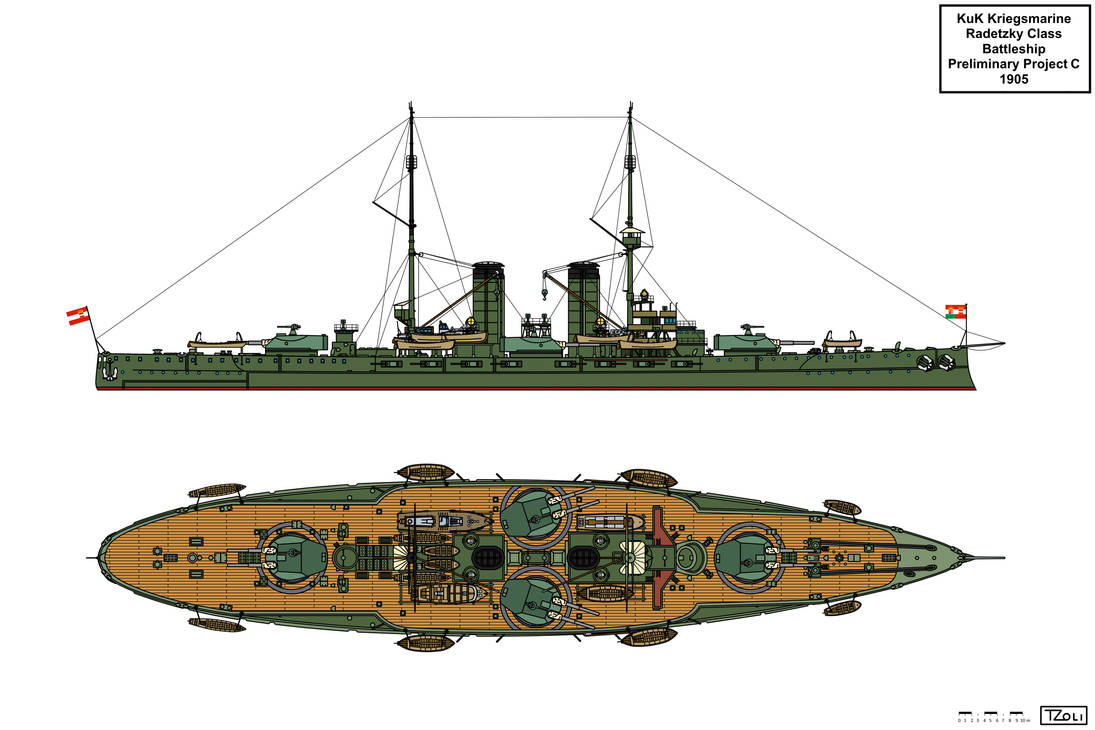
 www.deviantart.com
www.deviantart.com
This version was an improvement over the previous B variant, in so that the 4 single turrets replaced by two twins making a Romboid arrangement rather a hexagonal one. This allowed saving weights which were used to strengthen the secondary armament of 10cm guns to considerable broadside of 8 guns!
This is now basically a dreadnought battleship with all of it's aspects except it was still using reciprocating engines rather then turbines.
As you can see on the original sketch the wing turrets angle of fire was limited, they could not fire directly ahead and abaft due partially because of the blast damage to the superstructure and partially to actually to provide storage space for the ship boats.
These projects (A through E) was offered by Siegfried Popper at the meeting of 1905 September 29. All of these projects for the first time and among the pre and semi-dreadnoughts had equipped with limited anti-torpedo and anti mine defence which was barely enough to protect the ships from such dangers, it shows the forward thinking of the engineers of the KuK Kreigsmarine. Armour wise as I've stated previously all had 210mm belt and 40mm deck but turret armours differed among the various proposals:
A,B had 250mm, C had 230mm and the last two D and E had 280mm.
The design had the following characteristics:
Dimensions: Unknown except the width so I've used the data of the Radetzkys: 137,5m (wl) 138,8m (oa) x 24,0m x 8,1m
Displacement: Unknown, probably 12.950tons (standard), 14.050tons (full load)
Armour: 40mm Deck, 210mm Belt
Engines: Unknown, probably 20.600shp Yarrow Vertical Triple Expansion Engines, 2 Shafts
Speed: 38km/h (20,5knots)
Range: 7.400km at 18,5km/h (4.000nm at 10knots)
Armaments:
4x2 28cm/45 (283mm) Skoda K04 Cannons
16x1 10cm/45 Skoda K07 Guns
4x1 7cm/50 (66mm) Skoda K10 Guns
3x1 45cm Underwater Torpedo tubes
Project D:

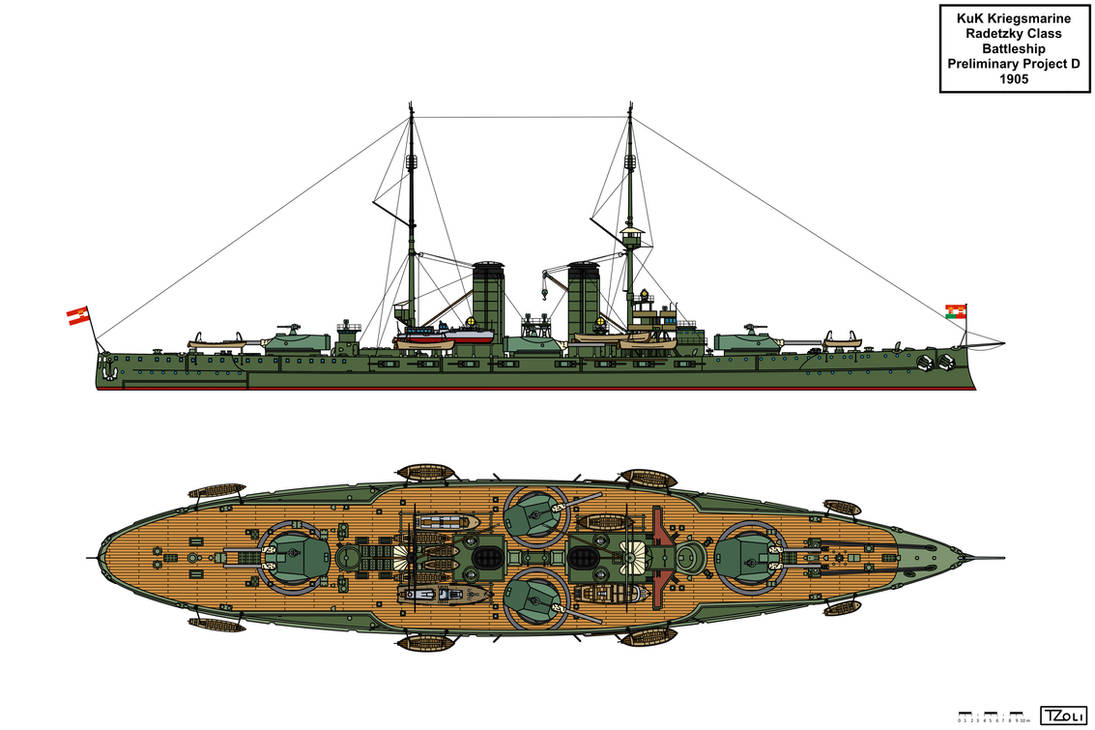
 www.deviantart.com
www.deviantart.com
Project D is basically a modification of the previous C, where all the 28cm turrets got replaced with either twin or single 30,5cm ones making it the smallest dreadnought like battleship if built, smaller then the Spanish Espana and only lack one barrel per broadside and despite it's older engiens it would had been faster as well.
At the 1905 September 29. meeting, after the calibre question was discussed the next topic was the number and arrangement of the primary armament. Friedrich Jedlička, Freih Victor von Baselli-Süßenberg, Siegfried Popper and Lucian Eugenio Ziegler de Lintz-Pozza agreed that the 6x 30,5cm armed version was desirable, though if there were issues with developing the 30,cm cannons at Skoda then the 28cm armed C version. Ziegler added that after the experiences of the battle of Tsushima of that year show that neither the 15 nor even the 20cm Guns were adequate and the new battleships had to carry the largest number and largest heavy guns possible.
The design had the following characteristics:
Dimensions: Unknown except the width so I've used the data of the Radetzkys: 137,5m (wl) 138,8m (oa) x 24,0m x 8,1m
Displacement: Unknown, probably 12.850tons (standard), 13.950tons (full load)
Armour: 40mm Deck, 210mm Belt
Engines: Unknown, probably 20.500shp Yarrow Vertical Triple Expansion Engines, 2 Shafts
Speed: 38km/h (20,5knots)
Range: 7.400km at 18,5km/h (4.000nm at 10knots)
Armaments:
2x2,2x1 30,5cm/45 Skoda K08 Cannons
16x1 10cm/45 Skoda K07 Guns
4x1 7cm/50 (66mm) Skoda K10 Guns
3x1 45cm Underwater Torpedo tubes
Project E:

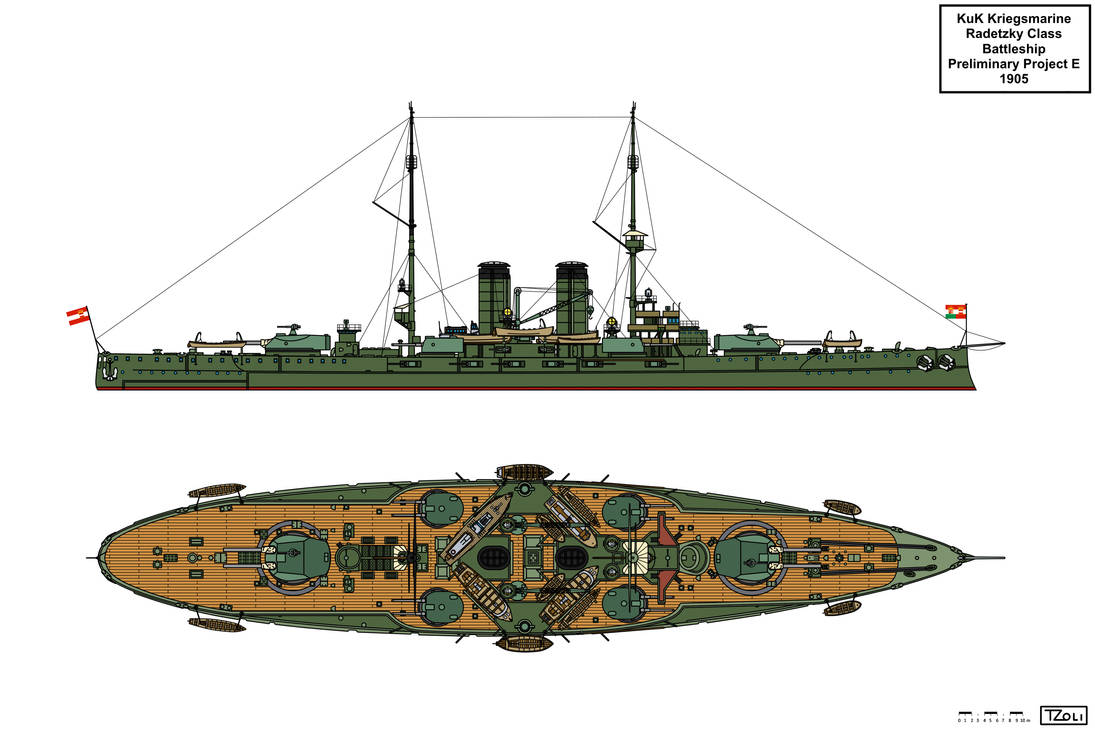
 www.deviantart.com
www.deviantart.com
Project E was the last known proposal of the Radetzky class development series of which I have exact data on armour, armament and it's layout. As you can see it is almost the same as the finished class except the secondary armament being on 19cm's rather 24cm (That was changed later) and the belt armour being thinner at 210mm.
During the 1905 September 29. meeting Josef Mauler insisted on staying with the 19cm secondary armament as these could fire faster and more numerous guns could be mounted which would increase the effective accuracy of the ship and by heavily damaging or destroying the unarmoured parts and upper decks of an enemy ship that would not be able to fight. He voted for the E design and Ripper too agreed with him on this manner.
The next topic was the question of the medium armament. On this matter Ziegler, Baselli, Popper and Jedlička voted for the six 30,5cm armed D variant while Ripper and Mauler gone for variant E with it's four 30,5cm and eight 19cm weaponry. After this Baselli risen the question of the power operations of the turrets which he suggested to be electrically powered which Jedlička too supported saying that the hydraulic system was heavier prone to ice damage and would be more difficult to change it to manual operation. This power sysem was soon accepted and the meeting was ended after a short discussion about the anti-torpedo-boat armament which became the 10cm calibre.
The design had the following characteristics:
Dimensions: Unknown except the width so I've used the data of the Radetzkys: 137,5m (wl) 138,8m (oa) x 24,0m x 8,1m
Displacement: Unknown, probably 13.100tons (standard), 14.200tons (full load)
Armour: 40mm Deck, 210mm Belt
Engines: Unknown, probably 20.800shp Yarrow Vertical Triple Expansion Engines, 2 Shafts
Speed: 38km/h (20,5knots)
Range: 7.400km at 18,5km/h (4.000nm at 10knots)
Armaments:
2x2 30,5cm/45 Skoda K08 Cannons
4x2 19cm/42 Skoda K03 Guns
12x1 10cm/45 Skoda K07 Guns
2x1 7cm/50 (66mm) Skoda K10 Guns
3x1 45cm Underwater Torpedo tubes
And now for contrast the Radetzky Class as built:

I very rarely draw finished ships as they built, only those which I really like (Yamato class) or deem worthy to represent their lineage as in the case here. Here you can see after the numerous preliminary studies to what level the last battleship class before the Viribus Unitis class evolved to. The Radetzky class Semi-Dreadnought battleships of the KuK Kriegsmarine, the fastest battleship class of the Austro-Hungarian navy ever built and also the fastest among it's contemporary classes like the Lord Nelsons and Dantons.
As usual in the Austro-Hungarian Navy, the emperor ( Franz Josef I ) had to choose the naems for the new ships from lists offered to him. The then ordered Battleships I,II,III names at first these were considered at the end of 1908 February as follows:
SMS Admiral Sterneck
SMS Admiral Daun
SMS Admiral Montecuccoli
Then due to the request of the Hungarians for at least one ship to be named from a Hungarian person so next group of names consisted of:
SMS Radetzky
SMS Hunyadi
SMS Prinz Eugen
Finally in March 24th 1908, the final names became as:
SMS Radetzky
SMS Erzherzog Franz Ferdinand
SMS Zrínyi
This concludes the history behind the Radetzky class Battleships.
The class had the following characteristics:
Dimensions: 137,5m (wl) 138,8m (oa) x 24,6m x 8,1m
Displacement: 14.508tons (standard), 15.855tons (full load)
Armour: 48mm Deck, 230mm Belt
Engines: 20.000shp Yarrow Vertical Triple Expansion Engines, 2 Shafts
Speed: 38km/h (20,5knots)
Range: 9.600km at 18,5km/h (5.200nm at 10knots)
Armaments:
2x2 30,5cm/45 Skoda K08 Cannons
4x2 24cm/45 (238mm) Skoda K09 Guns
20x1 10cm/50 Skoda K10 Guns
6x1 7cm/50 (66mm) Skoda K10 Guns
3x1 45cm Underwater Torpedo tubes
So here it is, the capital ship projects of the Kaiserliche und Königliche Kriegsmarine aka the KuK Kriegsmarine or the Austro-Hungarian Navy
Some designs were already posted here:
But now I create a comprehensive thread for them.
I'm sure you will see that quite a few of these designs are excellent and unique.
Let's start with the preliminary designs of the Radetzky class Semi-Dreadnought type battleships!
The 1904 series:
Project I:
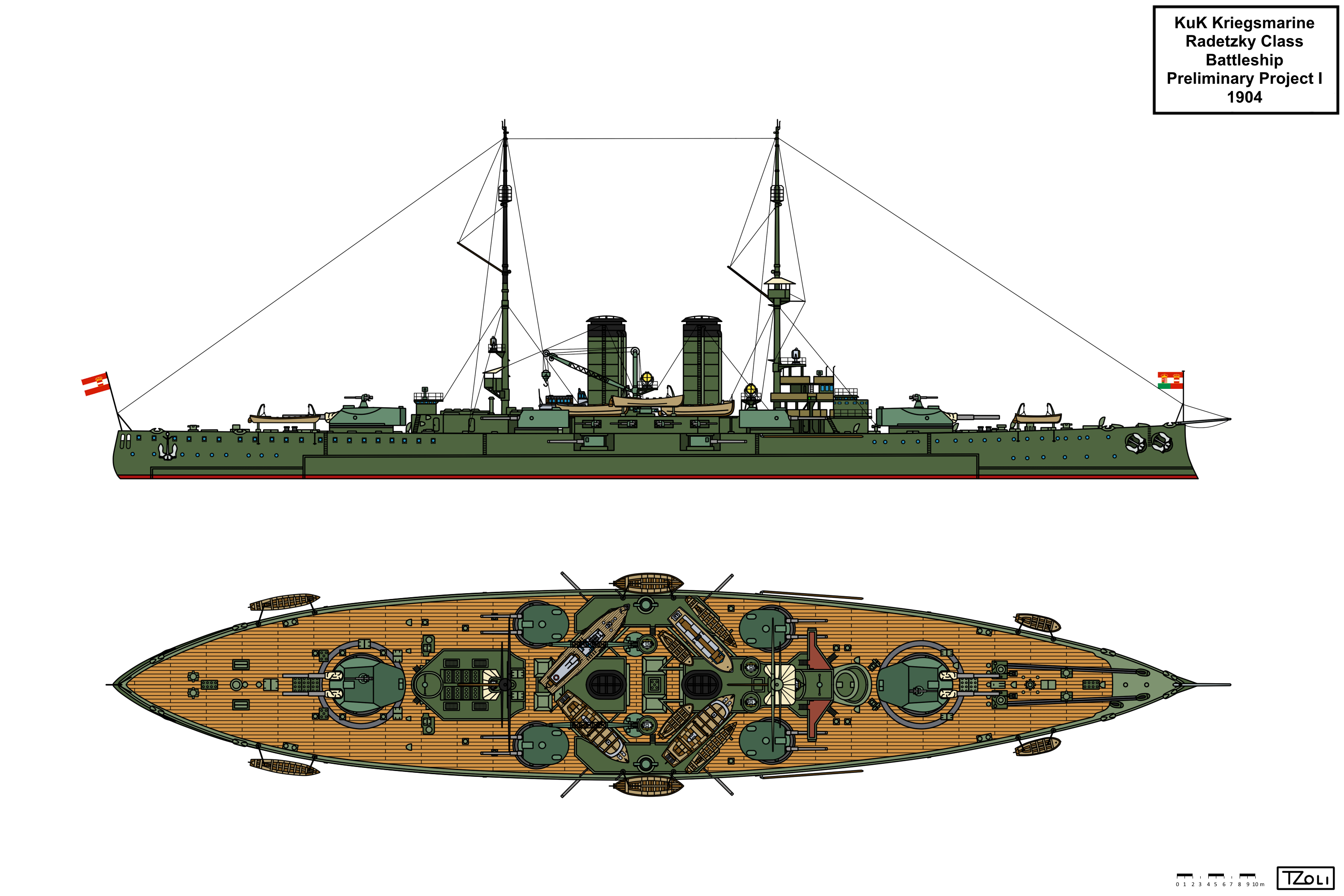

Radetzky Class Preliminary Project I by Tzoli on DeviantArt
The first meeting about a new battleship class was held at 1904, March 15. (almost a year after the launch of SMS Erzherzog Karl) where Admiral Hermann Freiherr von Spaun, Vice-Admiral Rudolf Graf von Montecuccoli degli Erri, Rear-Admiral Juliusz Franciszek von Ripper, Vice-Admiral Franz Freiherr von Minutillo, Rear-Admiral Anton Johann Haus and Naval Architect Siegfried Popper were participated. They decided to begin designing a new battleship class, though the construction could only be started after the current 3 was finished so around 1907 and Popper was instructed to start working on the preliminary studies for the new class.
The next meeting was done at the same year May 18 at Pola where Admiral Spaun noted that the construction could only start in 1907 and now only simple preliminary work was required to determine the hull and armament choices. It was set that the main armament calibre were to be either 30,5cm or 28cm rather 24cm like the previous class and the secodnary armament calibre was set at 19cm. Due to the new development of armour piercing shells the armour too had to be improved, together with this the displacement would rise by some 2.000tons compared to the previous class (10.600tons).
Discussions on placement of armaments was very fluid at this meeting, as the following ideas was emerged:
- 2 single 30,5cm Turrets
- 2 twin 28cm Turrets
- 1 single and twin 30,5cm Turrets
- 1 twin 30,5cm forward, 1 twin 24cm aft Turret
But in the end there were no definite decision was made armament wise.
By the Summer of 1904 MTK (Marinetechnische Komitee - Naval Technical Committee), Pola lead by Siegfried Popper produced six alternative plans. Of the 6 plans only one had 28cm/45 Main Guns (Project I) the rest were carried 30,5cm/40 weapons and none were equipped with 24cm Guns. Secondary armament was uniform 19cm/42 Guns and armour belt was decided on 230mm, with main turrets having 280mm face plates.
So this is the first of the series of Radetzky Preliminaries, the 1904 designs, where I've used the hull shape of the previous Erzherzhog Karl class but enlarged to Radetzky dimensions, two funnels because the wider hull allowed more space for the Boilers, and mixed Radetzky-Erzherzhog style superstructure elements. Added 66mm Anti-Torpedoboat Guns which was the standard calibre of the KuK Kriegsmarine at the time
The design had the following characteristics:
Dimensions: Unknown except the width so I've used the data of the Radetzkys: 137,5m (wl) 138,8m (oa) x 24,0m x 8,1m
Displacement: 12.650tons (standard)
Armour: 40mm Deck, 230mm Belt
Engines: 18.000shp Yarrow Vertical Triple Expansion Engines, 2 Shafts
Speed: 37km/h (20knots)
Range: 7.400km at 18,5km/h (4.000nm at 10knots)
Armaments:
2x2 28cm/45 Skoda K04 Cannons
4x2,4x1 19cm/42 Skoda K03 Guns
10x1 7cm/50 Skoda K10 Guns
3x1 45cm Underwater Torpedo tubes
The only known data table about the 1904 projects:
i.imgur.com/sHhBwgy.jpg
Project II:
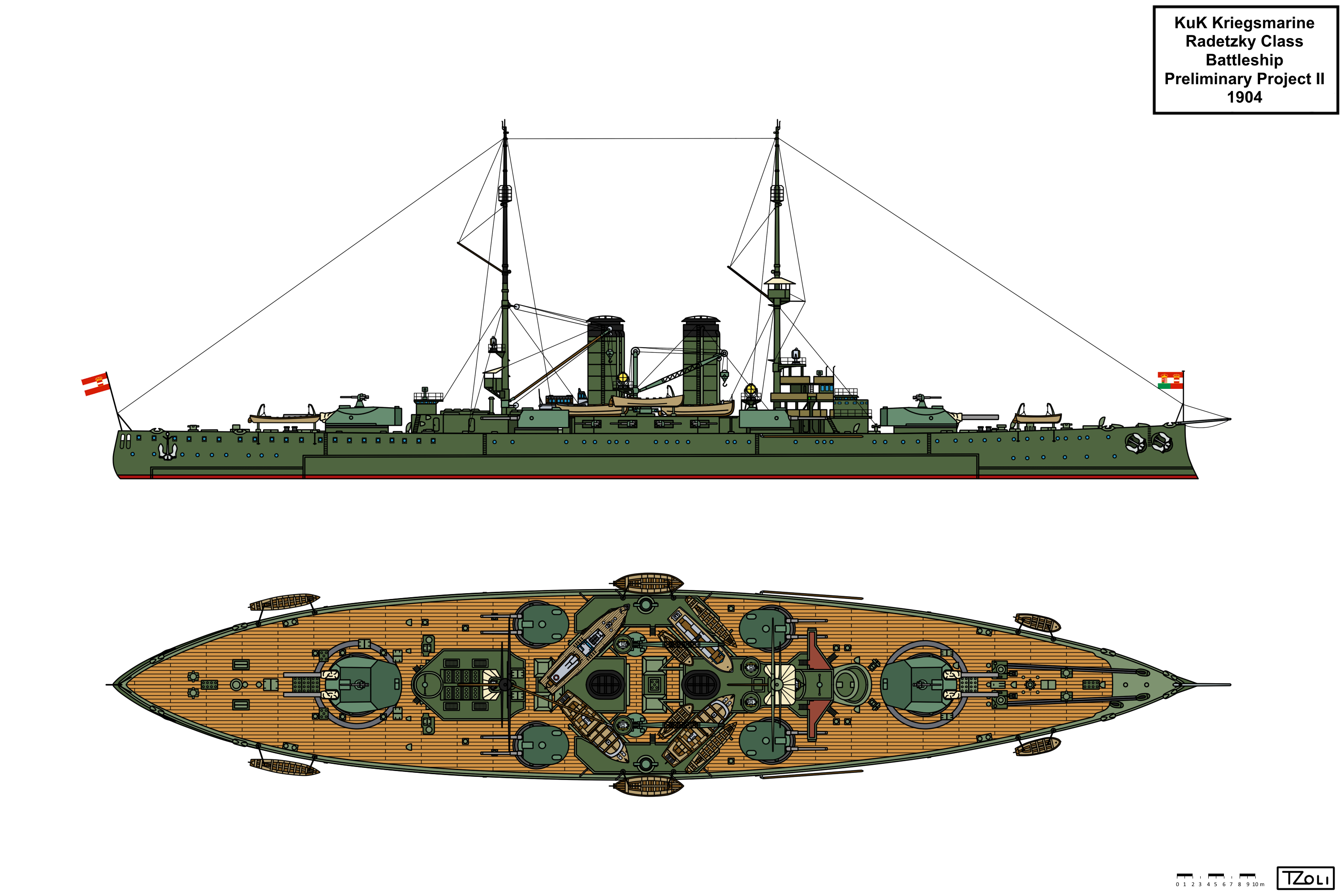

Radetzky Class Preliminary Project II by Tzoli on DeviantArt
Out of the six 1904 series of Pre-Designs, only Project I was equipped with 28cm calibre main guns the rest were all 30,5cm in various numbers, which shows the preference of the larger calibre weapons by Siegfried Popper.
The series shows that Popper and the team of the MTK wished to stay below 13.000tons hence the how the main Guns number increase or decrease the secondary gun numbers accordingly decreases or increases in number accordingly. Here for example 4 casemated 19cm Guns were sacrificed for increasing the main gun calibre to 30,5cm. Another unique about these designs are the introduction of the 30,5cm Guns but not the final 45 calibre ones but a shorter 40 ones which seems consistent of an incremental increase in firepower over the previous class. Also this was the only design to have 19knots speed with 16.000shp engine power to reach it, rather 18.000 of the previous class and 20.000 of the final one.
The design had the following characteristics:
Dimensions: Unknown except the width so I've used the data of the Radetzkys: 137,5m (wl) 138,8m (oa) x 24,0m x 8,1m
Displacement: 12.200tons (standard)
Armour: 40mm Deck, 230mm Belt
Engines: 16.000shp Yarrow Vertical Triple Expansion Engines, 2 Shafts
Speed: 35km/h (19knots)
Range: 7.400km at 18,5km/h (4.000nm at 10knots)
Armaments:
2x2 30,5cm/40 Skoda K05 Cannons
4x2 19cm/42 Skoda K03 Guns
10x1 7cm/50 Skoda K10 Guns
3x1 45cm Underwater Torpedo tubes
Project III:
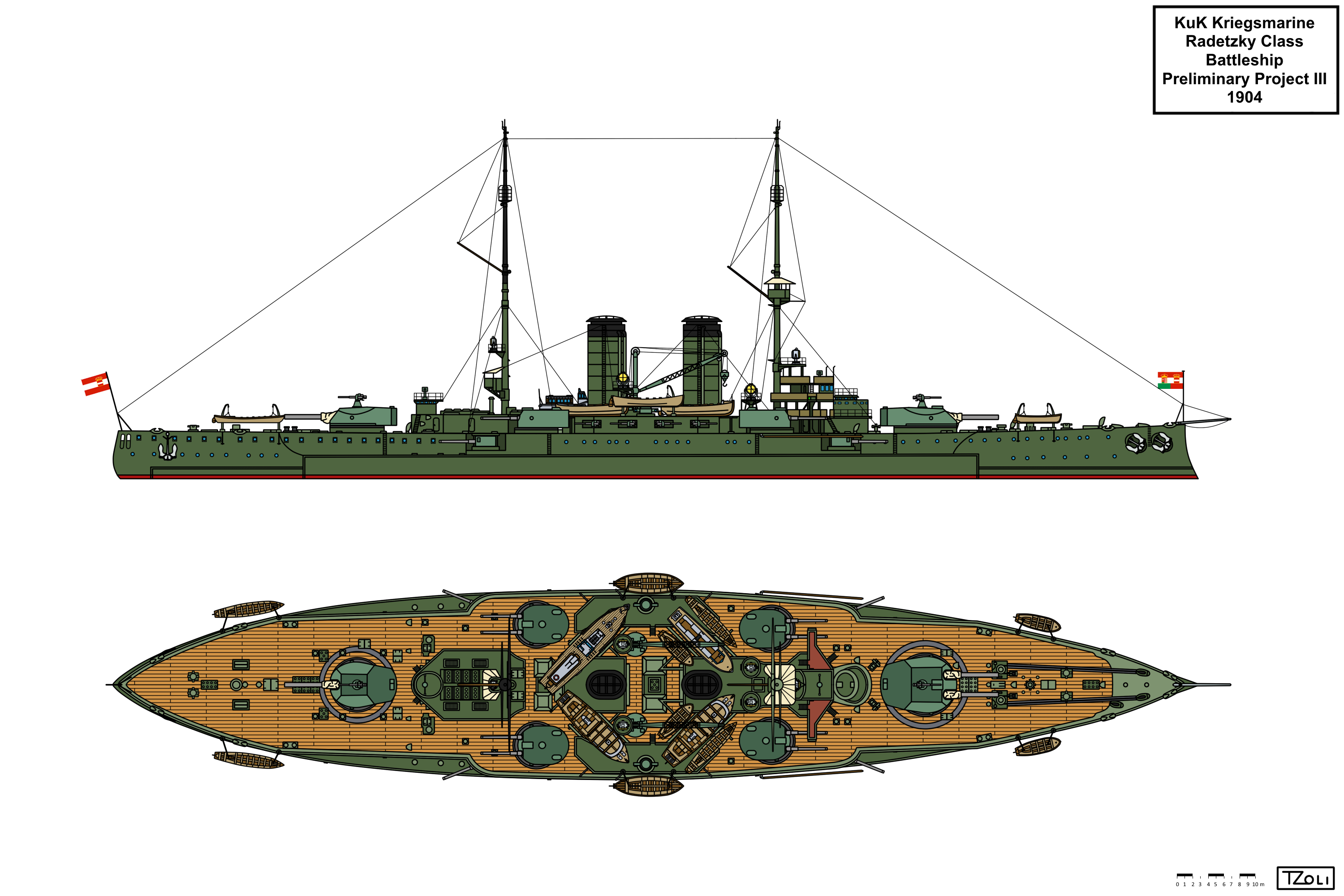

Radetzky Class Preliminary Project III by Tzoli on DeviantArt
In order to maintain the tonnage limit the designers had to sacrafice the armament to increse other aspects of the ship. This time by reducing the number of 30,5cm Cannons from 4 to 3 allowed the increase of the secondary 19cm Gun number from 8 Guns to 12 and a broadside of 4 to 6. This is logical, if you set the a displacement limit and speed to achieve while armour must remain the same, the only thing you can "play" with is the armament, either it's calibre and/or it's number. While this philosophy is evident in every Major Power's navy it is most significant in the the case of the KUK Kriegsmarine which not only have very limited number of shipyards, (2 at the time, both at STT - Stabilimento Tecnico Triestino) and floating docks (none at the time) for construction and service / fitting out but the economical background as well (material and monetary).
The design had the following characteristics:
Dimensions: Unknown except the width so I've used the data of the Radetzkys: 137,5m (wl) 138,8m (oa) x 24,0m x 8,1m
Displacement: 12.650tons (standard)
Armour: 40mm Deck, 230mm Belt
Engines: 18.000shp Yarrow Vertical Triple Expansion Engines, 2 Shafts
Speed: 37km/h (20knots)
Range: 7.400km at 18,5km/h (4.000nm at 10knots)
Armaments:
1x2,1x1 30,5cm/40 Skoda K05 Cannons
4x2,4x1 19cm/42 Skoda K03 Guns
10x1 7cm/50 Skoda K10 Guns
3x1 45cm Underwater Torpedo tubes
Project IV:
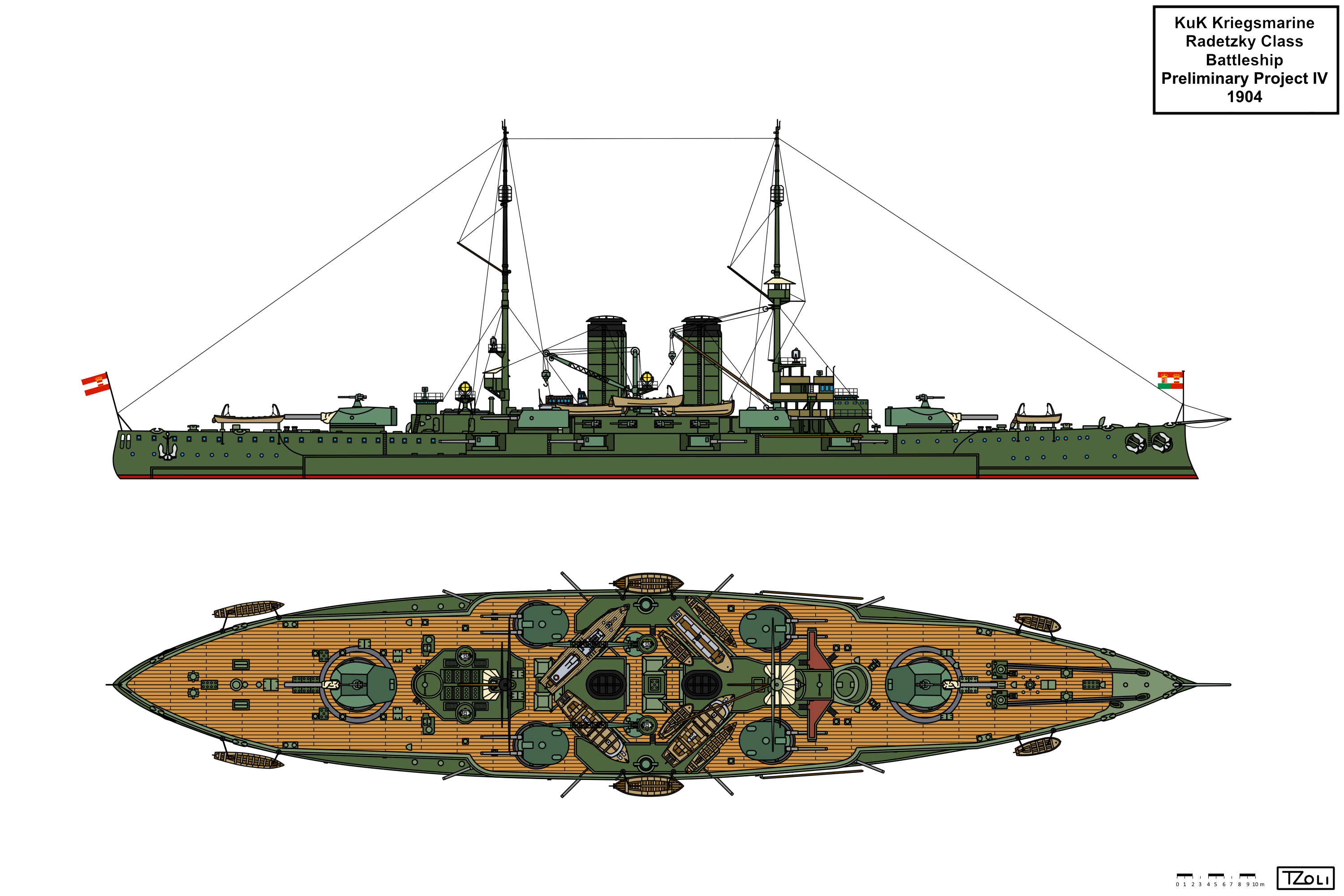

Radetzky Class Preliminary Project IV by Tzoli on DeviantArt
With Project IV Siegfried Popper and the designers of MTK reached the lowest end of primary firepower of a battleship!
By further reducing the gun barrels number to two from three from Project III, but further increasing the secondary 19cm guns number to 16, 8 per side. Basically they made a modern version of the Habsburg class Coastal Defence Battleship with this proposal. With this many 19cm Guns you have much higher chance of sinking a ship with plunging fire then with the main 30,5cm cannons! None the less this is another unique design, probably the least useful for what the KuK Kriegsmarine was needed but shows the options offered for the new battleship class.
The design had the following characteristics:
Dimensions: Unknown except the width so I've used the data of the Radetzkys: 137,5m (wl) 138,8m (oa) x 24,0m x 8,1m
Displacement: 12.650tons (standard)
Armour: 40mm Deck, 230mm Belt
Engines: 18.000shp Yarrow Vertical Triple Expansion Engines, 2 Shafts
Speed: 37km/h (20knots)
Range: 7.400km at 18,5km/h (4.000nm at 10knots)
Armaments:
2x1 30,5cm/40 Skoda K05 Cannons
4x2,8x1 19cm/42 Skoda K03 Guns
10x1 7cm/50 Skoda K10 Guns
3x1 45cm Underwater Torpedo tubes
Project V:
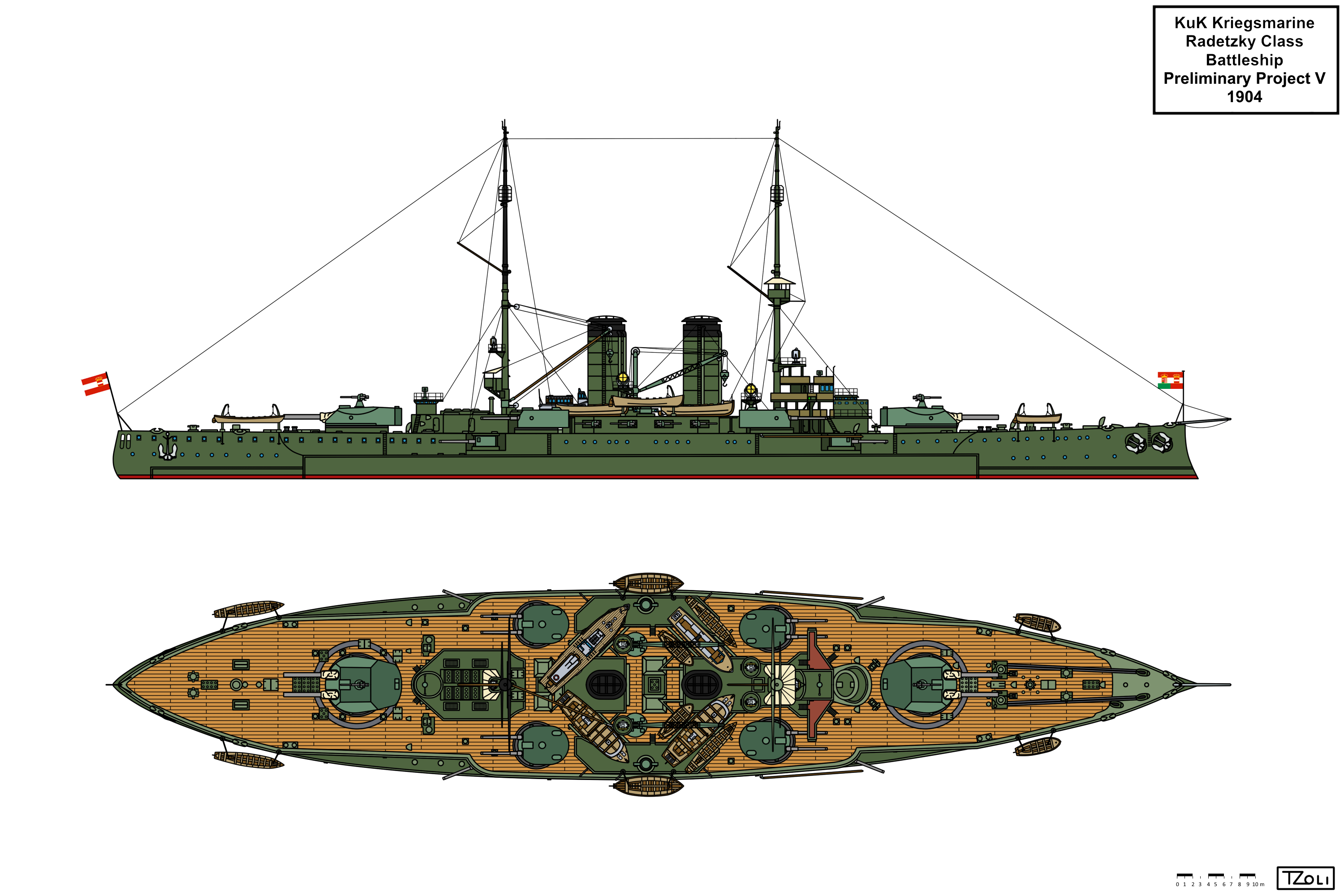

Radetzky Class Preliminary Project V by Tzoli on DeviantArt
The designers decided that the only way to have acceptable secondary firepower (eg at least 6 guns per broadside) and maintain the required main gun firepower of four 30,5cm weapons, was to increase the standard displacement to almost 13.000tons.
Hence the two last designs in the 1904 series were featured increased displacement for two twin 30,5cm and six 19cm Guns per broadside.
Project V combine the main turret layout of Project II and the secondary guns layout of Project III.
The design had the following characteristics:
Dimensions: Unknown except the width so I've used the data of the Radetzkys: 137,5m (wl) 138,8m (oa) x 24,0m x 8,1m
Displacement: 12.950tons (standard)
Armour: 40mm Deck, 230mm Belt
Engines: 18.000shp Yarrow Vertical Triple Expansion Engines, 2 Shafts
Speed: 37km/h (20knots)
Range: 7.400km at 18,5km/h (4.000nm at 10knots)
Armaments:
2x2 30,5cm/40 Skoda K05 Cannons
4x2,4x1 19cm/42 Skoda K03 Guns
10x1 7cm/50 Skoda K10 Guns
3x1 45cm Underwater Torpedo tubes
Project VI:
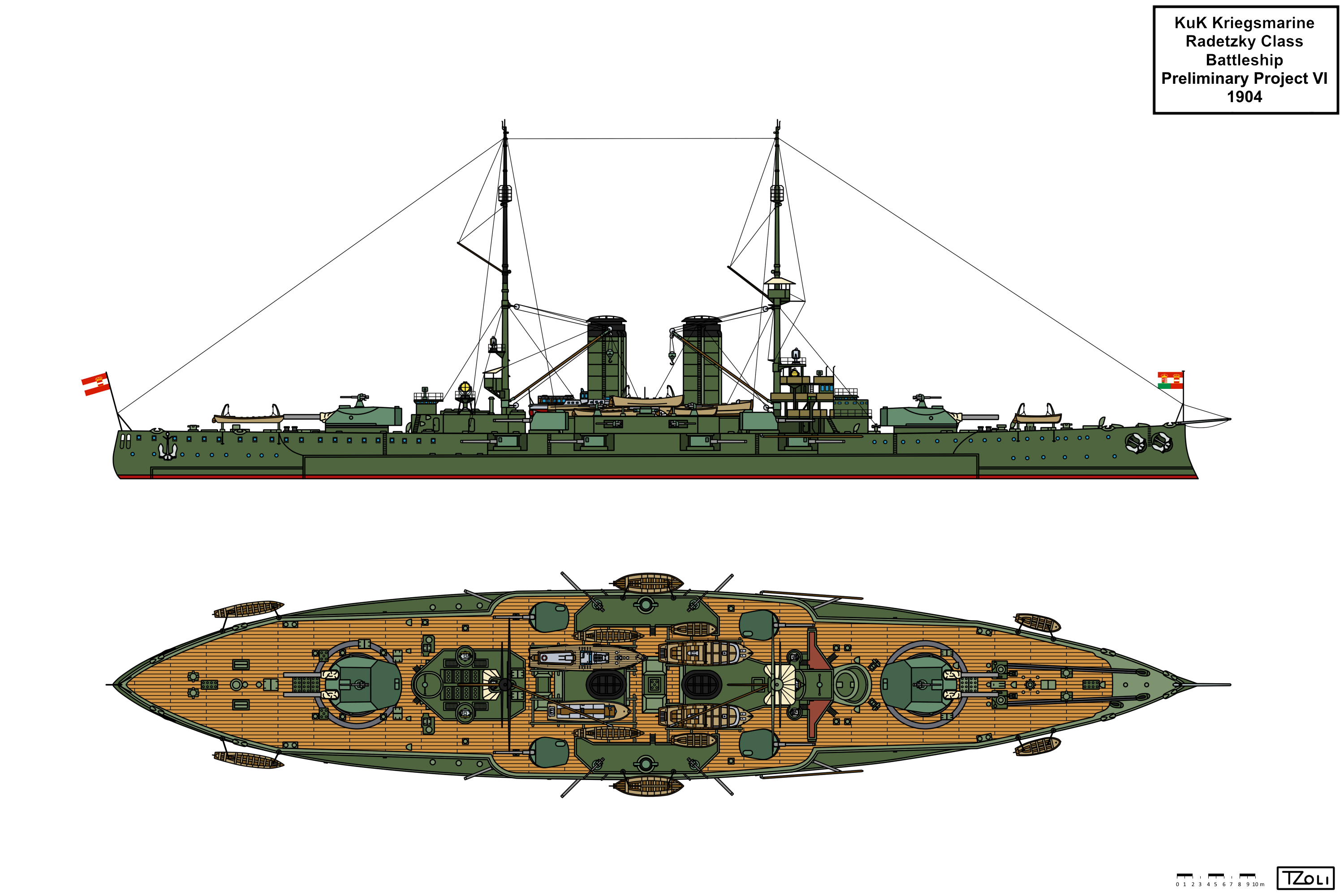

Radetzky Class Preliminary Project VI by Tzoli on DeviantArt
The final known design of the 1904 series of Radetzky preliminary projects. Possibly to increase redundancy of the secondary armament in case of battle damage, on this project all 19cm Guns were housed in single mounts, 4 in single turrets and the rest in casemates, rather then 8 in twin turrets and 4 in casemates as in the previous design.
After the meeting of 1904. September 19 where the previous 6 projects where discussed a new meeting was held in 1905. February 10 which shows hat there was an almost half year of designing pause was occurred.
On the new meeting Vice-Admiral Franz Freiherr von Minutillo, Rear-Admiral Juliusz Franciszek von Ripper, Captain Julius Beck von Wellstaedt, Admiral Josef Mauler von Elisenau, Rear-Admiral Guido Ritter von Couarde, Captain Lucian Eugenio Ziegler de Lintz-Pozza, head of the MTK and Chief Engineer Friedrich Jedlička were participated.
On this meeting Popper was not present as the subject was not about the design of the warships but their armament. The first topic was about the usage of either the German Krupp Sliding Breech lock or the British Vickers-Maxim Breech lock eg the Welin breech block. There were pros and contrast for either lock but after their discussion the team remained that Krupp Sliding Breach was to be used for the new weapons.
Next topic was the calibre of the main Guns to use either the 28cm (283mm) L/45 calibre Guns or the new 30,5cm L/40 calibre ones.
Among who participated the risen issues were the larger shell wight and the necessary handling equipment the lock system to be used for such large calibre (At that time the largest Sliding Breech Guns were the German 28cm SK L/40 aboard the Braunschweig class battleships), the uncertainty of the new 30,5cm calibre and the positive ability to further develop the larger calibre.
It was also noted that ballistically there were not much difference between the 28cm and 30,5cm Guns despite there were like 100kg difference between their shell weight (345kg for the 28cm and 445 for 30,5cm one)
The committee agreed that it would be wise to use the larger 30,5cm calibre for the new ships and only return to the 28cm one of there were problems developing the new gun. (This discussion was later mirrored in 1908/09 as to to choose between the L/45 and 50 calibre 30,5cm Guns for the Viribus Unitis class when in development) In the end only two, Ziegler and Jedlička supported the 28cm armament, three supported the 28cm armament if there were issues with the development of the 30,5cm and the rest wholeheartedly supported the 30,5cm calibre even if that means changing the Breech Lock technology to the Vickers-Maxims / Welin one.
The design had the following characteristics:
Dimensions: Unknown except the width so I've used the data of the Radetzkys: 137,5m (wl) 138,8m (oa) x 24,0m x 8,1m
Displacement: 12.950tons (standard)
Armour: 40mm Deck, 230mm Belt
Engines: 18.000shp Yarrow Vertical Triple Expansion Engines, 2 Shafts
Speed: 37km/h (20knots)
Range: 7.400km at 18,5km/h (4.000nm at 10knots)
Armaments:
2x2 30,5cm/40 Skoda K05 Cannons
12x1 19cm/42 Skoda K03 Guns
10x1 7cm/50 Skoda K10 Guns
3x1 45cm Underwater Torpedo tubes
The 1905 series:
Project A:
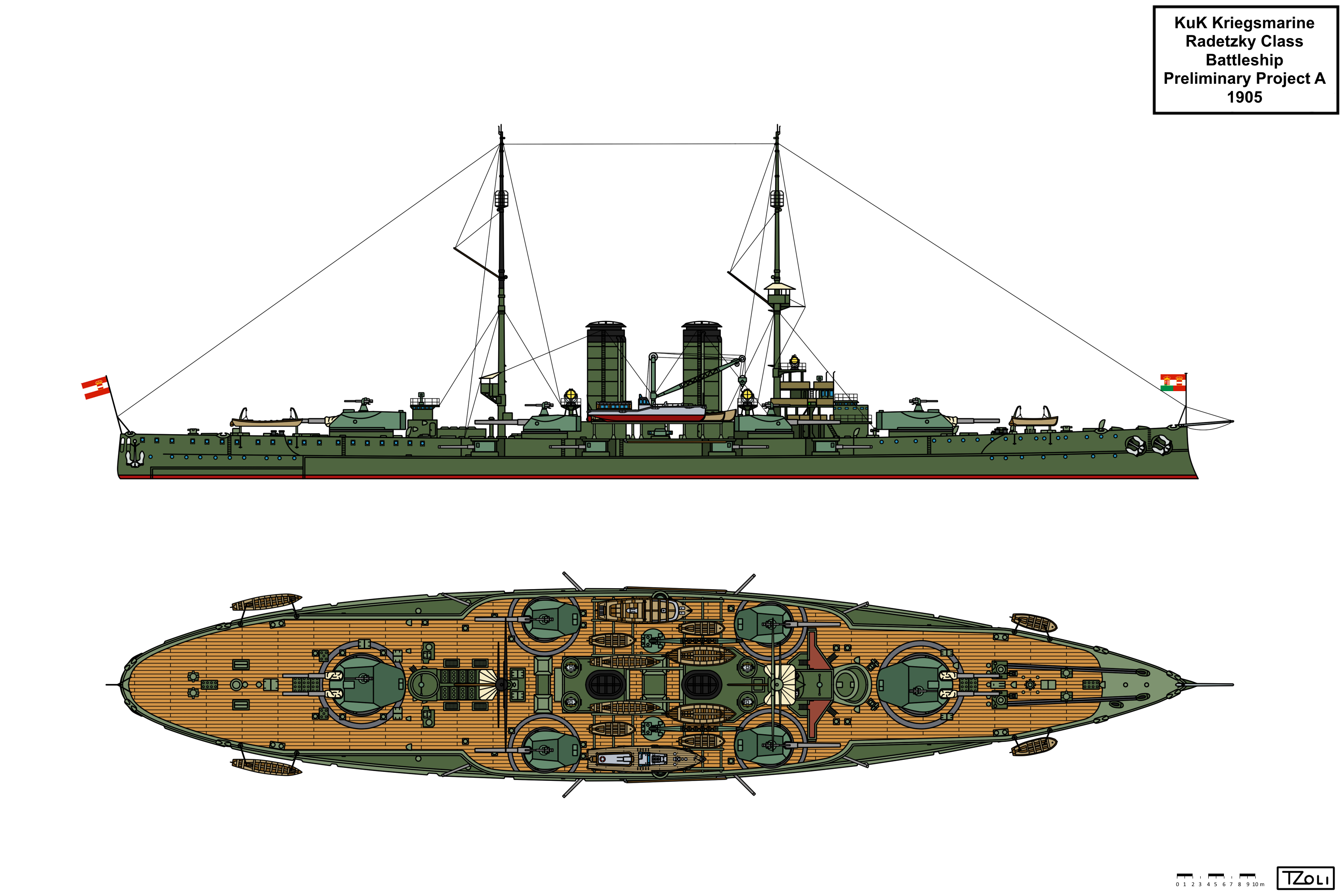

Radetzky Class Preliminary Project A by Tzoli on DeviantArt
Here I continue the series of the Radetzky class preliminaries but now from the 1905 series of designs which all feature L/45 calibre Guns (both primary secondary and tertiary) as well as definitive shape of how the final ship going to look like. Though not as armoured as the previous version nor as the final one, the use of larger secondary guns and longer barrels together with thicker turret armour resulted in an increased displacement for these proposals.
After the last meeting in mid February 1905, in late June news were reached the KuK Admirality about the new British Battleship about to be laid down at that time and which was going to be 18.000tons displacement and to be armed with ten 30,5cm Cannons. With this new development and information from the famous battle around a straits between Japan and Korea called Tsushima from Maj 27 meant the new battleships of KUK Kriegsmarine had to be redesigned.
The next meetings was held in 1905. September 25 and 29, lead by Rear-Admiral Juliusz Franciszek von Ripper and participated Admiral Josef Mauler von Elisenau, Captain Lucian Eugenio Ziegler de Lintz-Pozza, Captain Freih Victor von Baselli-Süßenberg, Naval Architect Siegfried Popper and Chief Engineer Friedrich Jedlička.
The topic was the armament of the now increased 13.500tons battleships. Ripper told that after the Russo-Japanese war the battleships should be armed the best and largest calibre weapons the Austro-Hungarian industry eg Skoda could offer. Ziegler noted that it would be not possible to put enough number of long 30,5cm cannons (as used on the Japanese Battleships) on 13.500tons hence the displacement had to be risen to at least 16.000tons which would require a new larger floating dock of which the KuK had already shortage of, of which Mauler was agreed and requested building a new one. Popper agreed with Ripper that a new dock together with the increased costs of the 16.000ton battleships would had been too high so he proposed to stay on 13.500tons of which 4 Guns could be easily mounted which could be supplemented with secondary Guns.
The design had the following characteristics:
Dimensions: Unknown except the width so I've used the data of the Radetzkys: 137,5m (wl) 138,8m (oa) x 24,0m x 8,1m
Displacement: Unknown, probably 12.550tons (standard), 13.650tons (full load)
Armour: 40mm Deck, 210mm Belt
Engines: Unknown, probably 20.000shp Yarrow Vertical Triple Expansion Engines, 2 Shafts
Speed: 38km/h (20,5knots)
Range: 7.400km at 18,5km/h (4.000nm at 10knots)
Armaments:
2x2 28cm/45 (283mm) Skoda K04 Cannons
4x1 24cm/45 (238mm) Skoda K09 Cannons
8x1 19cm/42 Skoda K03 Guns
6x1 7cm/50 (66mm) Skoda K10 Guns
3x1 45cm Underwater Torpedo tubes
The only known sketch series about the 1905 projects:
i.imgur.com/qRaH57v.jpg
Project B:
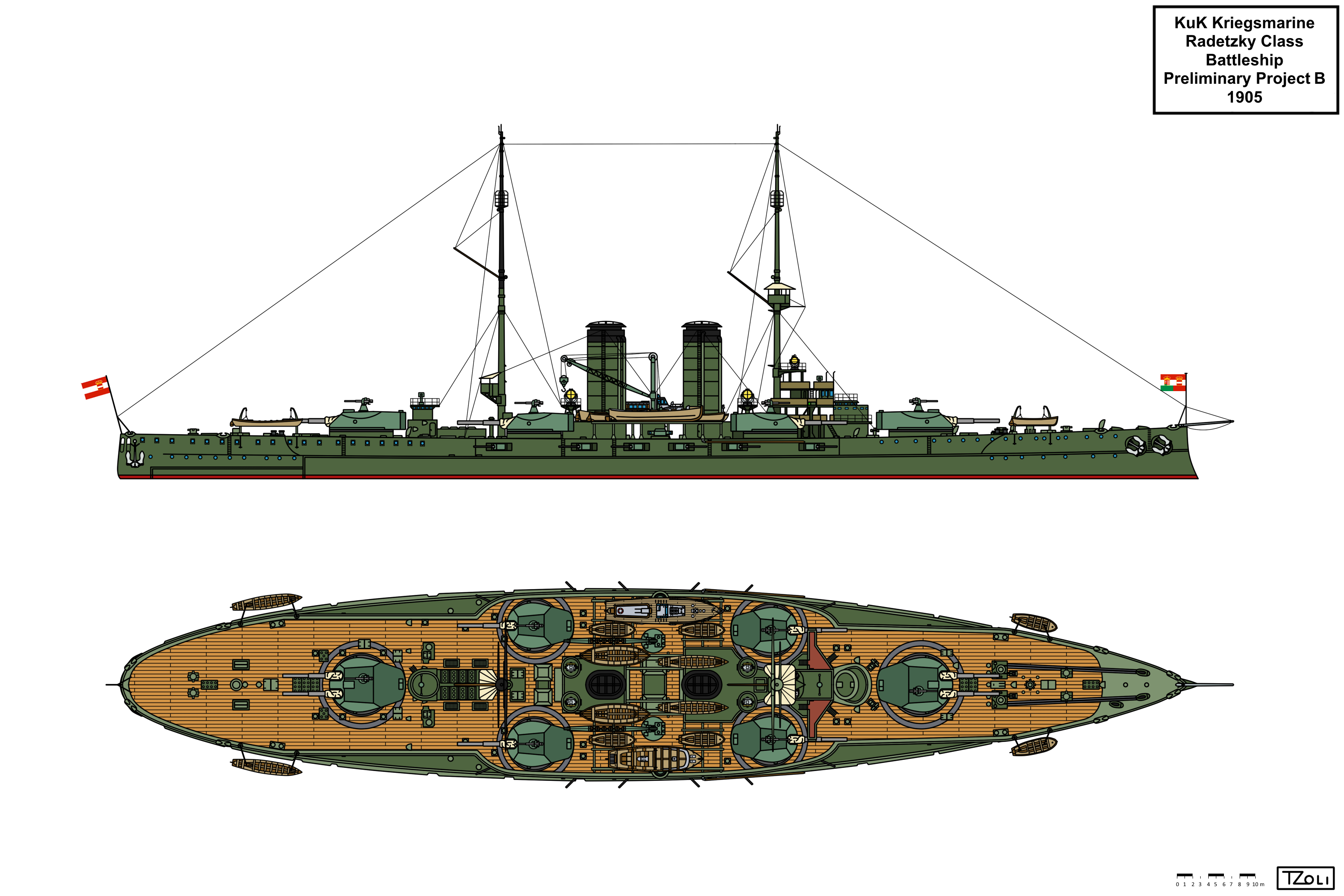

Radetzky Class Preliminary Project B by Tzoli on DeviantArt
During the September 25 meeting while the 30,5cm L/45 seemed the best choice for main armament, Chief Engineer Friedrich Jedlička tried to go through with the 28cm main armament as on 13.500tons only four 30,5cm Cannons could be installed without any stronger secondary armament but this hull could accept even eight 28cm in four twin turrets (note that the same armament in the Germany Navy required 15-15.700tons displacement!) which could penetrate 230mm armour at 8.000m. He was the same person who suggested increasing the anti torpedo-boat gun calibre from 7cm (66mm) to 10cm whose semi automatic gun could fire fast enough, has considerable stopping power and has increased range. Ripper applied to the 30,5cm Cannon as it's 100kg heavier shell has more stable trajectory while Mauler empathised the 19cm secondary armament which could devastate the unarmoured parts of a warship. The meeting was ended with most of the participants emphasising the heavier armament.
This Project B shows Jedlička idea for an all 28cm armed battleship in two twin and four single turrets with the anti-torpedo armament of 10cm Guns.
The design had the following characteristics:
Dimensions: Unknown except the width so I've used the data of the Radetzkys: 137,5m (wl) 138,8m (oa) x 24,0m x 8,1m
Displacement: Unknown, probably 13.300tons (standard), 14.400tons (full load)
Armour: 40mm Deck, 210mm Belt
Engines: Unknown, probably 21.000shp Yarrow Vertical Triple Expansion Engines, 2 Shafts
Speed: 38km/h (20,5knots)
Range: 7.400km at 18,5km/h (4.000nm at 10knots)
Armaments:
2x2,4x1 28cm/45 (283mm) Skoda K04 Cannons
12x1 10cm/45 Skoda K07 Guns
6x1 7cm/50 (66mm) Skoda K10 Guns
3x1 45cm Underwater Torpedo tubes
Project C:
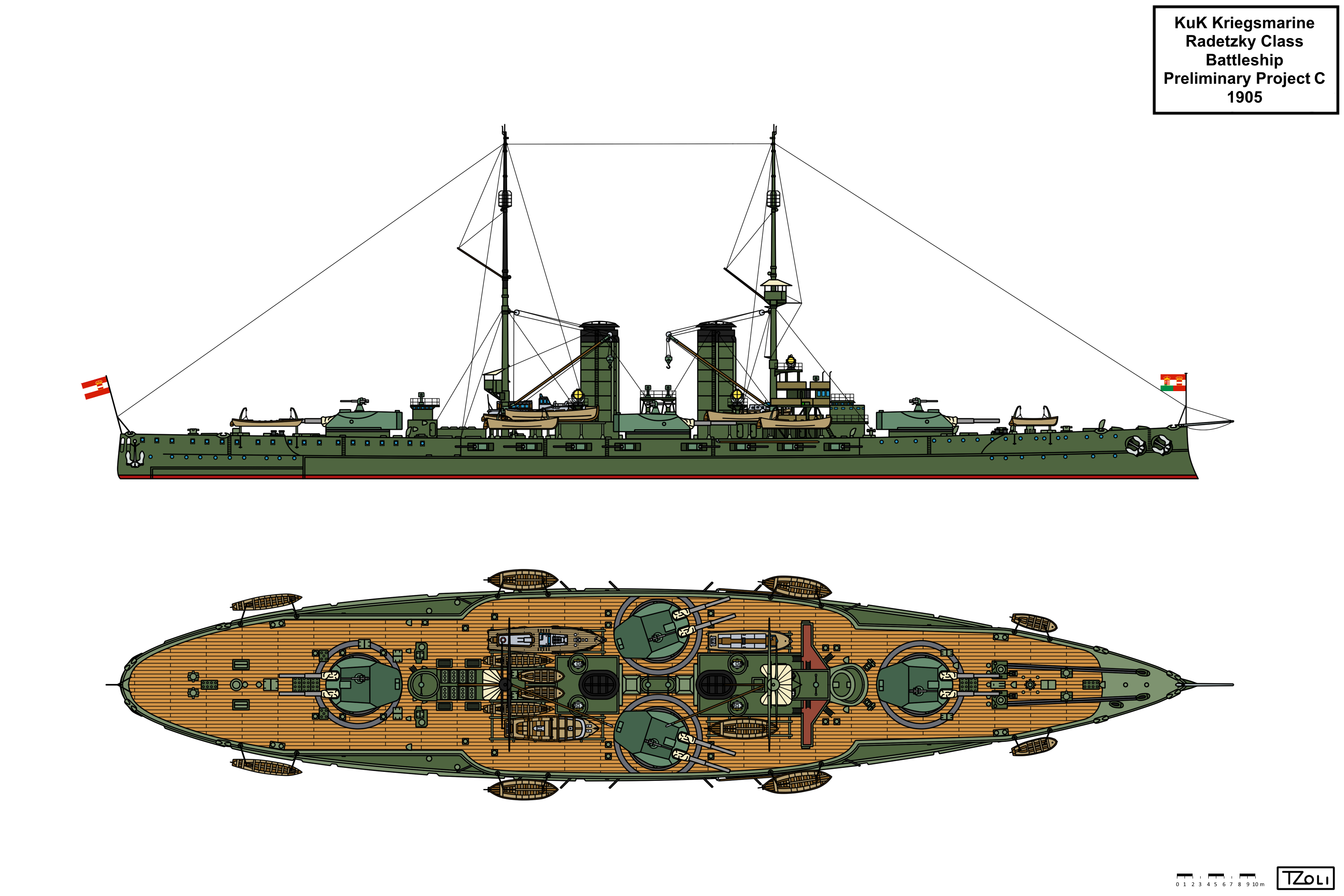

Radetzky Class Preliminary Project C by Tzoli on DeviantArt
This version was an improvement over the previous B variant, in so that the 4 single turrets replaced by two twins making a Romboid arrangement rather a hexagonal one. This allowed saving weights which were used to strengthen the secondary armament of 10cm guns to considerable broadside of 8 guns!
This is now basically a dreadnought battleship with all of it's aspects except it was still using reciprocating engines rather then turbines.
As you can see on the original sketch the wing turrets angle of fire was limited, they could not fire directly ahead and abaft due partially because of the blast damage to the superstructure and partially to actually to provide storage space for the ship boats.
These projects (A through E) was offered by Siegfried Popper at the meeting of 1905 September 29. All of these projects for the first time and among the pre and semi-dreadnoughts had equipped with limited anti-torpedo and anti mine defence which was barely enough to protect the ships from such dangers, it shows the forward thinking of the engineers of the KuK Kreigsmarine. Armour wise as I've stated previously all had 210mm belt and 40mm deck but turret armours differed among the various proposals:
A,B had 250mm, C had 230mm and the last two D and E had 280mm.
The design had the following characteristics:
Dimensions: Unknown except the width so I've used the data of the Radetzkys: 137,5m (wl) 138,8m (oa) x 24,0m x 8,1m
Displacement: Unknown, probably 12.950tons (standard), 14.050tons (full load)
Armour: 40mm Deck, 210mm Belt
Engines: Unknown, probably 20.600shp Yarrow Vertical Triple Expansion Engines, 2 Shafts
Speed: 38km/h (20,5knots)
Range: 7.400km at 18,5km/h (4.000nm at 10knots)
Armaments:
4x2 28cm/45 (283mm) Skoda K04 Cannons
16x1 10cm/45 Skoda K07 Guns
4x1 7cm/50 (66mm) Skoda K10 Guns
3x1 45cm Underwater Torpedo tubes
Project D:
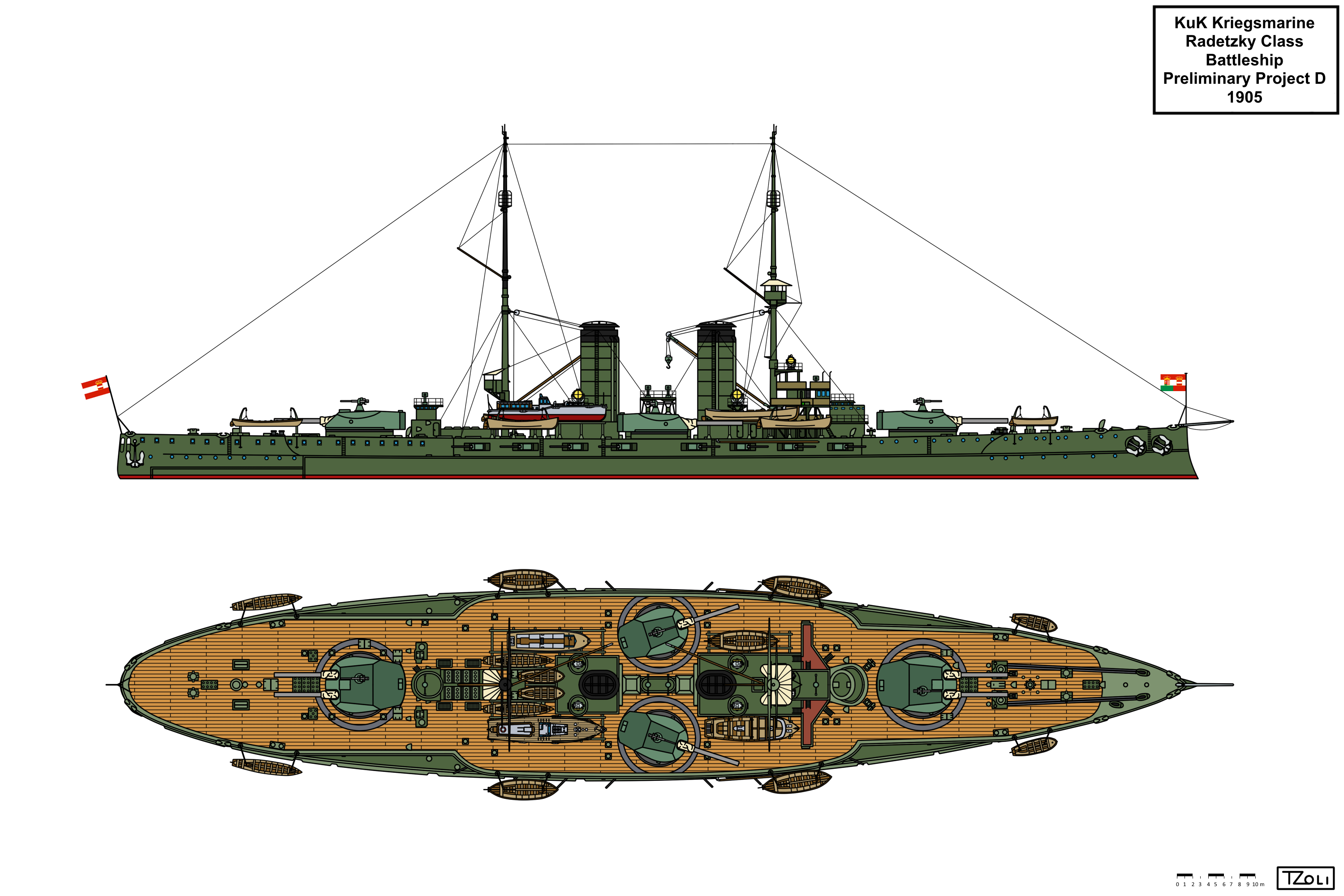

Radetzky Class Preliminary Project D by Tzoli on DeviantArt
Project D is basically a modification of the previous C, where all the 28cm turrets got replaced with either twin or single 30,5cm ones making it the smallest dreadnought like battleship if built, smaller then the Spanish Espana and only lack one barrel per broadside and despite it's older engiens it would had been faster as well.
At the 1905 September 29. meeting, after the calibre question was discussed the next topic was the number and arrangement of the primary armament. Friedrich Jedlička, Freih Victor von Baselli-Süßenberg, Siegfried Popper and Lucian Eugenio Ziegler de Lintz-Pozza agreed that the 6x 30,5cm armed version was desirable, though if there were issues with developing the 30,cm cannons at Skoda then the 28cm armed C version. Ziegler added that after the experiences of the battle of Tsushima of that year show that neither the 15 nor even the 20cm Guns were adequate and the new battleships had to carry the largest number and largest heavy guns possible.
The design had the following characteristics:
Dimensions: Unknown except the width so I've used the data of the Radetzkys: 137,5m (wl) 138,8m (oa) x 24,0m x 8,1m
Displacement: Unknown, probably 12.850tons (standard), 13.950tons (full load)
Armour: 40mm Deck, 210mm Belt
Engines: Unknown, probably 20.500shp Yarrow Vertical Triple Expansion Engines, 2 Shafts
Speed: 38km/h (20,5knots)
Range: 7.400km at 18,5km/h (4.000nm at 10knots)
Armaments:
2x2,2x1 30,5cm/45 Skoda K08 Cannons
16x1 10cm/45 Skoda K07 Guns
4x1 7cm/50 (66mm) Skoda K10 Guns
3x1 45cm Underwater Torpedo tubes
Project E:
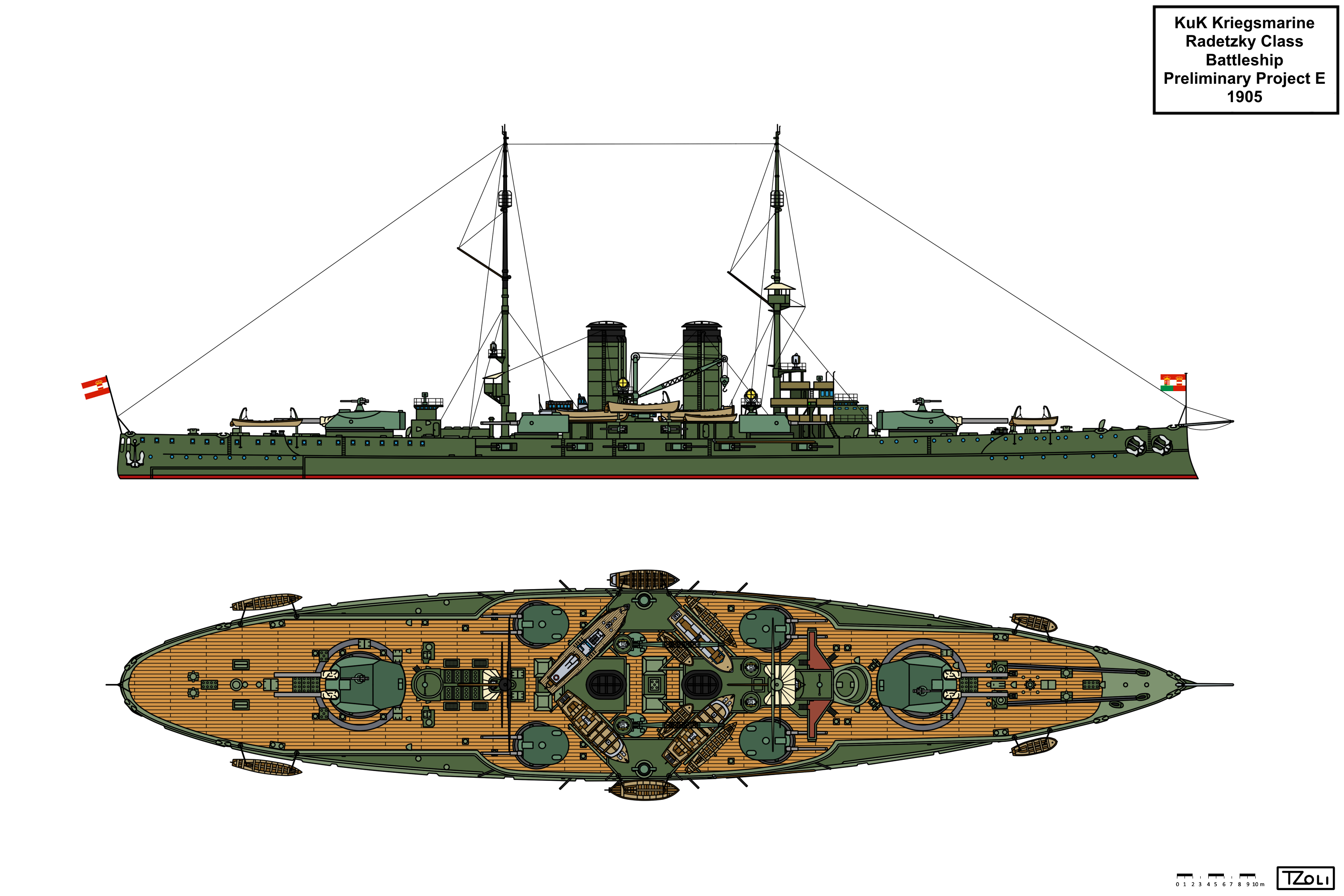

Radetzky Class Preliminary Project E by Tzoli on DeviantArt
Project E was the last known proposal of the Radetzky class development series of which I have exact data on armour, armament and it's layout. As you can see it is almost the same as the finished class except the secondary armament being on 19cm's rather 24cm (That was changed later) and the belt armour being thinner at 210mm.
During the 1905 September 29. meeting Josef Mauler insisted on staying with the 19cm secondary armament as these could fire faster and more numerous guns could be mounted which would increase the effective accuracy of the ship and by heavily damaging or destroying the unarmoured parts and upper decks of an enemy ship that would not be able to fight. He voted for the E design and Ripper too agreed with him on this manner.
The next topic was the question of the medium armament. On this matter Ziegler, Baselli, Popper and Jedlička voted for the six 30,5cm armed D variant while Ripper and Mauler gone for variant E with it's four 30,5cm and eight 19cm weaponry. After this Baselli risen the question of the power operations of the turrets which he suggested to be electrically powered which Jedlička too supported saying that the hydraulic system was heavier prone to ice damage and would be more difficult to change it to manual operation. This power sysem was soon accepted and the meeting was ended after a short discussion about the anti-torpedo-boat armament which became the 10cm calibre.
The design had the following characteristics:
Dimensions: Unknown except the width so I've used the data of the Radetzkys: 137,5m (wl) 138,8m (oa) x 24,0m x 8,1m
Displacement: Unknown, probably 13.100tons (standard), 14.200tons (full load)
Armour: 40mm Deck, 210mm Belt
Engines: Unknown, probably 20.800shp Yarrow Vertical Triple Expansion Engines, 2 Shafts
Speed: 38km/h (20,5knots)
Range: 7.400km at 18,5km/h (4.000nm at 10knots)
Armaments:
2x2 30,5cm/45 Skoda K08 Cannons
4x2 19cm/42 Skoda K03 Guns
12x1 10cm/45 Skoda K07 Guns
2x1 7cm/50 (66mm) Skoda K10 Guns
3x1 45cm Underwater Torpedo tubes
And now for contrast the Radetzky Class as built:
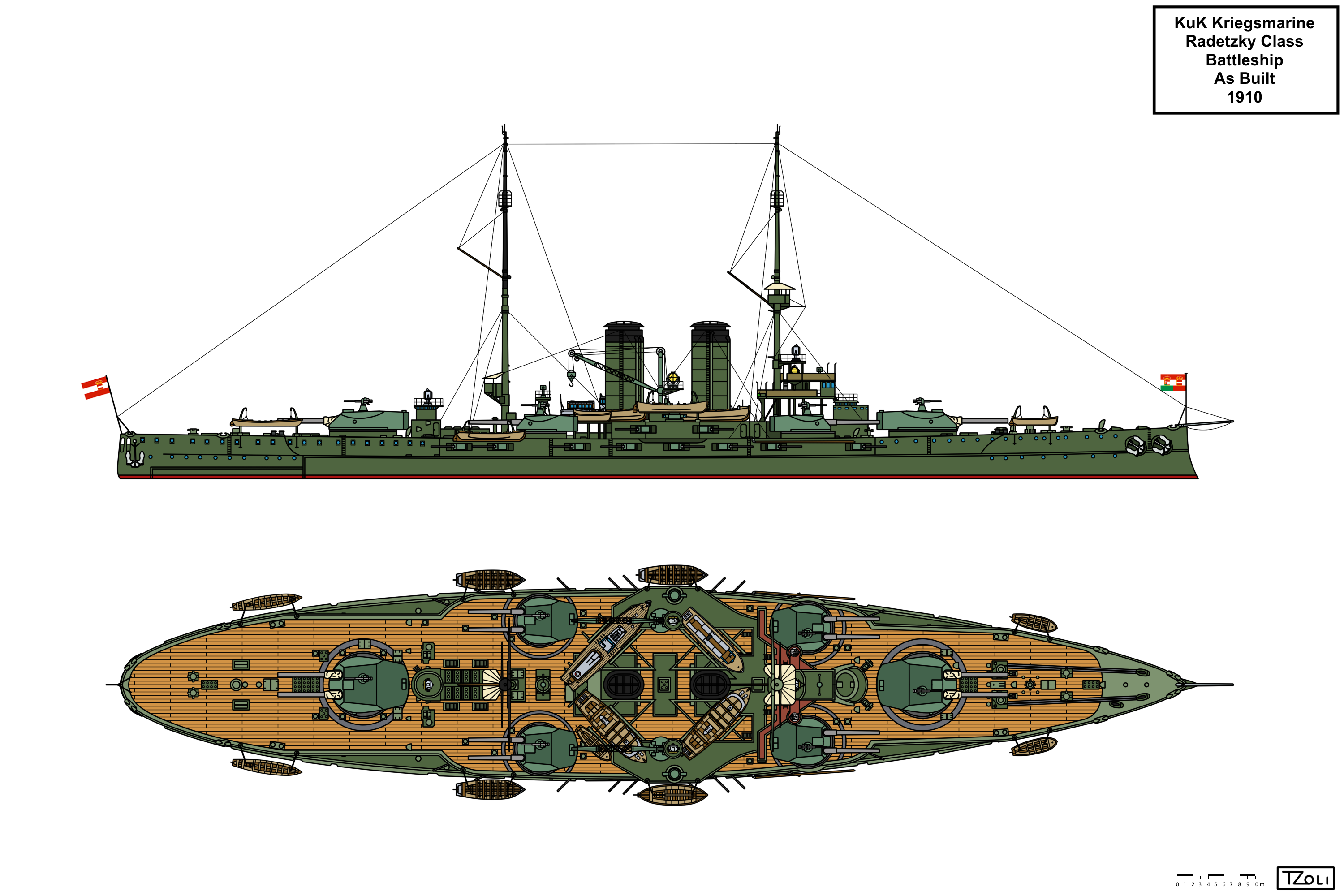
I very rarely draw finished ships as they built, only those which I really like (Yamato class) or deem worthy to represent their lineage as in the case here. Here you can see after the numerous preliminary studies to what level the last battleship class before the Viribus Unitis class evolved to. The Radetzky class Semi-Dreadnought battleships of the KuK Kriegsmarine, the fastest battleship class of the Austro-Hungarian navy ever built and also the fastest among it's contemporary classes like the Lord Nelsons and Dantons.
As usual in the Austro-Hungarian Navy, the emperor ( Franz Josef I ) had to choose the naems for the new ships from lists offered to him. The then ordered Battleships I,II,III names at first these were considered at the end of 1908 February as follows:
SMS Admiral Sterneck
SMS Admiral Daun
SMS Admiral Montecuccoli
Then due to the request of the Hungarians for at least one ship to be named from a Hungarian person so next group of names consisted of:
SMS Radetzky
SMS Hunyadi
SMS Prinz Eugen
Finally in March 24th 1908, the final names became as:
SMS Radetzky
SMS Erzherzog Franz Ferdinand
SMS Zrínyi
This concludes the history behind the Radetzky class Battleships.
The class had the following characteristics:
Dimensions: 137,5m (wl) 138,8m (oa) x 24,6m x 8,1m
Displacement: 14.508tons (standard), 15.855tons (full load)
Armour: 48mm Deck, 230mm Belt
Engines: 20.000shp Yarrow Vertical Triple Expansion Engines, 2 Shafts
Speed: 38km/h (20,5knots)
Range: 9.600km at 18,5km/h (5.200nm at 10knots)
Armaments:
2x2 30,5cm/45 Skoda K08 Cannons
4x2 24cm/45 (238mm) Skoda K09 Guns
20x1 10cm/50 Skoda K10 Guns
6x1 7cm/50 (66mm) Skoda K10 Guns
3x1 45cm Underwater Torpedo tubes

